GRADE CONTROL'S INCREASING POWER DRIVES ADOPTION
AERIAL LIFTS: ELEVATING SAFELY WITH STABILITY
BIG DOZERS
COMPACT EQUIPMENT IS POPULAR, BUT SOMETIMES, YOU NEED A LARGER MACHINE.
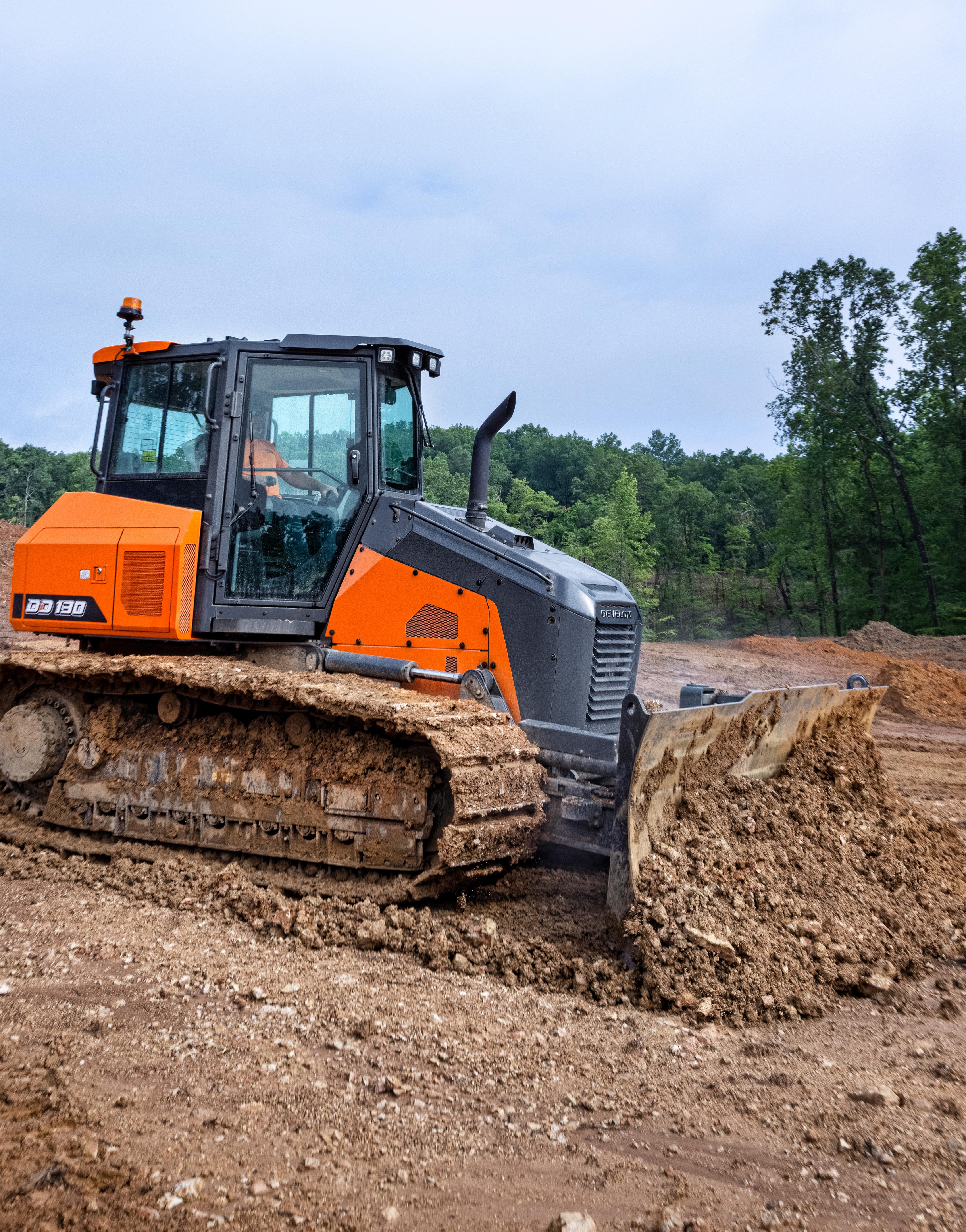
Leaders
READ BONUS ISSUE OF IPAF ELEVATING SAFETY HERE

Helping you optimize ROI on your construction equipment AUGUST 2023
How Tech Boosts Safety: Risk detection improved with new systems
#1 Market
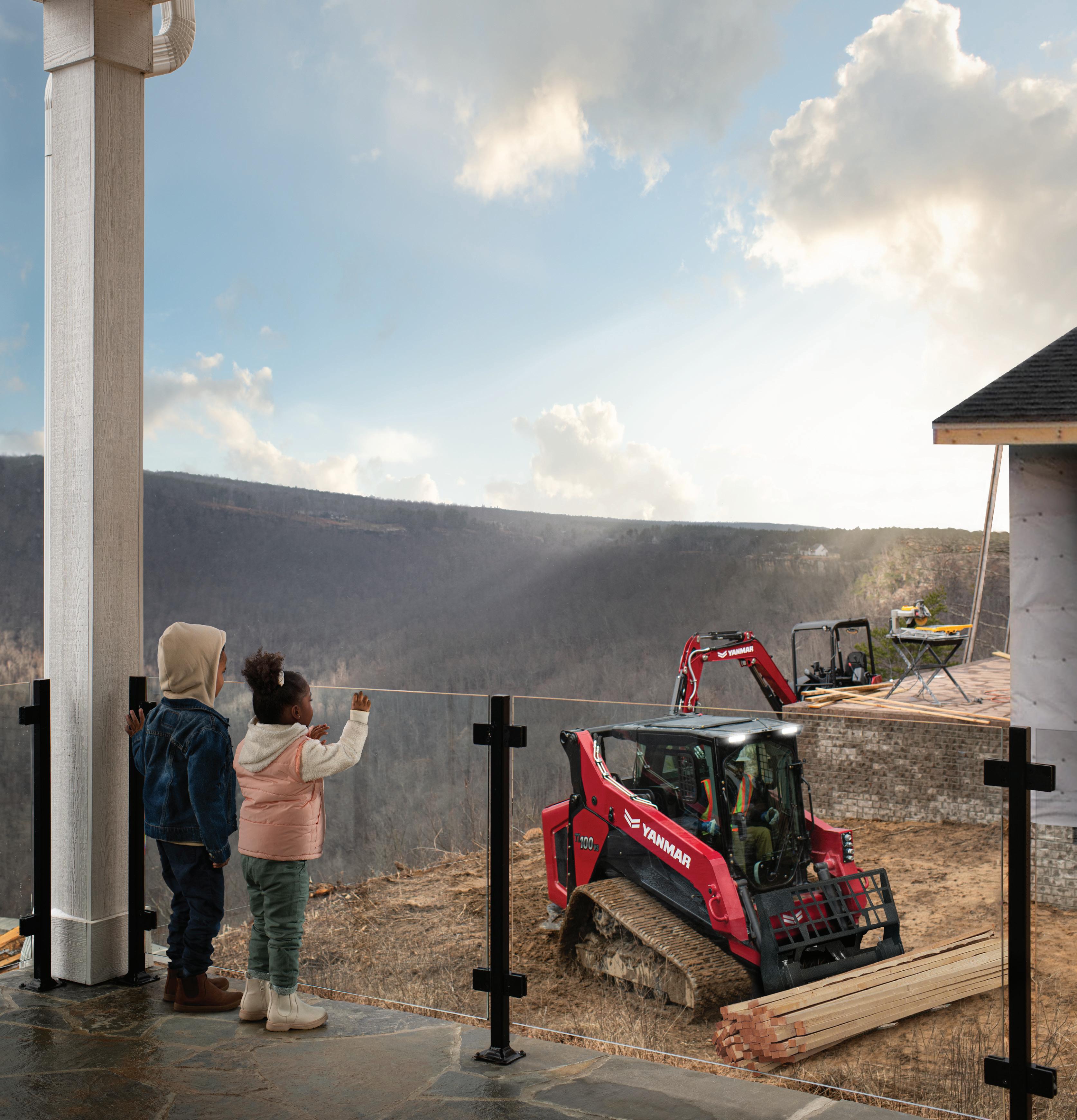
COVER STORY
Big Dozers
Compact equipment is popular, but sometimes, you need a larger machine.




DEPARTMENTS
BREAKING GROUND
Construction Technology Becomes a Focus of Federal Infrastructure Funding Biden-Harris administration to fund digital tech that saves time and money.
EQUIPMENT INTRODUCTIONS
Check Out the Latest Equipment
The latest machines from major manufacturers.
PROFIT MATTERS
Grade Control’s Increasing Power Drives Adoption by Diverse Contractors
A quick overview of how grade control, already indispensable to heavy and civil contractors, is evolving for additional use cases and construction disciplines.
RUNNING THE BUSINESS
Valuing & Selling for Larger Contractors
How companies with more than 25 employees should plan for the future.
BRIDGING THE GAP
Alternative Employee Incentives
For smaller corporations and LLCs, those with relatively fewer employees, incentives like employee ownership can improve retention and engagement.
PRODUCT ROUNDUPS
COMPACT EQUIPMENT
Mini excavators, CTLs, skid steers and more.
FLEET MANAGEMENT
The latest tech for asset management.
LIFT EQUIPMENT
Telehandlers, boom lifts and forklifts.
CONCRETE EQUIPMENT
Screeds, pavers, breakers and more.
TECHNOLOGY PRODUCTS
Technology advancements for the industry.
FEATURES
COMPACT EQUIPMENT
Compact Excavators for Tight, Urban Construction Sites

By using these machines, operators can enhance their productivity as sites’ sizes continue to decrease.
FLEET MANAGEMENT
Non-CDL Lube Trucks Address Labor & Jobsite Maneuverability Challenges

Finding drivers and navigating tight urban jobsites require an innovative approach.
LIFT EQUIPMENT
Aerial Lifts: Elevating Safely With Stability
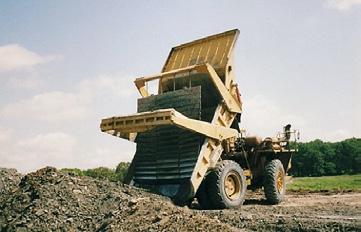
New ANSI regulations and technology make scissor lifts and boom lifts even safer.
LIFT EQUIPMENT
IPAF Talks Lift Equipment Safety & Certifications
Learn some scissor lift and boom lift safety basics from this Q&A.

CONCRETE EQUIPMENT
Surface Prepping Blades: Which Tool Is Best?
How the right blade tool choice impacts floor removal rates.

CONCRETE EQUIPMENT
Exploring Concrete Screed Options
For concrete contractors, there are few purchases more essential than a screed.

TECHNOLOGY
How Tech Elevates Safety
Technology transformations improve safe operations on construction sites

WEB EXCLUSIVES
VIDEO NETWORK https://eqtoday.co/k2p285
DIGGING DEEPER PODCAST https://eqtoday.co/s7sfkm
CONTENT https://eqtoday.co/9pd73s
July 2023 | EQUIPMENT TODAY 3 www.ForConstructionPros.com/Equipment Contents www.forconstructionpros.com/equipment August 2023 | Vol. 59 No. 8 Published and copyrighted 2023 by AC Business Media Equipment Today makes every effort to report manufacturers’ product news accurately, but is not responsible for validity of news claims. All rights reserved. No part of this publication may be reproduced or transmitted in any form or by any means, electronic or mechanical, including photocopy, recording or any information storage or retrieval system, without written permission from the publisher. SUBSCRIPTION POLICY: Individual subscriptions are available without charge in the U.S. and Canada to management, engineering, supervisory, equipment maintenance and other personnel who have buying influence in the construction equipment industry. Subscribe online at www.ForConstructionPros. com. Publisher reserves the right to reject non-qualified subscribers. One year subscription to non-qualified individuals: U.S. $50; Canada/Mexico $70; all other countries $100 (payable in U.S. funds, drawn on U.S. bank). Single copies available (prepaid only) $10.00 each (U.S., Canada & Mexico), $15.00 each (International). For change of address or subscription information call (847) 559-7598 or fax (847) 291-4816. Equipment Today (USPS 369-290, ISSN 0891141X) is published is published 12x with issues of January, February, March, April, May, June, July, August, September, October, November and December by AC Business Media, 201 N. Main St., Fort Atkinson, WI 53538. Periodicals postage paid at Fort Atkinson, WI, and additional entry offices. POSTMASTER: Please send change of address to Equipment Today, PO Box 3605, Northbrook, IL 60065-3605. Printed in the USA. Canada Post PM40612608. Return Undeliverable Canadian Addresses to: Equipment Today, PO Box 25542, London, ON N6C 6B2. PREMIUM
4 6
48 50
18 22 32 37 42
10
12
20 24 30 33 34 40
44
®
Lori Ditoro Editor-in-Chief
Equipment Today
lditoro@ACBusinessmedia.com
ungvar, Adobe Stock
For decades, experts have encouraged construction contractors to embrace technology to improve equipment operation, fleet management and business operations. While adoption has progressed, that progress has been slow. Now, the federal government is giving contractors financial incentives to speed adoption.
In a June 27, 2023, press release, the U.S. Department of Transportation’s Federal Highway Administration (FHWA) announced that the application period is open for the first year of a new, $85-million grant program under President Biden’s Bipartisan Infrastructure Law.
The Advanced Digital Construction Management Systems (ADCMS) grant program will focus on digital construction, such as computer modeling and 3D design, to encourage modern best practices in project delivery. It complements Biden’s Investing in America agenda that is rebuilding U.S. infrastructure.
“Technology has transformed many facets of life in the modern era, and we want the transportation construction industry to take advantage of these advancements to deliver projects on time and on budget,” said Federal Highway Administrator Shailen Bhatt.

“These technologies, along with funding from President Biden’s Bipartisan Infrastructure Law, will help us more quickly deliver the transportation system of the 21st century.”
At the one-year mark (November 2022), key highlights of the Bipartisan Infrastructure Law include:
˜ Launched 2,800 bridge repair and replacement projects across the country
˜ Awarded funds for over 5,000 new clean transit and school buses
˜ Approved state plans for water funding, electric vehicle charging networks and high-speed internet deployment
ADCMS Program Goals
The $85 million competitive grant program will help accelerate project delivery. The ADCMS program is one aspect of FHWA’s multifaceted Technology and Innovation Deployment Program and provides funding as an incentive for state departments of transportation. It promotes access to more meaningful, accurate and easy-to-use data by construction professionals with enhanced software modeling tools and features. Better and more consistent modeling allows the seamless sharing of design and construction plans. The program goals include:
˜ Accelerated adoption of advanced digital construction management systems to boost productivity and manage complex projects
˜ More timely and productive information-sharing
˜ The development and deployment of best practices
˜ Increased transparency from real-time data sharing
Grant Award Schedule
The ADCMS grant program will award up to $34 million for combined Fiscal Years 2022 and 2023 and up to $17 million each fiscal year thereafter through Fiscal Year 2026. The funding will focus on projects that promote information-sharing, reduce reliance on paper, improve productivity and savings during project delivery, and serve as models for the adoption and deployment of digital construction technologies. While state departments of transportation, the District of Columbia and Puerto Rico are eligible to apply, they are encouraged to partner with local governments, tribes and private industry when designing their proposed projects.
Is your company taking advantage of the money from the Bipartisan Infrastructure Law? If so, email me and tell us what you’re doing.
EDITORIAL
Editor-in-Chief Lori Ditoro lditoro@acbusinessmedia.com
Managing Editor Gigi Wood gwood@acbusinessmedia.com
Senior Editor, Construction Technology, IRONPROS Charles Rathmann crathmann@acbusinessmedia.com
Senior Editor, Equipment & Workwear, IRONPROS Michael Cheng mcheng@acbusinessmedia.com

AUDIENCE
Audience Development Manager Angela Franks
PRODUCTION
Senior Production Manger Cindy Rusch crusch@acbusinessmedia.com

Art Director April Van Etten
ADVERTISING/SALES
Brand Director Sean Dunphy sdunphy@acbusinessmedia.com

Assoc. Brand Director Nikki Lawson nlawson@acbusinessmedia.com
Sales Representative Kris Flitcroft kflitcroft@acbusinessmedia.com
Sales Representative Tadashi Soma tsoma@acbusinessmedia.com
Sales Representative Kristin Pride kpride@acbusinessmedia.com
Sales Representative Megan Perleberg mperleberg@acbusinessmedia.com
Sales Representative Greg Schulz gschulz@acbusinessmedia.com
AC BUSINESS MEDIA
Chief Executive Officer Ron Spink
Chief Financial Officer JoAnn Breuchel
Chief Revenue Officer Amy Schwandt
Brand Director, Supply Chain & Green Industry Jason DeSarle
Brand Director, Construction Sean Dunphy
VP, Audience Development Ronda Hughes
VP, Operations & IT Nick Raether
Content Director Marina Mayer
Director, Online & Marketing Services Bethany Chambers
Content Marketing, Marketing Services Jess Lombardo
Director, Demand Generation & Education Jim Bagan
CIRCULATION & SUBSCRIPTIONS
PO Box 3605 Northbrook, IL 60065-3605, Phone: (877) 201-3915 Fax: (847)-291-4816 circ.EquipmentToday@omeda.com
LIST RENTAL
Sr. Account Manager Bart Piccirillo, Data Axle 402-836-2768 | bart.piccirillo@data-axle.com
REPRINTS & LICENSING
E@EquipmentToday
D@EquipmentToday
C @equipment-today-magazine-official
Q @equipmenttoday
4 EQUIPMENT TODAY | August 2023 www.ForConstructionPros.com/Equipment BREAKING GROUND
Assoc. Brand Director Nikki Lawson nlawson@acbusinessmedia.com Published by AC Business Media 201 N. Main Street, Fort Atkinson, WI 53538 (800) 538-5544 www.ACBusinessMedia.com www.ForConstructionPros.com/equipment www.IronPros.com
Construction Technology Becomes a Focus of Federal Infrastructure Funding
SAY HELLO TO MY LITTLE FRIEND.
THE NEW CASE MINI EXCAVATORS
We’re so all in on helping you make more money with mini excavators; we’re going big on expanding our line. We’re rolling out new diesel models and new electric models, starting at CONEXPO. Like our big machines, our mini excavators are well-appointed and operator friendly. Get big things done in tight spaces with CASE. Learn more at CaseCE.com or talk to your dealer.

©2023 CNH Industrial America LLC. All rights reserved. CASE is a trademark registered in the United States and many other countries, owned by or licensed to CNH Industrial N.V., its subsidiaries or affiliates.
These pages feature some of the latest equipment available. For more information on these products, use the QR code shown.
Kobelco SK45SRX-7 Compact Excavator
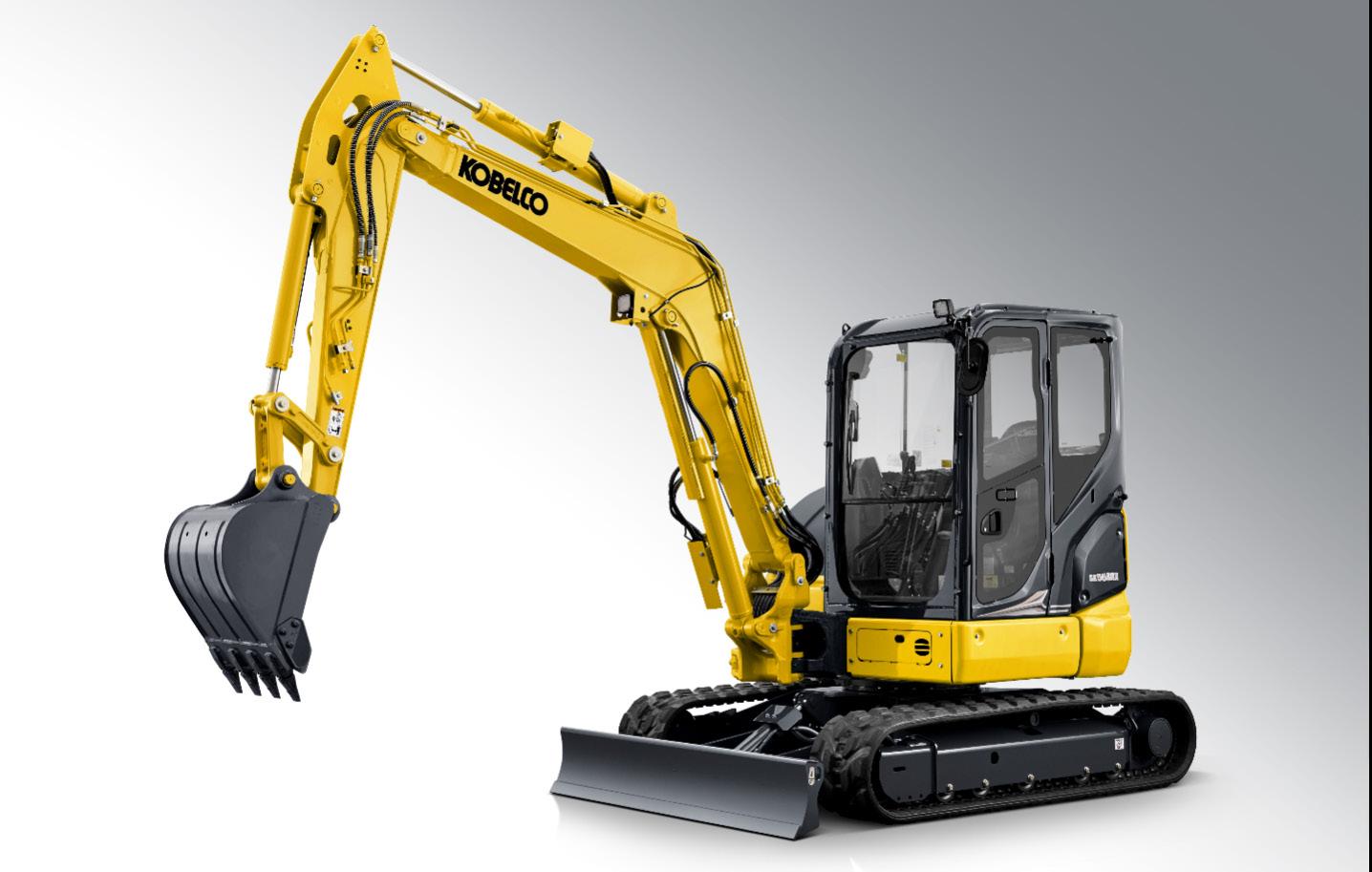
Movex Mini Crawler Crane
The Movex Mini Crawler Crane is a remote-controlled solution for utilities and electrical installations on construction sites. This work vehicle can be used to transport pad-mounted and underground transformers in the field. Designed for maneuverability in tight spaces, the crane is capable of taking on different types of terrain, including up to 15 degrees uphill or downhill. This machine is capable of handling up to 1,100 lbs. at a height of 16 ft., 5 in. or 2,090 lbs. at a height of 8 ft., 5 in. For transporting equipment or materials, operators can remove the crane interface. The crane is fully electric and offers zero emissions, allowing use in public locations and at night without disturbing neighborhoods.
The next-generation SK45SRX-7 weighs in at 10,030 lbs. with canopy and 10,300 lbs. with cab and has a 37-hp Yanmar Tier 4 Final diesel engine. Maximum digging height with the standard arm is 18 ft. 10 in., maximum reach at ground level is 18 ft. 8 in. and maximum digging depth is 11 ft. 3 in. The unit includes an energy conservation mode as well as a standard auto-deceleration switch to reduce fuel use. A new hydraulic system shortens the digging cycle time by up to 7% over the previous model, while redesigned travel motors increase travel speed by up to 5%. A twoway dozer blade with float comes standard or a four-way (power angle) dozer blade with float is an available option.


Read More at https://eqtoday.co/SK45SRX-7
Morooka MST80CR Crawler Carrier
Read More at https://eqtoday.co/stjsqx
Cat MH3050 Material Handler
The new Cat MH3050 material handler electrohydraulic system supports cycle times to handle materials. This machine is powered by the Cat C9.3B engine, capable of operating on up to B20 biodiesel. Meeting EU Stage V and U.S. EPA Tier 4 Final emissions standards, the engine’s maintenance-free aftertreatment system maximizes machine uptime. Operators can fine-tune power requirements to the task at hand with the choice between Power, Smart and Economy modes. Boom and stick offerings combine to provide up to 59 ft., 3 in. of reach, allowing operators to move material without repositioning the machine. The MH3050 also offers high swing torque when moving material. Allowing the boom to freely travel up and down without using pump flow, standard SmartBoom enables the operator to focus on stick and grapple control. Several attachments are available for flexibility. An optional 25-kW generator is available ex-factory for magnet applications.
Read More at https://eqtoday.co/hu054a
FISHER XRS Snow Plows for Skid Steers


The Morooka MST80CR, made in Japan, offers capabilities for hauling, material handling and dumping in various working environments. The MST80CR is another entry into Morooka’s rotator lineup. All Morooka rotators feature an upper structure that can rotate 360 degrees independently from the undercarriage. This allows them to maneuver around jobsites while reducing damage to the ground. With a payload capacity of nearly 18,000 lbs., the Morooka MST80CR can handle heavy loads. The machine is powered by a Kubota V5009 Tier 4 Final engine producing 210 hp. This carrier also features a heated and air-conditioned ROPS certified cab. A joystick control and rear and side view cameras support operation and visibility. The HARDOX dump bed is durable and resistant to wear and impacts.
Read More at https://eqtoday.co/5urc8z
The XRS Skid Steer Plow by Douglas Dynamics offers versatile snow removal in winter conditions. Designed specifically for skid steer applications, this rugged plow automatically retracts the inside wing when fully angled and then automatically returns to the scoop position once straight. The XRS plow leverages the onboard hydraulic system of the skid steer to lift and lower the blade, supporting operator performance. The oscillating skid steer mount comes standard and provides six degrees of side-to-side oscillation for scraping while reducing damage to the terrain. Available accessories include a 10-in. rubber deflector, shoe kit and quick coupler set.
Read More at https://eqtoday.co/FISHERXRS
www.ForConstructionPros.com/Equipment
EQUIPMENT INTRODUCTIONS 6 EQUIPMENT TODAY | August 2023

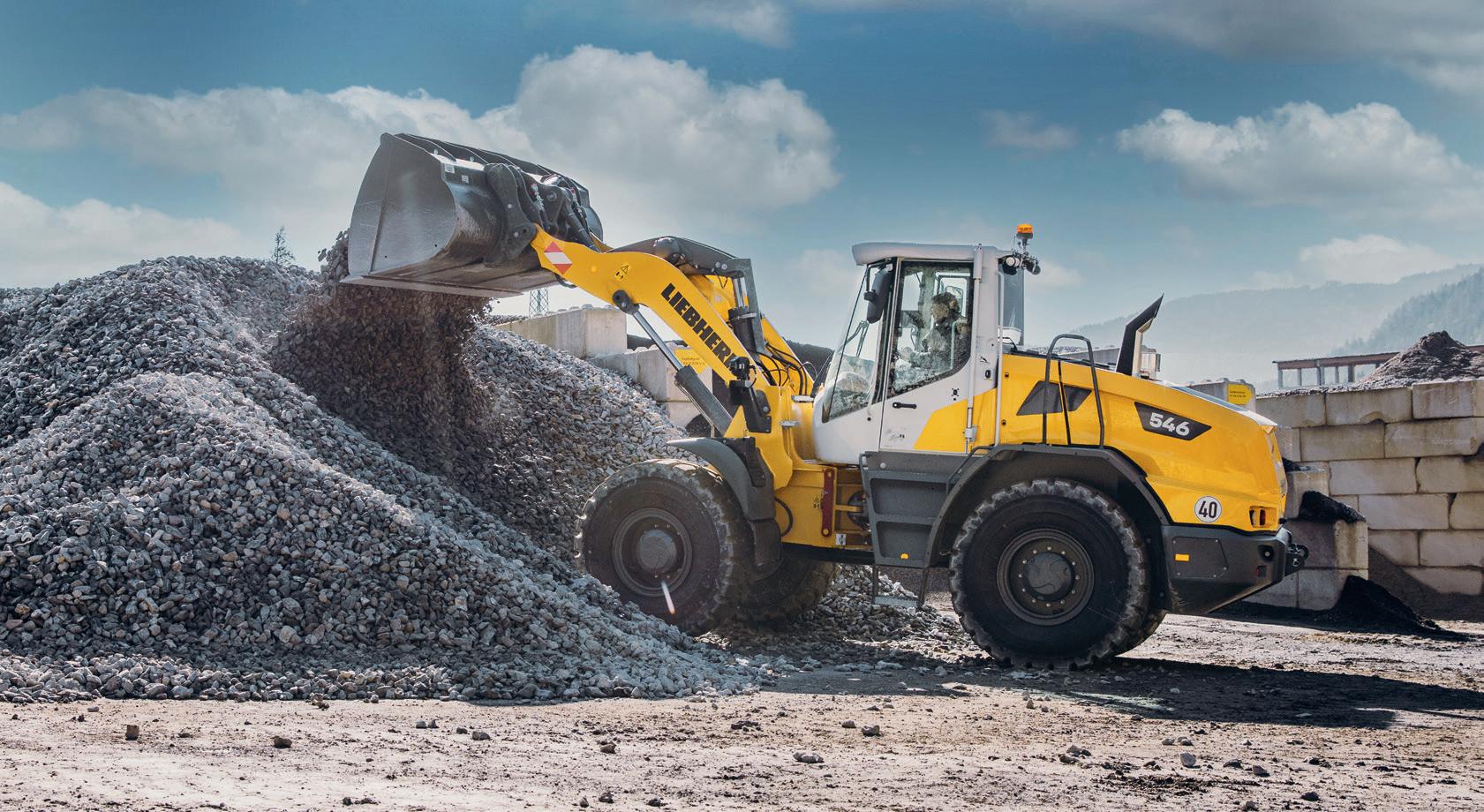


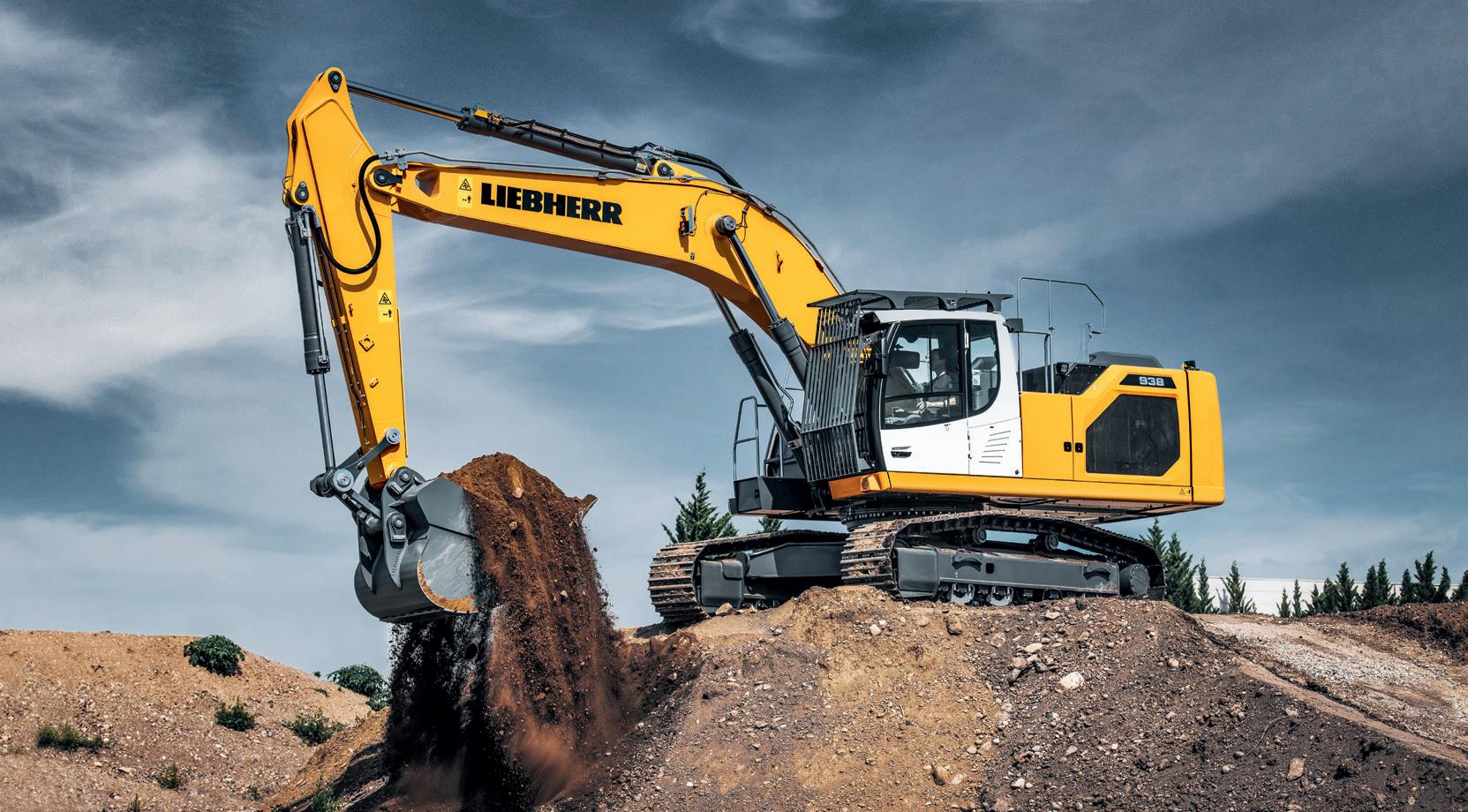






Engineered to do more www.liebherr.com Earthmoving machines Liebherr USA Co. • Construction Equipment Division • 4800 Chestnut Avenue • Newport News, VA 23607 • Phone +1 757 240 4250 Construction.USA@liebherr.com www.facebook.com/LiebherrConstruction www.liebherr.us/dealers-emt www.liebherr.com
These pages feature some of the latest equipment available. For more information on these products, use the QR code shown.
Loftness Stump Grinder Attachment
Bobcat AT450 Articulating Tractor
Bobcat expanded its grounds maintenance equipment lineup with the debut of the Bobcat AT450 articulating tractor. The AT450 powers a variety of front-mounted, belt-driven attachments. Because of the machine’s four-wheel drive, low center of gravity and its ability to both articulate and oscillate, operators get stability across various types of terrain and conditions. The AT450 features a 32-hp, liquid-cooled gasoline engine that produces power for front PTO attachments. With the articulating tractor’s attachment system, operators have added versatility to put a host of attachments to work.
Read More at https://eqtoday.co/lq6cut
This attachment is compatible with skid steers, compact track loaders and excavators. Equipped with a rigid mount, the Stump Ax features a repositioned power unit. The attachment does not swing the cutting wheel during use. It has an angled hitch and forward-reaching boom to give the operator visibility and control on the job. The Stump Ax includes the Phantom Wheel with Tomahawk teeth from Leonardi, which offers cutting performance. The Phantom Wheel also has cut-outs to create a see-through effect for visibility. A 200-cc, high-torque radial piston motor on the Stump Ax is compatible with power units that have 30-gpm to 60-gpm hydraulic flow ratings. A reversible design allows the motor to be mounted either forward- or rear-facing.


Read More at https://eqtoday.co/LoftnessAttachment
Komatsu Upgraded PC130LC-11 Mid-Size Excavator
Komatsu has released the upgraded PC130LC-11 excavator with a longer undercarriage design. The excavator also features increased lifting capacity by up to 20% compared to the previous model. This 97.2-hp tail swing excavator offers a combination of lightweight power and agility on construction sites. Operating weight is 28,440-29,101 lbs and bucket capacity is 0.34 yd3 to 0.78 yd3. The PC130LC-11 uses up to 12% less fuel than the previous model (PC130-8). The Komatsu diesel oxidation catalyst (KDOC) helps reduce particulate matter by using passive regeneration over 98% of the time.
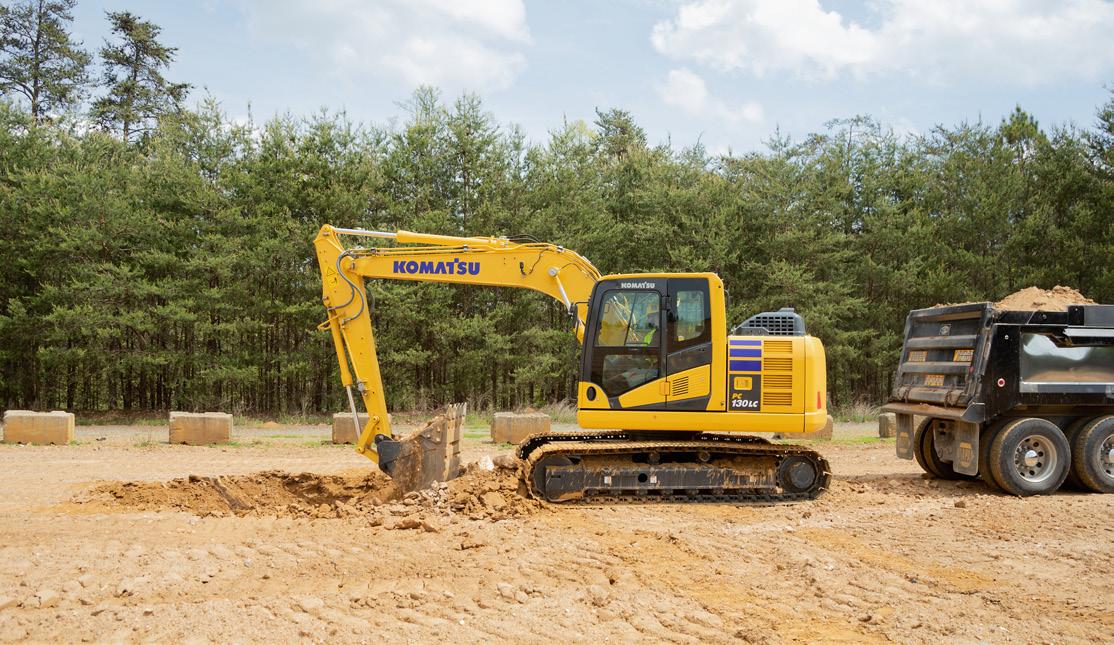
Read More at https://eqtoday.co/nfm51g
Metabo HPT 18-V MultiVolt LED Handheld Spotlight and LED Tripod Light
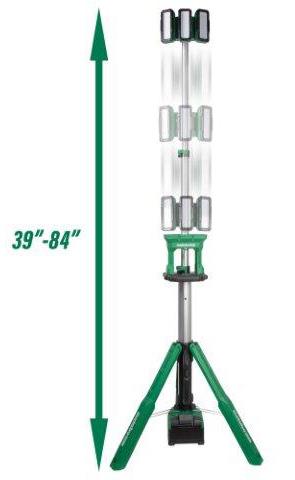
Metabo HPT announced the newest additions to its cordless lineup featuring water and dust resistant lighting with the launch of the 18-V MultiVolt 1,050-lumen LED Handheld Spotlight (model UB18DHQ4) and 18-V MultiVolt 4,000-lumen LED Tripod Site Light (model UB18DGQ4). Both are sold as tool body only and accept 18-V batteries or 18-V/36-V MultiVolt battery (sold separately) for flexibility. The portable lights can be used on the jobsite for a wide range of tasks and projects in indoor or outdoor areas. As 18-V, the user can decide to GO lighter by using an 18-V battery or choose to GO longer with the flexible 18-V/36-V MultiVolt battery to double the runtime per charge.
Read More at https://eqtoday.co/evzloj
Western Global FuelCube Type-S Fuel Tank
The FuelCube Type-S is a compact fuel tank that fits in the back of a truck. Available in the U.S., the FuelCube Type-S is a reliable, flexible and transportable fuel tank for fleets on jobsites. Designed to safely transport and dispense diesel fuel without hazardous material placard requirements, it serves as an alternative to slip tanks. This new solution offers 110% containment, security features and versatility for fleet operators. The dual-purpose adaptability of the tank allows businesses to use it as a truck bed tank or an on-site tank. The FuelCube Type-S features a 119-gallon capacity and is for 3/4-ton pickups or larger because of the tank’s weight when filled with fuel.
Read More at https://eqtoday.co/7qvefm

EQUIPMENT INTRODUCTIONS 8 EQUIPMENT TODAY | August 2023 www.ForConstructionPros.com/Equipment
The Worldwide Leader in Concrete Paving Technology



GOMACO offers the full range of concrete slipform pavers, curb and gutter machines, trimmers, placer/spreaders, texture/cure machines and bridge/canal finishing equipment. GOMACO equipment features our exclusive and proprietary G+® control system, created in-house by our software engineers from the wants and needs of contractors paving in the field. At the heart of GOMACO equipment is our passion for concrete and our commitment to our customers. We look forward to visiting with you about your upcoming paving projects and your concrete paving equipment needs. Our worldwide distributor network and our corporate team always stand ready to serve and assist you.


CONCRETE STREETS AND HIGHWAYS x AIRPORT RUNWAYS x CURB AND GUTTER x SIDEWALKS RECREATIONAL TRAILS x SAFETY BARRIER x BRIDGE PARAPET x BRIDGE DECKS x IRRIGATION CANALS GOMACO CORPORATION IN IDA GROVE, IOWA, USA x 712-364-3347
x info@gomaco.com
www.gomaco.com
BIG DOZERS
many of the popular features found in its smaller counterpart. The DD130 dozer delivers more horsepower, better tractive effort and superior pushing power to help operators move more material and get more work done efficiently,” said Jacob Sherman, dealer and product marketing manager at DEVELON. “The DD100 is a 10-metric-ton dozer, while the larger DD130 weighs approximately 13 metric tons.”
says that all Komatsu dozers in the D65/85/155 family offer contractors outstanding power, economy and reliability.
Attachments
Compact construction equipment is having a moment right now and with good reason. These machines are beneficial on small sites because of their size and maneuverability. During CONEXPO-CON/AGG 2023 (CONEXPO), manufacturers launched or previewed new machines of many kinds.
Among them were compact models including skid steers, track loaders and wheel loaders. However, some larger models were also announced, including large dozers. So, what are the new details around some of these larger machines, and how can they benefit contractors and operators?

Larger Models
More power, more push and more traction are some benefits of larger dozer models.
“The DD130 [previewed during CONEXPO], the latest addition to the DEVELON dozer lineup, builds on the success of the DD100 by incorporating
They also “improve jobsite productivity and lower operating costs on the industry’s toughest and most challenging jobsites,” according to Matt Goedert, solutions marketing manager, roadbuilding, for John Deere. John Deere’s dozer lineup includes two large dozer models, the 950K and the 1050K. The 1050K has a 13.5-liter engine producing 350-horsepower (hp) (261-kW) and weighs 95,400 pounds. (43,270 kilograms).
“The 950K dozer is available in both outside dozer and power angle tilt (PAT) blade configurations, making it the industry’s largest sixway blade. The 950K PAT weighs 73,700 pounds. (33,431 kilograms) and is capable of doing largescale dozing work while also being versatile enough to complete fine grading tasks over large areas,” Goedert said.
Casey Zbinden, product marketing manager for Komatsu,
In addition to their size, the attachments available for dozers are expanding. From shake buttons to remove material to increased blade capacity and simplified coupling, manufacturers are listening to their customers to improve the productivity and efficiency of their dozers.

“The 1050K [blade was] redesigned … to better match the capabilities
of the machine. We made the blade over 6 inches wider and reshaped the radius of the blade to roll and carry more material. Both changes increase blade capacity and make the machine more productive, pushing more material every pass than the previous design,” Goedert said.
He continued discussing a preview of the 1050 P-Tier. “We continue to listen and react to our customers’ feedback. [The 1050 P-Tier] shows that. The machine will feature a redesigned blade linkage and a shorter mainframe, both allow the blade to be moved back over 17 inches reducing
10 EQUIPMENT TODAY | August 2023 www.ForConstructionPros.com/Equipment COVER STORY | By Lori Ditoro, Editor-in-Chief, Equipment Today
Compact equipment is popular, but sometimes, you need a larger machine.
The 1050K has a 13.5-liter engine producing 350 horsepower and weighs 95,400 pounds.
The 950K dozer is available in both outside dozer and PAT blade configurations.
John Deere
John Deere
the overall length of the machine. This also will improve the machines’ balance and make it easier for operators to grade smoother.”
The DEVELON DD130 dozer offers two blade sizes: a standard 4.6 cubic yard blade or an optional 5.5 cubic yard capacity blade.
“The dozer blade moves freely to lift, tilt and angle, and 2-way mechanical adjustments can change the blade pitch to control how steeply the blade will dig into the ground,” Sherman said. “Operators can adjust the dozer blade pitch from 52 degrees to 58 degrees. To further enhance the operator’s experience, the DD130 is available with a blade shake button ...[that] enables operators to quickly remove materials that may become stuck to the blade, thereby maximizing productivity.”
Zbinden explained that the Komatsu D155AX-8 has semi-U and full-U blade options and blade capacity up to 15.6 cubic yards. The D155AX-8 has variable multi-shank and variable giant ripper options.
Safety & Operator Comfort
With the need to maximize safety and to retain experienced operators, the cab environment and safety capabilities matter now more than ever. Camera systems, improved seating for comfort and minimized cab vibration are a few of the improvements that manufacturers have made.
According to Zbinden, LED lights and a light for the ripper (when equipped) are new safety enhancements for Komatsu large dozers. In addition, a rearview camera
monitoring system is standard and displays the view behind the dozer on a large, color monitor in the cab.
Visibility is another safety improvement important to operators.
“One of the biggest differences between the DD130 dozer and other brands is the visibility to the machine’s blade,” Sherman said. “The front engine compartment of the DEVELON dozer offers a narrower design to make it easier for operators to see their work and perform tasks with increased precision.”
The John Deere 1050 P-Tier also prioritized visibility and seatbelt safety.
“A notable change on the next generation 1050 P-Tier shown at CONEXPO was the lowered hood. This increases the glass area of the front window, [improving] visibility to the front of the machine,” Goedert said.
“The 1050 P-Tier will also incorporate an operator presence system that will not allow the parking brake to be disengaged unless an operator is in the seat with the seatbelt fastened.
A surge in designs to improve operator comfort is occurring. “The most notable change on the [1051K] was the addition of the suspended double bogie undercarriage to provide exceptional operator comfort. This undercarriage update provides dampening of vibrations when working in rough terrain and rock,” Goedert said of the John Deere 1050K dozer.
New Tech
Automation, grade control, emission minimization, telematics and fleet management are all priorities for
contractors to improve efficiency, productivity, uptime and return on investments. For helping less experienced operators, grade control is a game changer.
The DD130 dozer delivers more horsepower, better tractive effort and superior pushing power when compared to the DD100.

“The DEVELON DD100 and DD130 dozers are available with a 2D grading system option to make precision grading easier, even for novice operators. The 2D grading system is accessible on the Smart Touch display in the DEVELON dozer cab,” Sherman said. Goedert agrees that grade control is an integral part of today’s dozers. “SmartGrade reduces operating costs by fully optimizing machine performance and production throughout the entire job cycle. Advanced features like Auto SmartGrade integrate the grade control system with the machine’s power management system and control the blade based on engine load, making this system easy for operators of all skill levels.”
For fleet management and data to improve productivity and uptime, equipment telematics are requirements now instead of options. All the manufacturers discussed the importance of this technology.
“John Deere’s JDLink is included on all large dozers and enables machine

information to be visible in a digital environment called John Deere Operations Center. In the operations center, [operators’ teams] can monitor machine health, maintenance plans, fuel usage and operating parameters. Using data gives customers insight to make decisions,” Goedert said.
Most manufacturers also include technology to monitor and decrease emissions from diesel engines.
“Tier 4 machines use diesel particulate filters to burn off engine soot via regeneration. To help make sure it rarely impacts operations, all Komatsu D65/D85/D155 models use continuous passive regeneration and active regeneration that typically doesn’t require the dozer to stop,” Zbinden said.
Read more at: https://eqtoday.co/BigDozers
August 2023 | EQUIPMENT TODAY 11 www.ForConstructionPros.com/Equipment COVER STORY | By
Ditoro, Editor-in-Chief, Equipment Today
Lori
Komatsu D155AXi-8 dozer, part of the D65/85/155 family
Komatsu
DEVELON
Without question, excavator operators are encountering more challenges on urban construction sites than ever before. First, commercial and residential development is increasing at a steady pace, leading to larger buildings and homes on smaller lots. As these they are being developed, construction sites are becoming restricted, and operators cannot move their excavators as freely as they used to.
“Tight corners, narrow pathways and confined areas can limit excavators’ abilities to navigate easily, thereby requiring careful planning and skilled operation,” said David Caldwell, national product manager, Takeuchi-US.

Aside from restricting excavators’ movements, many present-day urban construction sites provide operators with another significant challenge—they typically don’t provide enough space to store their excavators. Therefore, they must use their equipment efficiently because they can generally only arrive at the construction sites, dig and then immediately leave, according to Brad Mace, product manager, CASE Construction Equipment.
To efficiently excavate on tight, urban construction sites, operators
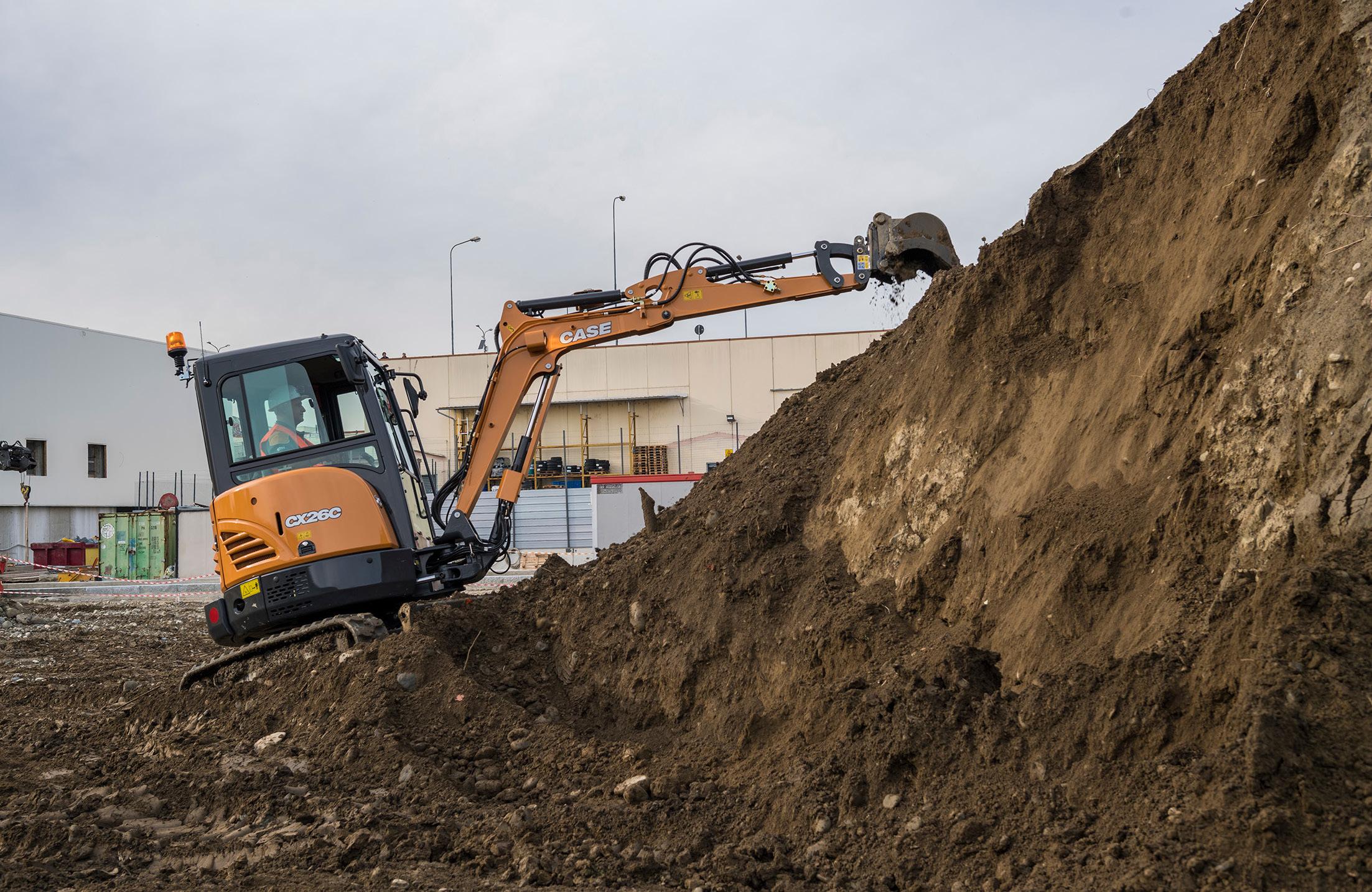
Compact Excavators for Tight, Urban Construction Sites
must be precise and cautious. After all, according to Caldwell, excavators are often used near existing structures, like buildings, fences and walls. By being as precise and cautious as possible, operators can avoid collisions, along with any subsequent damage associated with them.
“Narrow gates or entrances can make it tough for some excavators to enter or exit construction sites,” Caldwell stressed. “In turn, delays can occur and additional efforts to create suitable access points may be required.”
At the same time, according to Drew Kolo, marketing manager, Doosan Bobcat, excavator operators must work near critical infrastructure that simply can’t be disturbed, including fiber optic cables, power lines and water and gas lines. And, of equal importance, they’ll have to overcome issues associated with noise. For example, while working in small, confined areas, the noise and vibrations produced by excavators will amplify, resulting in discomfort for operators, nearby coworkers, and occupants of businesses and homes that are nearby, according to Caldwell.
With the goal of protecting excavator operators and everyone near them, state and national governments have passed several noise restrictions
for construction sites. Additionally, to protect the environment, state and national governments have enacted carbon emission restrictions, too, which operators must bear in mind every time they use their excavators.
The bottom line? As a result of each of these issues, the smaller an excavator is, the better.
To determine which excavators are the most ideal for urban construction sites, Equipment Today recently spoke to four excavator manufacturers: CASE
Construction Equipment, Doosan Bobcat, Takeuchi-US and Yanmar Compact Equipment North America. The manufacturers discussed exactly how operators can overcome the challenges they’re encountering on construction sites. Furthermore, they shared which features excavators ought to have, as well as the technologies operators should consider implementing as they use excavators in tight, urban construction sites.
12 EQUIPMENT TODAY | August 2023 www.ForConstructionPros.com/Equipment COMPACT EQUIPMENT
Able to be towed with a conventional pickup truck—without any need for a CDL—compact excavators like the CASE CX26C are an easy addition to a majority of companies’ fleets.
CASE Construction Equipment
By using these machines, operators can enhance their productivity as many jobsites continue to shrink.
Takeuchi-US CASE Construction Equipment
Retractable undercarriages, available on compact units like the TB210R, minimize excavators’ footprints, allowing them to access constricted areas.
Increase Efficiency, Minimize Disruptions, Reduce Injuries
Spatial awareness, precise control and adaptability are key skills that operators should strive to enhance as they use excavators—particularly compact excavators—and face several issues on their urban construction sites. In addition, according to Caldwell, they must have effective communication with their coworkers and implement safety protocols to guarantee their excavation operations run as smoothly and safely as possible.
Training and practice, regarding compact excavators, are vital, too, as each will help operators become more efficient and precise whenever they use their machines. Aside from focusing on their excavators, operators should also verify whether any access or stability issues are present on their construction sites before they begin excavator operations.
“By finding ways to ensure clear access and impose additional safety measures, operators can prevent any potential of delayed projects once their compact excavators arrive on their construction sites,” Caldwell explained. “Because they won’t need to ask for additional time to dig or move materials, they can better meet and exceed customer expectations.”
Operators should also ask their clients which time of day is the most optimal for them to operate excavators at construction sites, based on any noise restrictions— whether they’re working for schools, hospitals, businesses or homeowners. In doing so, they’ll minimize any disruptions to neighboring properties, nearby residents and potential future customers.
Along with focusing on people near their construction sites, operators must direct their attention to their colleagues, particularly by maintaining awareness of their surroundings and ensuring that all team members
remain as far away from excavators as possible.
“Situational awareness also helps prevent impacts with structures or other obstacles,” said Wesley Foy, product manager, Yanmar Compact Equipment North America. “Aside from utilizing their own awareness, excavator operators can use certain equipment features too, which will help them minimize construction site injuries considerably.”
Consider Tail Swings
Above all else, contractors and operators should seek compact excavators that either have zero or short tail-swing designs, as well as swing booms that will effortlessly and safely dig next to walls and guard rails.
“If excavators don’t protrude over tracks, operators can get closer to structures or move around in tight areas more easily than if they had to use a conventional tail-swing excavator instead,” Foy added. “Yanmar offers excavators with zero and minimal tail swings.”
This capability to move effortlessly in tight areas is particularly because zero tail swings and minimal tail swings allow operators to have more unrestricted rotation and flexibility as they work near structures or against walls, according to Kolo.
“A zero-tail swing virtually eliminates any potential of a compact excavator’s tail inadvertently contacting surrounding objects and damaging them, along with the excavator itself,” he noted. “Meanwhile, a minimal tail swing significantly reduces the likelihood of inadvertent contact, thus minimizing the odds of damage to nearby objects and structures.”
Like Yanmar, Takeuchi-US provides excavators with short tail swings too, including its new TB335R and TB350R models, each of which enables operators to use their excavators in
“They’re also ideal for gaining additional lift capacity, yet they may limit operators’ abilities to efficiently work in tight spaces.”
Enhance Reach, Dig More Accurately
Doosan Bobcat’s excavators are always available with standard arm configurations too, offering operators maximum breakout force and lifting capabilities, leading to more enhanced digging performances. For further reach and dig depths though, Kolo advises operators to equip their compact excavators with a long-arm option instead. By having additional reaching abilities, along with higher dump heights, they’ll be able to conduct more work without ever having to reposition their excavators, ensuring that they can load trucks in a more effortless way. Since the long-arm option has an additional counterweight when compared to standard arm configurations, operators will be able to enhance their excavators’ (whichever ones have the long-arm option, that is) lifting capabilities.
To have even more reach, operators can also use Doosan Bobcat’s clampready extendable arm option—the only one currently on the market. Available on select compact excavators, the extendable arm option provides operators with high power and lifting performance, while enabling them to extend their excavators’ dig depth and reach whenever necessary.
small spaces in a less risky way than they did in the past, especially with regards to damage and disruptions to their surroundings.
“Ultra-compact designs, featuring retractable undercarriages, minimize excavators’ footprints, allowing them to access confined areas and work in them,” Caldwell said. “Those features are typically only available on Takeuchi-US’s compactors, from the TB210R to the TB225.”


As operators determine whether to use zero tail-swing excavators, minimal tail-swing excavators or conventional tail-swing excavators, the sizes of gates and property lines they must pass through may be a substantial factor. Zero and minimal tail-swing excavators are roughly 70 inches wide. In contrast, conventional tail-swing excavators, like 3-metric-ton to 4-metric-ton compact excavators, are approximately 60 inches wide.
“If operators anticipate routine work in which they must pass through narrow gates or property lines, conventional, tail-swing excavators may be the best fit,” Kolo stated.
“Additionally, Doosan Bobcat’s unique Pro Clamp system is optimized for a standard arm configuration, allowing operators to grab large, small or irregular objects with greater confidence,” Kolo emphasized. “This feature is ideal for snug working conditions, as it enables operators to perform demolition or tear-out work, create smooth trench bottoms, and install and repair utilities by removing the tool, as needed for optimum visibility.”
To further enhance digging capabilities, the manufacturer also offers an Excavator Depth Check System. Allowing operators to dig accurately, the system eliminates the need for coworkers to manually check trench depths. Therefore, contractors reduce their need for manpower and save time because operators can focus on other tasks, improving productivity.
“All Bobcat compact excavators feature an exclusive in-track swing frame as well, which allows operators to get closer to their work,” Kolo continued. “The manufacturer’s boom swing castings and cylinders also stay within their tracks whenever operators conduct offset digging tasks, enabling them to truly dig flush against an obstacle and work in tight areas.”
Speaking of offset operation, Takeuchi-US presently offers two compact excavators that have sideto-side boom designs: the TB257FR and the TB280FR. As a result of their designs, the excavators can be used
August 2023 | EQUIPMENT TODAY 13 www.ForConstructionPros.com/Equipment COMPACT EQUIPMENT
Operators should seek compact excavators that either have zero or short tail-swing designs, along with swing booms that will effortlessly and safely dig next to walls and guard rails.
Yanmar Compact Equipment North America
Earlier this year, Doosan Bobcat released the E10e and E32e battery-powered excavators. Releasing no emissions, the excavators can be used quietly for challenging job tasks on very tight construction sites.
Doosan Bobcat
offset, while requiring minimal rotation of their counterweights. Providing high stability and lifting capabilities, particularly over their right-side tracks, these excavators offer high visibility for operators as they work offset, too.
“Each of our FR series excavators can also rotate almost completely within the track frame’s width, allowing each one to perform a full rotation in very tight spaces with their booms fully retracted,” Caldwell said.

Commit to Sustainability
According to Mace, compact excavators are currently the second largest category in construction equipment, and their popularity continues to rise. Aside from using excavators with zero, short and standard tail-swing designs, operators can also use electric compact excavators, enabling them to comply with emission and noise regulations more easily than they have in the past.
First, they can be used indoors without any risk of diesel or propane emissions being released into the air. And since they’re much quieter than the combustion-engine-driven excavators in the marketplace, operators can stand next to them as they’re running and have conversations with their colleagues at normal volumes.
“Electric excavators are being designed to deliver the same amount of power and performance as dieselpowered excavators too,” Mace said. “They also provide operators more adjustability, concerning their control panels—from adjusting performance modes, to setting flow rates for attachments, to customizing the machine parameters to their applications or preferences.”
Takeuchi-US also offers an electric compact excavator: the lithium-ion battery-powered TB20e. Because of its low-noise operation and zero emissions, the TB20e is ideal for
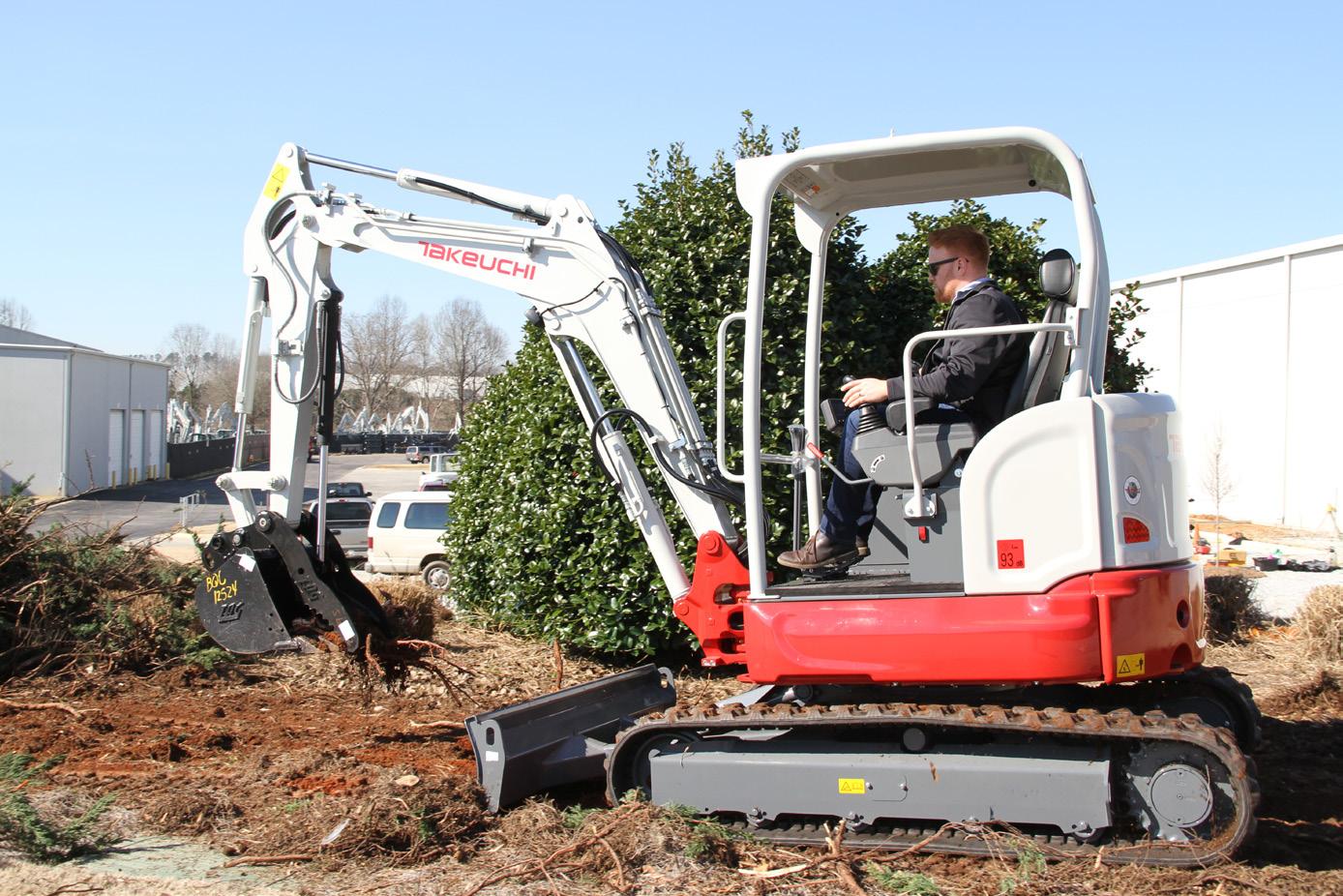
different applications, including in and around hospitals, municipalities, neighborhoods and schools.
“The TB20e provides excavator owners and operators a great opportunity to demonstrate their commitment to sustainability too, which many businesses, communities and organizations will look upon favorably,” Caldwell stressed.
In recent years, Doosan Bobcat advanced its electric offerings by releasing the E10e, E19e and E32e battery-powered excavators to the public. Each provides operators with diverse benefits. For starters, they don’t release any emissions. Very quiet, they’re also well-suited for environmentally sensitive sites or indoor applications, in which diesel exhaust is restricted. Finally, they can be used for challenging job tasks on tight construction sites.
“Because they release zero emissions, the excavators allow operators to work indoors, including when they need to conduct indoor demolition projects in which intensive manual labor is often the only other option that’s available,” Kolo stated. “They’re also quiet and can be operated at all hours of the day, even in dense urban areas where noise can, at times, limit operators’ work hours.”
Technology Offerings Increase Accuracy & Control
As operators use compact excavators in restrictive, urban construction sites, an array of technological offerings are available, some of which they may not even know they need.
According to Foy, boom swings can help them navigate around tight corners and dig around obstacles. In addition, by using a hydraulic quick coupler, operators can decrease their movements into and out of tight areas because they’re able to change attachments without ever having to move from their work areas.
According to Mace, operators
can also use CASE Construction Equipment’s intelligent and integrated displays, including touchscreen operator controls, which are highly visible and ergonomically accessible. Consequently, they can enhance operators’ safety and excavating efficiency, especially in spaceconstrained construction sites.
Additionally, retractable undercarriages are available on some of Takeuchi-US’s excavators, including the TB210R, TB216, TB216H, TB20e and TB225. For instance, the TB210 can retract down to 29.5 inches, enabling it to fit through a standard doorway. On the other hand, the other models have undercarriages that can retract, allowing them to fit through backyard gates. Once the excavators have entered the operators’ construction sites, their undercarriages can be expanded to ensure that they’re highly efficient and stable.
“Compact excavators are equipped with control systems that enable them to work with great precision and control,” said Caldwell. “Features like precise, low-effort pilot controls and proportional auxiliary hydraulic controls help reduce operator fatigue. Not to mention, they also provide operators greater precision, along with the ability to meter flow rates to the hydraulically driven attachments they may be using on confined construction sites.”
He continued, “With these offerings, operators can work on a wide range of projects, as they have the control and precision they need, resulting in improved performance, greater efficiency and higher profitability.”
Moreover, operators can adopt the latest telematics equipment management platforms, including the CASE SiteWatch. Able to generate real-time, remote information about compact excavator performance, the platform also creates service schedules, enabling them to set alarms
and receive notifications if excavators operate outside their normal parameters. In turn, operators can protect their excavators and prevent potential damage because they won’t be used when they’re not supposed to be. And they’ll be able to identify potential service needs before they evolve into issues requiring downtime.
To further enhance their efficiency and uptime, operators can add Doosan Bobcat’s 7-inch touch display, too. By using this wide, easy-to-use touch screen, operators can view detailed information regarding their excavators’ operating parameters and performance.
At the same time, they can also use Bobcat Machine IQ, a telematics system that helps them remain organized as they maintain their compact excavators. While using the system, contractors and operators can remotely track their compact excavators’ locations, maintenance and service issues, and operational statistics, thus minimizing maintenance costs and maximizing machine utilization.
“As construction booms in tight, urban spaces, by implementing these technological advancements, compact excavators will [allow] operators, managers and fleet owners to structure fleets that operate more easily and productively in these types of environments,” Mace concluded. “With ‘smarter’ excavators, operators can become more efficient and, in turn, reduce any of the issues that negatively impact productivity, profitability, safety and uptime.”
Read more at: https://eqtoday.co/MiniEx0823
Chris Lewis, a freelance writer for Equipment Today.
by
14 EQUIPMENT TODAY | August 2023 www.ForConstructionPros.com/Equipment COMPACT EQUIPMENT
Takeuchi-US provides excavators with short tail swings, such as its new TB335R model, enabling operators to utilize them in small spaces.
CASE Construction Equipment Takeuchi-US
The CASE CX60C comes with a standard adjustable boom that can be offset to either side, enabling them to operate in tight urban construction sites.
BETWEEN








A GIRDER AND A HARD
DO YOUR
Inspired by the challenges you face from foundation to finishing work, JLG is dedicated to developing the innovative solutions that deliver the productivity and safety you demand to leave your mark on the skyline of tomorrow today. LEAVEYOURMARKWITHJLG.COM
PLACE IS WHERE YOU
BEST WORK.
10 TIPS
Acompact excavator can be an important VIP on the jobsite and an investment that provides great returns. However, committing to a regular maintenance plan is key to reaping the benefits. Here are 10 tips for getting more hours out of a compact excavator.
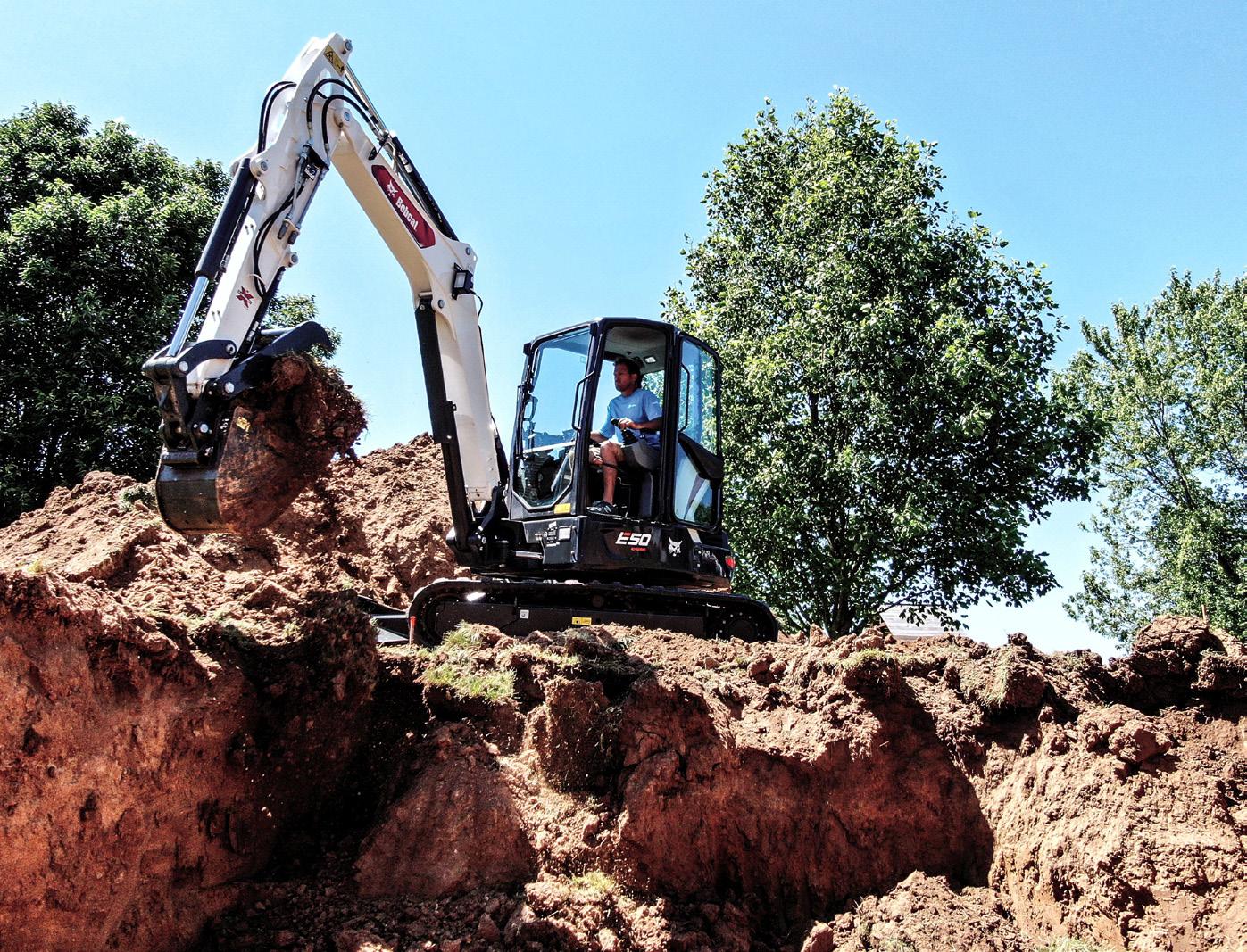
1. Read the Compact Excavator’s Manual
An operator’s first task is to review the compact excavator’s operation and maintenance manual to become familiar with the machine’s safety features, instrumentation, controls, service schedules and maintenance points. The operator’s manual is delivered with the machine and contains service and maintenance recommendations. If you misplace your manual, you can buy replacements from your local dealer. Most compact excavators have an operator’s handbook in the cab. It’s a good resource for operators to review before using a machine.
2. Top Machine Fluids off Daily
An effective maintenance regimen starts with daily fluid checks, including coolant, hydraulic fluid and engine oil. If levels are low, refill with the manufacturer’s recommendation, paying attention to classifications and viscosities. When checking levels, avoid contamination by keeping areas dirt free and using clean rags.
Emission-compliant, diesel engine excavators have unique lubrication requirements. Manufacturers match oils to their engines to ensure proper operation of exhaust aftertreatment.
It’s also important to lubricate a compact excavator’s boom and arm cylinders at recommended intervals, considering the application and temperatures of the operating location. To increase uptime, manufacturers recommend quality, lithium-based, multipurpose grease for all key pivot points, including cylinders, booms, blades, buckets, arms and slew-bearing components.
3. Maintain Equipment Filters
A compact excavator has multiple filters—fuel, engine, air and
FOR BOOSTING COMPACT EXCAVATOR UPTIME
cooler and condenser by applying low pressure air or water. Be careful not to damage the radiator’s fins.
7. Maintain the Battery & Charging System
Battery cables should be tight and clean. Inspect for corrosion on the cable ends and the battery terminals. Fuses protect the electrical system. Always replace failed fuses with a fuse of the same amperage rating.
8. Examine Ground-Engaging Tools
Check attachment components, such as cutting edges, teeth and hoses, to determine if wear is developing or damage occurred in tough applications. Replace worn or damaged pins or teeth to maintain excavator uptime.
9. Pay Attention to the Instruments
hydraulic—and each may have different service intervals. When dirty or completely clogged, a filter can significantly reduce excavator uptime and component life. Most compact excavators have air filters with restriction indicators that alert operators to maintenance needs. To avoid system contamination, don’t remove the filter until it’s required.
4.
Use Clean, Quality Fuel
Most manufacturers specify the use of clean, high-quality No. 2 or No. 1 grade diesel fuel. Compact excavator operators working in colder climates may prefer specially formulated blends designed to prevent gelling. At a minimum, compact excavators need ultra-low-sulfur diesel fuel to reduce exhaust emissions.
5. Inspect & Maintain Tracks
The most obvious wear item on a compact excavator undercarriage is the rubber tracks. Jobsite conditions and operator behavior affect track life expectancy. Examine the tracks daily for cuts, tears and exposed steel embeds. Punctures and tears may allow moisture or contamination into the tracks, leading to a shortened life. One important undercarriage item to monitor is track tension. A loose
track may de-track, impacting its life and the machine’s uptime. Refer to your operation and maintenance manual for ideal track tension ranges and the correct way to make adjustments. While a daily inspection isn’t required, monitoring other undercarriage components like idlers, rollers and sprockets can help identify potential issues. Accelerated wear on the sprocket is not common, but you should still examine the teeth. A good sprocket tooth has a rounded end, while a worn tooth is more pointed. Always check the sprocket condition when installing new tracks.
Finally, careful and thoughtful driving is important. Operators should keep best practices in mind for curbs, object avoidance and inclines/declines. They should also avoid chemicals and debris. When not in use, the excavator should be stored in a cool, dry environment.
6. Inspect the Cooling System Daily
An effective cooling system relies on adequate airflow and coolant levels. When either is low, an excavator can lose power, and the engine can overheat and cause damage. Proper cooling system maintenance includes checking for proper airflow and hose leaks. Clean the excavator’s radiator, oil
Some compact excavators have onboard instrumentation with controllers that perform multiple maintenance functions. These systems display and log data while providing a warning if systems operate outside parameters. If an operator doesn’t heed the warnings, the system will shut down to prevent damage.
10. Safety Is Essential to Productivity
Compact excavators often operate in challenging terrain and different conditions. Before operation, operators should understand what each lever and control does and how to operate the machine safely. In addition to the handbook, the compactexcavator-specific Association of Equipment Manufacturers safety manual is valuable. Follow instructions for maintaining rollover and tipover protective structures and make sure that the mounting hardware is secure. Seat belts should be properly tensioned and in good condition. Control console lockout systems should be functioning. Safety decals should be intact and legible, and all lighting should be operational.
Read more at: https://eqtoday.co/10MaintTips
Drew Kolo is the excavators marketing manager for Doosan Bobcat.
16 EQUIPMENT TODAY | August 2023 www.ForConstructionPros.com/Equipment COMPACT EQUIPMENT
With proper maintenance, you can protect your uptime and rely on your compact excavator to do the heavy lifting day in and day out.
Doosan Bobcat
Big work in tight spaces.


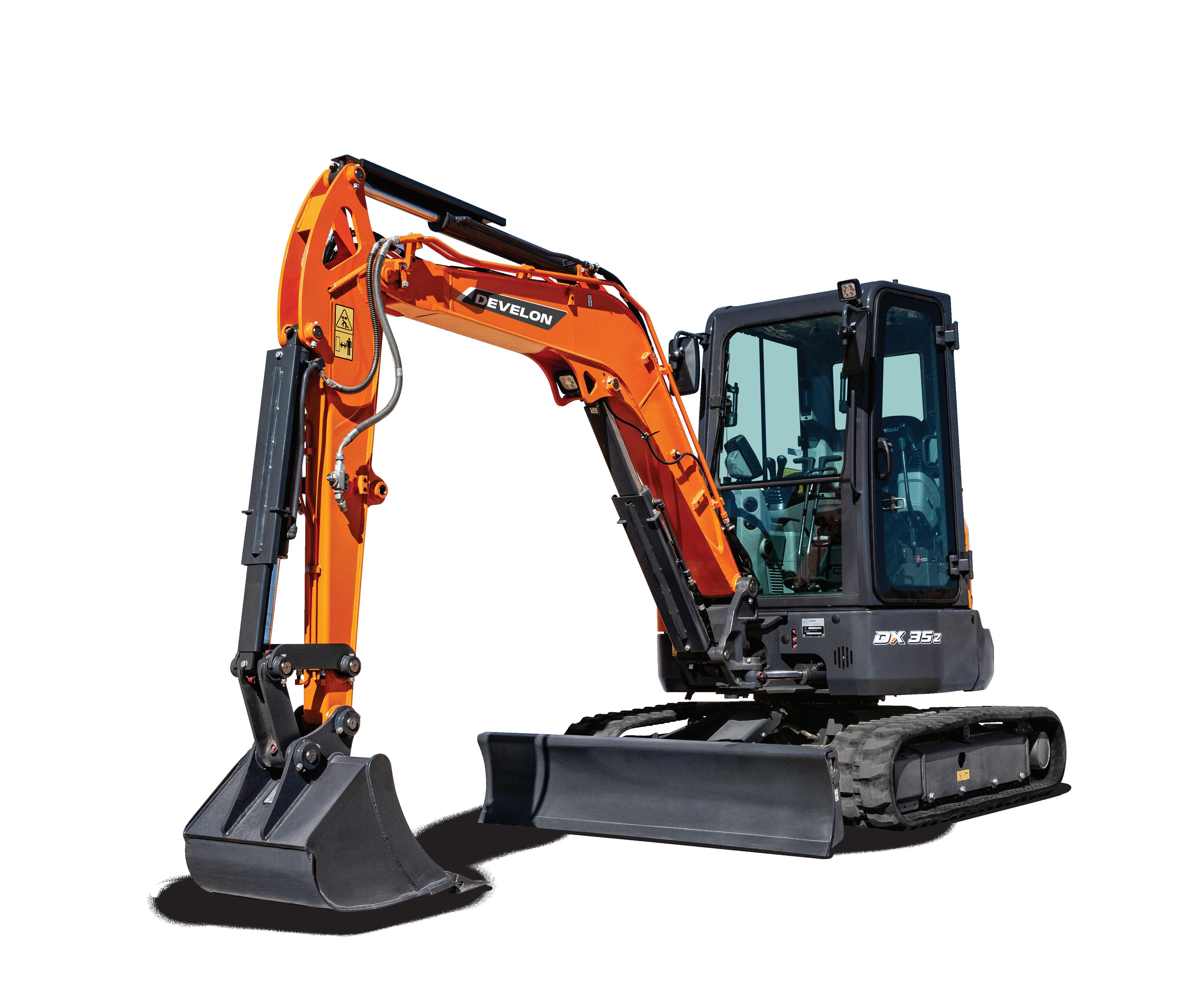
©2023 HD Hyundai Infracore. All rights reserved. DEVELON is a brand of HD Hyundai Infracore; HD Hyundai Infracore is an affiliate of HD Hyundai. Awarded to DX27Z-7, DX35Z-7 and DX50Z-7
Bobcat MT85 Mini Track Loader
The 3,110-lb. MT85 mini track loader has an 850-lb. rated operating capacity (+35%), 80.9-in. lift height to hinge pin (+12%) and a 29% increase in lift arm breakout force over the previous model.

• Features a 25-hp Tier 4-compliant diesel engine and 12-gpm auxiliary hydraulic flow
• Dual ISO joystick controls include a left-hand joystick to control drive function and a right-hand joystick to control lift and tilt functions
• Higher forward travel speed of 4 mph (+23%) and 2.3 mph when operating in reverse
• Standard operator presence/safety pedal, ride-on platform, hip pads, larger grab handles, cup holder and storage compartment
• Measures 36 in. with narrow tracks or 44 in. with wide tracks
Takeuchi TB335R
Case SR240 & SV280 Tier 4 Final Skid Steers
The 7,400-lb. SR240 and 8,090-lb. SV280 Tier 4 Final large-frame skid steers feature a 74-hp Tier 4 Final engine with a maintenance-free particulate matter catalyst solution.
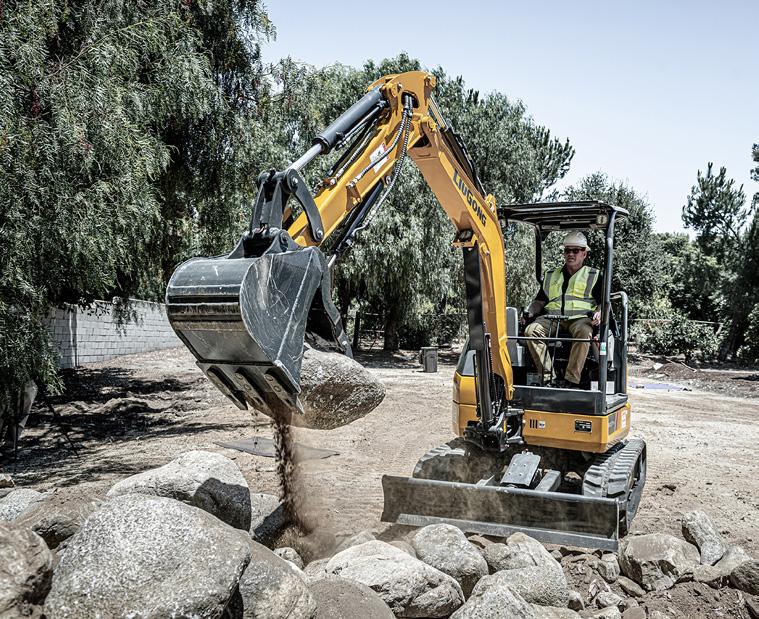
• Deliver 232 ft.-lbs. of torque, a bucket breakout force of up to 8,680 lbs. and standard (24.2 gpm) and highflow auxiliary (33.2 gpm) hydraulics
• Offer rated operating capacities of 2,400 (SR240) and 2,800 lbs. (SV280)
• 360-degree visibility with a cab-forward design, skylight and ultra-narrow wide side screens
• EZ-EH (electrohydraulic) setup menu
• Operator handles with detents improve controllability and feathering
Takeuchi has added the new generation TB335R short tail swing compact excavator to its TB300 Series. This excavator features a rugged interior and exterior design, as well as functions that provide performance on the jobsite. The TB335R’s short tail swing design results in a rear overhang of only 3.1 in. over the tracks for working in tight or confined spaces. The cab model TB335R has an operating weight of 8,310 lbs. (3,770 kg), a maximum bucket breakout force of 9,127 lbs. (40.6 kN) and a maximum arm digging force of 4,290 lbs. (19.1 kN). The excavator is powered by an EPA Tier 4, EU Stage V emissioncompliant engine delivering 24.4 hp (18.2 kW) and a maximum torque of 70.6-ft. lbs. (95.8 Nm). The TB335R offers two working modes—Standard and ECO—allowing operators to match the mode to the task at hand, choosing more power or fuel savings as desired.
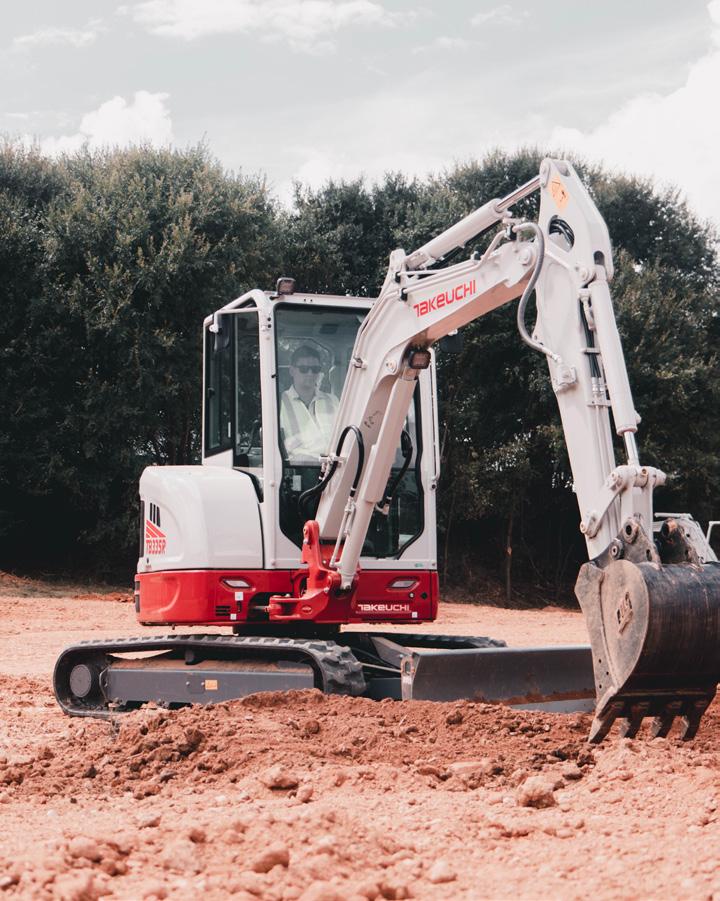
Caterpillar D Series CTLs and MTLs
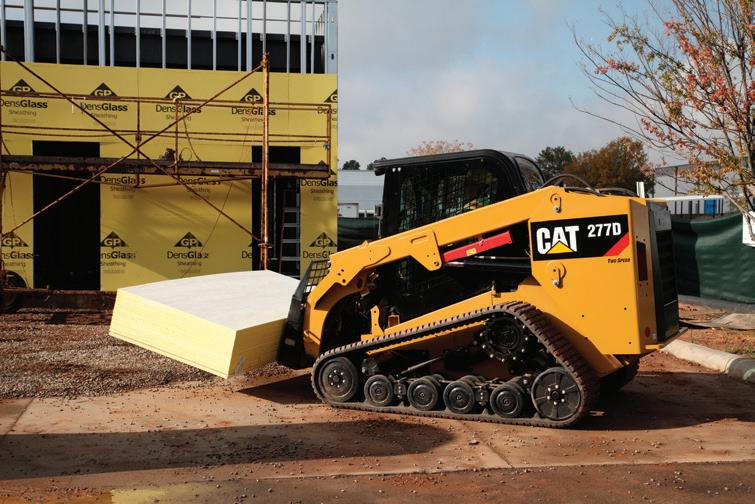
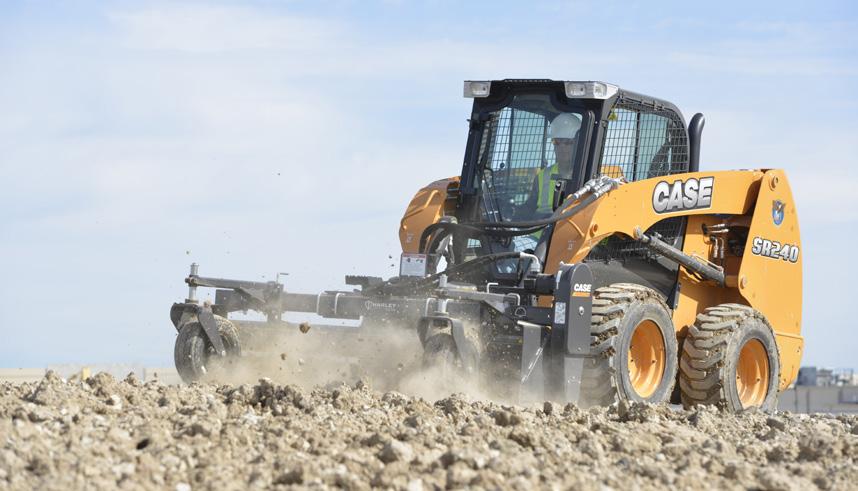
The D Series includes five compact track loaders (CTLs) and five multi terrain loaders (MTLs) ranging in rated operating capacity (50% of tipping load) from 2,800 to 4,650 lbs. The mid-size frame 257D MTL and 259D CTL and larger frame 277D and 287D MTLs and 279D and 289D CTLs feature the 74-hp Cat C3.3B electronically controlled, 3.3-liter, Tier 4 Final engine that provides 8% more torque and 6% improved fuel economy. The 297D, 299D, 297S XHP and 299D XHP CTL, feature the C3.8 electronically controlled, 3.8-liter, Tier 4 Interim engine. It produces 98 gross hp for the 299D and 297D and 110 net hp for the 299D XHP and 297D XHP. Other features include a torsion-axle suspension, “Cab-One” operator station and Intelligent Leveling System (ILEV).

John Deere 333G Compact Track Loader With Integrated SmartGrade
The SmartGrade 333G compact track loader helps automatically complete grading tasks faster with fewer passes and less rework.
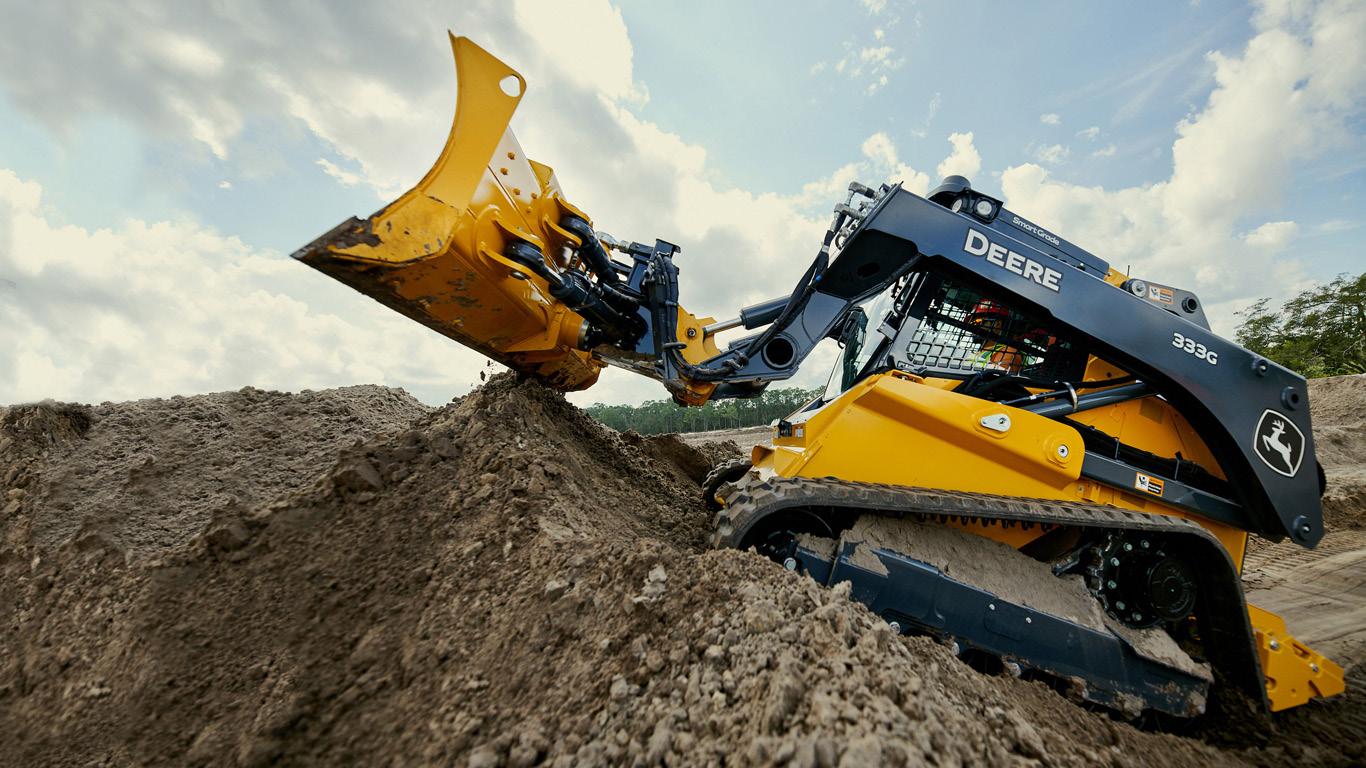
Grade control system fully integrated into the machine’s structures and software, eliminating masts and cables
• DozerMode enables the EH joystick control system to function like a crawler dozer with the push of a button
• Machine-equipped six-way dozer blade attachment can both cut a grade and spread materials and enables accurate and automatic cutting or finishing of light materials in tight spaces
• Blade reduces the amount of operator input and does not require tools to change between attachments
Kubota SVL75-2 High Flow Compact Track Loader
The SVL75-2 with high flow offers 2,300 lbs. of operating capacity, a bucket breakout force of 6,204 lbs. and lift arm breakout of 4,766 lbs.
• Auxiliary hydraulic flow of 29.3 gpm
• 74.3-gross-hp Kubota four-cylinder, directinjection, turbocharged, Tier 4 Final diesel engine
• Electronic Travel Torque Management System constantly monitors the load to optimally control hydraulic pump output
• Standard two-speed travel and high-ground clearance ensure travel performance on difficult terrain
• Multifunction levers provide fingertip control of all major functions 24.6-gal. fuel tank
LiuGong 9027F Zero Tailswing Compact Excavator
The 2.7-metric-ton 9027F has a Yanmar 20.4-net-hp Tier 4 Final engine, inline hydraulic pumps and main control valve.
• Standard bucket capacity of 0.065 cu. yds. with a bucket/cutting width of 15.75 in. and bucket breakout force of 4,496 lbf.
• 9-ft. 4-in. maximum digging depth and 10-ft. 1-in. maximum dump height
• Improved load-sensitive hydraulic system with 23.8-gpm main pump displacement
• Hydraulic control for travel, boom swing, arm and bucket machine functions engaged via travel pedals and joysticks
• Available in a climate-controlled ROPS cab or open canopy design with tip-over protection system
• Standard hydraulic thumb
18 EQUIPMENT TODAY | August 2023 www.ForConstructionPros.com/Equipment COMPACT EQUIPMENT Products Read More at https://eqtoday.co/earthmoving
KATO 9V5 Mini Excavator
The all new redesigned KATO 9V5 mini excavator will debut summer 2023. This ultra-mini zero tail swing excavator is a much faster and easier alternative to any shovel or wheelbarrow for working in tight spaces. With it’s ultra small size and roll down ROPS the 9V5 can even fit through doorways, standard yard gate, and even the tightest spaces making it perfect for any project. Need more stability? Standard equipment includes expandable tracks to help you power through your job with stability and ease. All new 9V5 will be available summer 2023.
CASE CX15EV, CX25EV Mini Excavators
CASE Construction Equipment is developing its mini excavator line with the launch of two all-new electrified mini excavators and a new dieselpowered mini excavator, and more models scheduled to hit the North American market in 2024. Anchoring the new mini excavator launch for CASE is the introduction of two allnew electrified machines, the CX15EV and the CX25EV. The CX15EV is a 3,186-lb. mini excavator powered by a 21-hp/16-kW electric motor—and the CX25EV is a 4,828-lb. mini excavator running with a 27-hp/20-kW electric motor. The lithium-ion battery featured in both machines is charged either by the 110-V/220-V on-board charger, or via an external rapid charger. CASE is also launching a new diesel-powered, true zero tailswing mini excavator to the market: the CX42D. This is the first model of the new CASE D Series and complements the existing C Series product line, giving CASE a broader reach into core weight classes that are in high industry demand.
Hyundai HX-A Compact Excavators



Hyundai Construction
Equipment Americas
revealed three new models in its HX-A series of compact hydraulic excavators: the HX35AZ, HX40A and HX48AZ. All three new models feature low-emission engines that are Tier 4 Final compliant. The Hyundai HX35AZ excavator is powered by a Kubota D1703 diesel engine with a net power rating of 24.8 hp (18.2 kW), while the HX40A and HX48AZ feature Yanmar 4TNV88C engines, rated at 37.4 hp (27.5 kW). The HX35AZ has an operating weight of 8,300 lbs. (3,765 kg), dig depth of 9 ft., 8 in. (2.95 m) and bucket breakout force of 7,081 lbs. (3,212 kg). The HX40A has an operating weight of 9,479 lbs. (4,300 kg), dig depth of 11 ft., 2 in. (3.4 m) and bucket breakout force of 9,846 lbs. (4,466 kg). The HX48AZ has an operating weight of 10,912 lbs. (4,950 kg), dig depth of 11 ft., 5 in. (3.5 m) and bucket breakout force of 8,223 lbs. (3,730 kg).
DEVELON DX42-7 Mini Excavator
With 47 net hp and a conventional tail swing configuration, this 4-metric-ton model is designed for navigating tight, congested jobsites and urban areas. Part of the nextgeneration -7 Series mini excavator lineup, the DX42-7 offers fast cycle times, torquelimiting piston pumps that respond to load demands and a large counterweight for balance and durability. Its maximum digging depth is 11 ft., 5 in. and maximum digging reach (ground) is 18 ft., 3 in. Its maximum loading height is 2 ft., 6 in., and its travel speed is 2.1 mph to 3.1 mph. The DX42-7 comes with a standard thumb-ready arm, quick-coupler-ready design and lever pattern control.
Mecalac MWR Compact Wheel Excavators
The MWR Series of wheeled excavators enables maneuverability in tight working areas, offering the flexibility and versatility of a skid steer or compact track loader in one machine. Each of the three models in the MWR series offers speed in a compact footprint. The smallest of the three, the 7MWR, offers variable speed between 0 mph and 19 mph. Two of the larger models, the 9MWR and 11MWR, provide contractors standard travel speeds between 0 mph and 12 mph with an option for higher speed up to 22 mph on the 9MWR and up to 19 mph on the 11MWR. A 75-hp (55.4-kilowatt) engine is standard on each model. The smallest model is capable of lifting three metric tons at 10 feet (3 meters) through 360 degrees.

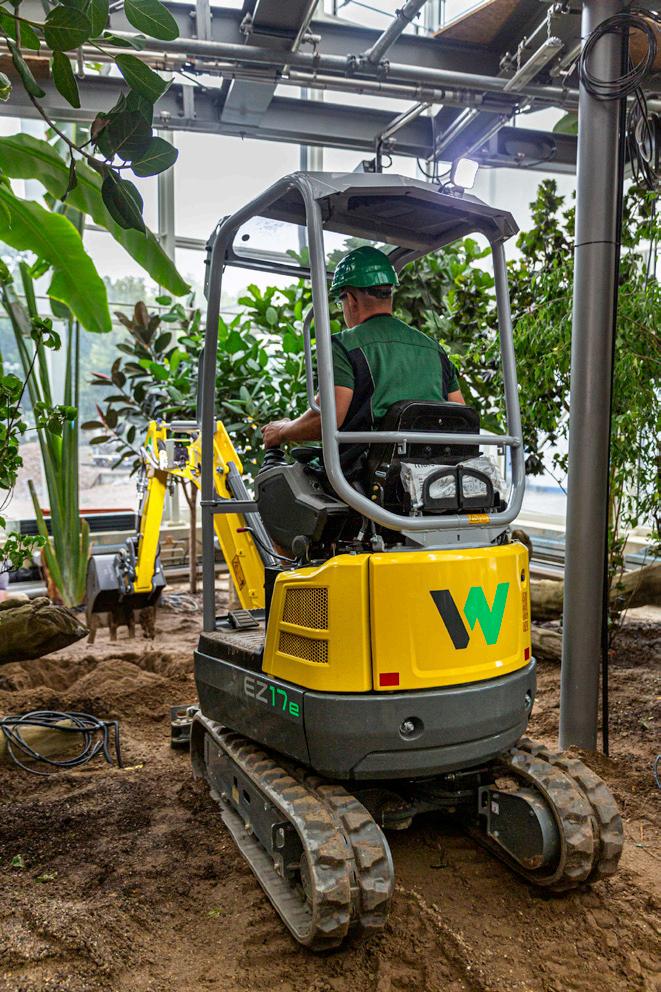
Wacker Neuson EZ17e Battery
Powered Mini Excavator
This 1.7-ton machine is a zero-emission solution for indoor applications and areas where noise and exhaust are a concern, such as construction sites in urban areas and those operating around the clock. The EZ17e mini excavator offers the same performance as the company’s conventional diesel model, but with zero emissions and reduced maintenance. With its minimal-tail swing design, it has a maximum digging depth of 97.7 in., a breakout force of 4,608 lbs. and the ability to run auxiliary attachments such as hydraulic breakers. The lithium-ion battery in the Wacker Neuson EZ17e offers all-day run time and can be recharged using a common 240-V, single-phase outlet. Charge time is between 5 and 6 hours. In addition, the machine can be operated in a stationary position while connected to a power source, if necessary. The maintenance-free battery reduces overall service and spare parts costs.
Hitachi ZAXIS-5N Compact Excavators

Hitachi ZAXIS-5N compact excavators range from 1.7 to 6 metric tons (1.10 U.S. tons to 6.61 U.S. tons) that feature either a short-tail swing radius (U) or an ultrashort-tail swing radius with swing boom (USB). ZAXIS-5N compact excavators are commonly used as tool carriers with a wide range of attachments. Standard auxiliary hydraulic lines have been pre-plumbed to the end of the boom on the ZX17U-5N and to the middle of the arm on the ZX26U-5N to ZX60USB-5N. A standard wedgelock quick coupler makes attachment hookup a snap. A factory-installed bracket for a thumb cylinder simplifies thumb installation. The operator can match the flow rate of the auxiliary hydraulic circuit to the requirements of the attachment being used with either a low or high setting.

August 2023 | EQUIPMENT TODAY 19 www.ForConstructionPros.com/Equipment COMPACT EQUIPMENT Products
Non-CDL Lube Trucks Address LABOR & JOBSITE MANEUVERABILITY Challenges

The long-standing driver shortage continues to worsen while many contractors also face ever more crowded urban jobsites. These challenges place a squeeze on existing mobile lube activities.

Large Class 7 or Class 8 lube/fuel trucks have been the norm on jobsites around the U.S. for decades. These trucks help technicians maximize preventive maintenance efficiency by transporting large quantities of off-road diesel and oil. Technicians can service multiple machines in the field before returning to the shop for additional fluids.
The capacity of these trucks depends on the gross vehicle weight rating (GVWR), which defines the maximum legal weight of a vehicle including passengers and cargo. The GVWR helps determine how many gallons of fluid a lube truck can transport. It’s not uncommon for Class 7 or Class 8 lube/fuel trucks to haul up to 1,000 gallons of fuel and 400 gallons of maintenance fluids in one trip.
While the capacity provides a clear advantage for some applications, Class 7 and larger trucks exceeding 26,000 pounds GVWR require operators with a commercial driver’s license (CDL). With these drivers becoming harder to find, some lube truck owners are exploring smaller trucks that don’t require a CDL—those in Class 5 and Class 6—to help them care for equipment on the job. In the process, they’re discovering the cost and efficiency benefits of deploying these smaller non-CDL trucks that weren’t frequently seen on jobsites just a few years ago.
If the smaller truck has the capacity to tackle a full day of preventive maintenance without returning to the shop, it may provide a lower cost of operation.

When the maintenance staff must service more than 200 pieces of heavy equipment on 35 jobsites across the fourth largest U.S. city, efficiency is essential.
Larger tandem-axle trucks can be difficult to maneuver on jobsites, especially those with uneven terrain. A single-axle non-CDL service truck offers enhanced maneuverability on tight or crowded jobsites.
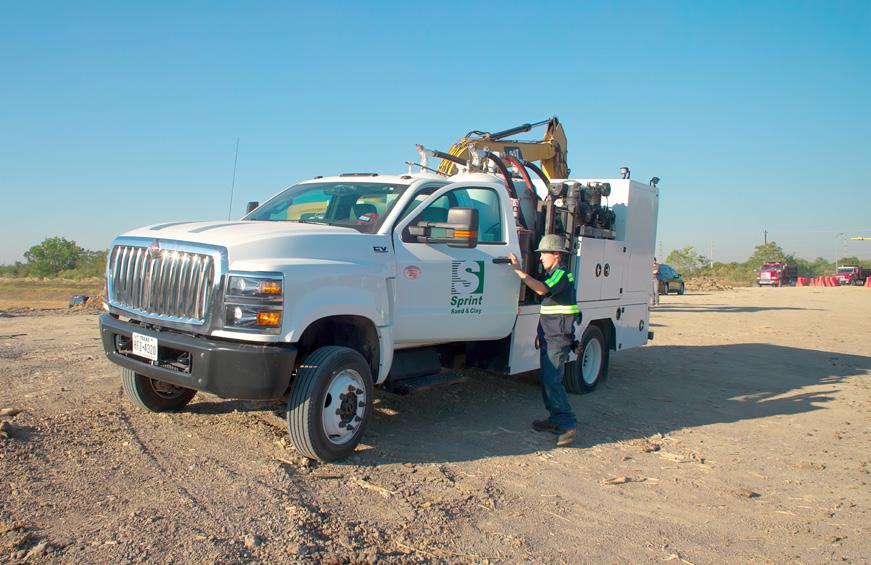

20 EQUIPMENT TODAY | August 2023 www.ForConstructionPros.com/Equipment FLEET MANAGEMENT
Finding drivers and navigating tight urban jobsites require an innovative approach.
Smaller, non-CDL trucks weren’t frequently seen on jobsites just a few years ago.
Sage Oil Vac
Sage Oil Vac
Sage
Oil Vac
Cope With the Driver Shortage
The first factor driving the transition to non-CDL trucks is the worsening driver shortage. Despite growing demand for all types of commercial transportation that requires a CDL— namely over-the-road trucking—the number of licensed commercial drivers in the U.S. has not increased. In short, the demand is growing but the qualified labor pool is not. There’s just a shortage of qualified, skilled drivers. It’s as simple as that.
This places lube truck owners in direct competition with over-theroad haulers and local businesses. A contractor or lube truck provider can invest more than a month sending an employee to a driver school to earn a CDL, but there is no guarantee that
they can retain that driver to recoup the investment.
Sprint Sand and Clay specializes in dirt work and selling construction materials to contractors and home builders in Greater Houston, Texas. When it comes to operating lube trucks for preventive maintenance, finding drivers with a CDL can demand higher compensation. It is also difficult to compete for available drivers because many don’t want to service equipment. They simply want to drive.
“Trying to find a CDL driver that wants to perform the service, not just take a load from Point A to Point B all day, is tough,” said Jacob Phillips, vice president of operations at Sprint Sand and Clay.
Lube truck owners can proactively address this challenge by eliminating the licensing requirement and creating new opportunities for existing employees. Without the requirement for special licensing, almost any technician in the shop can be assigned to run a non-CDL truck. This opens the door to more hiring opportunities for company owners and managers and more employment opportunities for operators.
Balance Capacity & Efficiency
The second factor in the transition to non-CDL trucks is the actual fluid capacity needed to service equipment. Contractors simply may not need the capacity or fuel-handling capability of a Class 7 or Class 8 lube truck. While not having enough capacity to service all the equipment on the jobsite leads to a loss of efficiency, hauling excess capacity decreases efficiency as well.
Sprint Sand and Clay knew they needed a solution that would balance capacity with efficiency. When the maintenance staff must service more than 200 pieces of heavy equipment on 35 jobsites across the fourth largest U.S. city, efficiency is essential. That’s the challenge this contractor faces each day. When its lube truck leaves the shop, it may travel two hours one way to a jobsite.
“It’s important that the truck has enough storage and fluid capacity to service many pieces of equipment on that side of town before going back and refilling the truck,” said Kyle Cain, president of Sprint Sand and Clay.
Sprint Sand and Clay’s service technician typically performs preventive maintenance on every piece of equipment while the truck is on a jobsite to maximize efficiency.


“In today’s world, you have to be as efficient as possible. We attribute our success a lot to equipment that we use and the innovation that’s provided with that equipment, from our dump trucks to our equipment to our lube trucks,” said Cain.
Sprint Sand and Clay turned to a
non-CDL open lube body truck. The non-CDL bodies are perfect for heavy equipment preventive maintenance, featuring a 180-gallon (681.37-liter) used oil tank and five fresh product tanks that can be configured for any fluids.
“We really believe in the small compact size of [this] lube truck. It’s very efficient and the cost of ownership compared to having a larger CDL truck with a CDL driver just makes sense,” said Cain.
Despite its compact size, the nonCDL open lube body is up to the task of servicing Sprint Sand and Clay’s 200-machine fleet. It offers the capacity to service all the equipment on up to two jobsites without having to return to refill.
Minimize Operating Costs
The third factor in the transition to a non-CDL lube truck is lower operating costs. It is easy to assume a bigger lube truck would drive efficiency, but that’s not always the case. Traditional Class 7 or Class 8 trucks have high fluid capacities, enabling them to service a lot of equipment. However, because of their size, they are also less fuel efficient when traveling long distances.
If the smaller truck has the capacity to tackle a full day of preventive maintenance without returning to the shop, it may provide a lower cost of operation. For instance, smaller displacement engines consume less fuel when driving long distances between jobsites.
Without wasted extra capacity, usage costs can decrease. Lower upfront costs paired with a smaller operating cost translate into a higher return on investment. Maintenance staff can calculate the total weight of the products that need to be carried to help assess truck size. It’s not always beneficial to automatically size up the next truck.
There are also regulatory costs to consider when operating larger trucks—which become an even bigger issue when traveling across state lines. Multiple non-CDL trucks will sometimes be more cost-effective and efficient than one Class 8 truck. Getting people to make a change like that is sometimes hard, but when pencil is put to paper, these changes can pay for themselves in months.
Access Tight Jobsites
A fourth factor to consider in the transition to a non-CDL lube truck would be jobsite access. Larger tandem-axle trucks can be difficult to maneuver on jobsites, especially those with uneven terrain. A single-axle non-CDL service truck offers enhanced maneuverability on tight or crowded jobsites. These lighter-weight trucks can also perform better than larger tandemaxle trucks in rough terrain. The lube
truck provider uses Chevrolet 6500, Ford F-600 and International 6500 fourwheel drive chassis. This adds mobility that a larger truck cannot perform because of its driven steer axle.
If personnel are working at a remote location that has a lot of challenging terrain, the smaller jobsite lube truck will be nimbler and will perform better than a larger, tandemaxle truck. This added maneuverability has been beneficial to Sprint Sand and Clay.
“It’s been very easy to maneuver in traffic, especially in Houston,” noted Cain.
Maneuverability coupled with quick connect fillings and the design of the lube truck provider’s system with sealed tanks reduces the chance of oil spills.
“A lot of our jobs are on government entity property—cities and counties—so being able to get in and out without having any spillage or environmental issues is very important to us,” said Cain.
Consider All Alternatives
There are several reasons for transitioning to a non-CDL lube truck. It opens the available labor force. It can reduce operating costs. It is more maneuverable, and there is a lower acquisition cost. The latter was particularly important for Sprint Sand and Clay.
The compact size and efficient operation of the non-CDL truck gives Sprint Sand and Clay a cost-effective heavy equipment service option. It provided a more cost-effective solution than relying on the local equipment dealer for preventive maintenance.
“I think when you compare what we would have to pay from the dealership versus doing it ourselves, it just really made sense for us,” said Cain.
But the non-CDL truck is not the best answer for every application. You need to look at all available options and determine if a larger lube/fuel truck, a trailer or a jobsite skid will work best in your specific application. Each solution has its own unique set of benefits.
Read more at: https://eqtoday.co/SmallNonCDL
Aaron Sage is CEO of Sage Oil Vac, Inc.
August 2023 | EQUIPMENT TODAY 21 www.ForConstructionPros.com/Equipment FLEET MANAGEMENT
The third factor in the transition to a nonCDL lube truck is lower operating costs.
Sage Oil Vac
Sage Oil Vac
Vanair DR 600XP Drill Module

The Vanair DR 600XP drill module provides a boost in pressure for demanding jobs, such as directional, down-the-hole, percussive hammer and rock drilling. During use, the drill module generates 600 cfm and 250 psi capable of supporting a 4-in. hammer drill. This machine comes with a vertical discharge tank, featuring a pressure relief valve, oil scavenge sight glass and coalescer restriction indicator. Dual two-stage air filters with dust evacuators promote clean air. Accessible instruments include temperature and pressure gauges. The DR 600XP has mounting provisions at the bottom of the frame for
Philippi-Hagenbuch Load Ejector System for Haul Trucks
DPL Telematics AssetView Mid Tracking System
AssetView is a solution for wireless monitoring and remote tracking of powered or unpowered assets to support logistics, manage inventory and curb theft. The small, portable GPS unit is self-contained and may be hidden on assets. AssetView
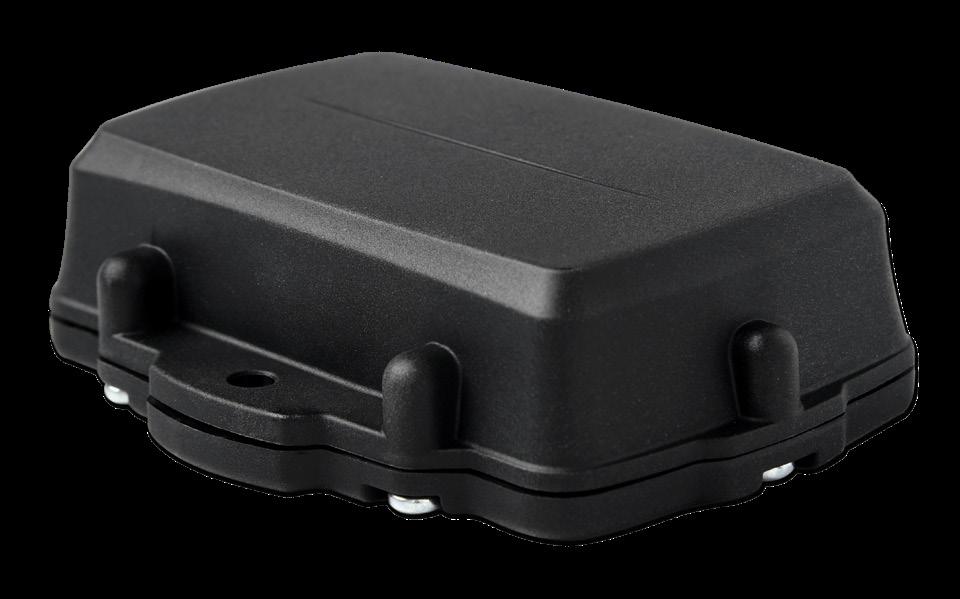
Mid allows managers to remotely monitor an asset from an internetbased software package and mobile app. Some features include no external wiring or antenna, unwired attachment to assets in a “hide and track” installation, long battery life and wireless communication.
Sticky materials, such as clay, dirt, mud, fly ash and bottom ash, tend to build up in haul truck bodies, minimizing volumetric capacity when carried back with the truck for the next load. The Load Ejector System consists of an overlapping, jointed plate lattice design that rests flat against the front slope and floor inside the truck body. When the body is raised, the Load Ejector separates from the truck bed by gravity, removing material as it hangs vertically away from the body. This leaves an empty truck with its full capacity for the next load. Additionally, PhilippiHagenbuch offers two material options to match the Load Ejector with different applications. The standard-duty design is made of high-strength Grade 80 steel and is intended for operations with minimal abrasion, while the heavy-duty design is built with Hardox 450 steel for applications that haul abrasive materials.

Maxam MS706 Construction Pro
The MS706 is designed for the most extreme OTR and construction applications. Its extra-deep tread allows for three to five times longer tire life vs. pneumatic tires. The three-stage 100% rubber construction includes ultra-cut and wear-resistant tread compound, heat-resistant cushion center compound, pure rubber base compound and internal steel ring reinforcement to eliminate wheel slip. Its zero-maintenance, solid construction allows no flats from punctures or sidewall damage and no routine air pressure checks are required. Its solid centerline provides smoother running on hard surfaces and better chunk resistance on rough ground.
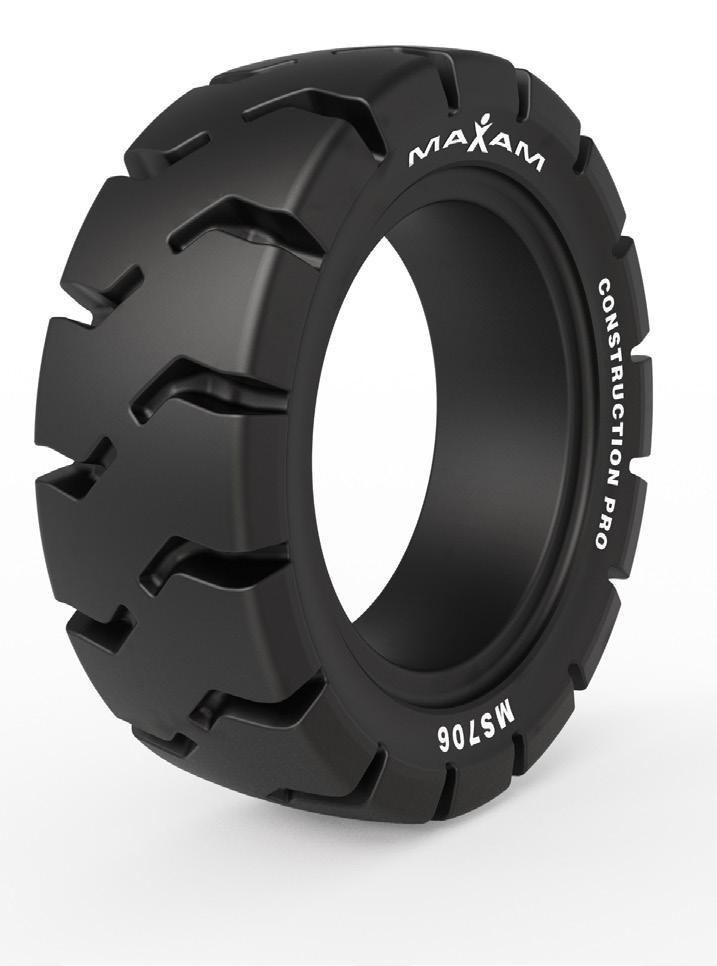

FLEET MANAGEMENT Products Read More at https://eqtoday.co/fleetmgmt STAY COOL WITH INSULATED PACKAGING π ORDER BY 6 PM FOR SAME DAY SHIPPING COMPLETE CATALOG 1-800-295-5510 uline.com
permanent installations, as well as integral forklift tubes for transportation.
DEWALT 20V MAX XR and XTREME 12V MAX Sealed Head Ratchets
DEWALT has announced two new sealed head ratchets: the 20V MAX XR 3/8-in. and 1/2-in. (DCF510) as well as the XTREME 12V MAX 1/4-in. and 3/8in. (DCF500). The new sealed head ratchets are equipped with features for demanding jobs. The heavy-duty sealed head design and glass-filled nylon tool housing helps provide protection against oils and solvents. The 20V MAX XR 3/8-in. and 1/2-in. Sealed Head Ratchet is compatible with all DEWALT 20V MAX batteries and chargers (sold separately). The bare unit (tool only) is available now, and the kitted unit with DEWALT POWERSTACK is available for preorder where DEWALT products are sold. The XTREME 12V MAX 1/4-in. and 3/8-in. sealed head ratchets are compatible with all DEWALT 12V MAX batteries and chargers and will be available as a bare unit or kitted.
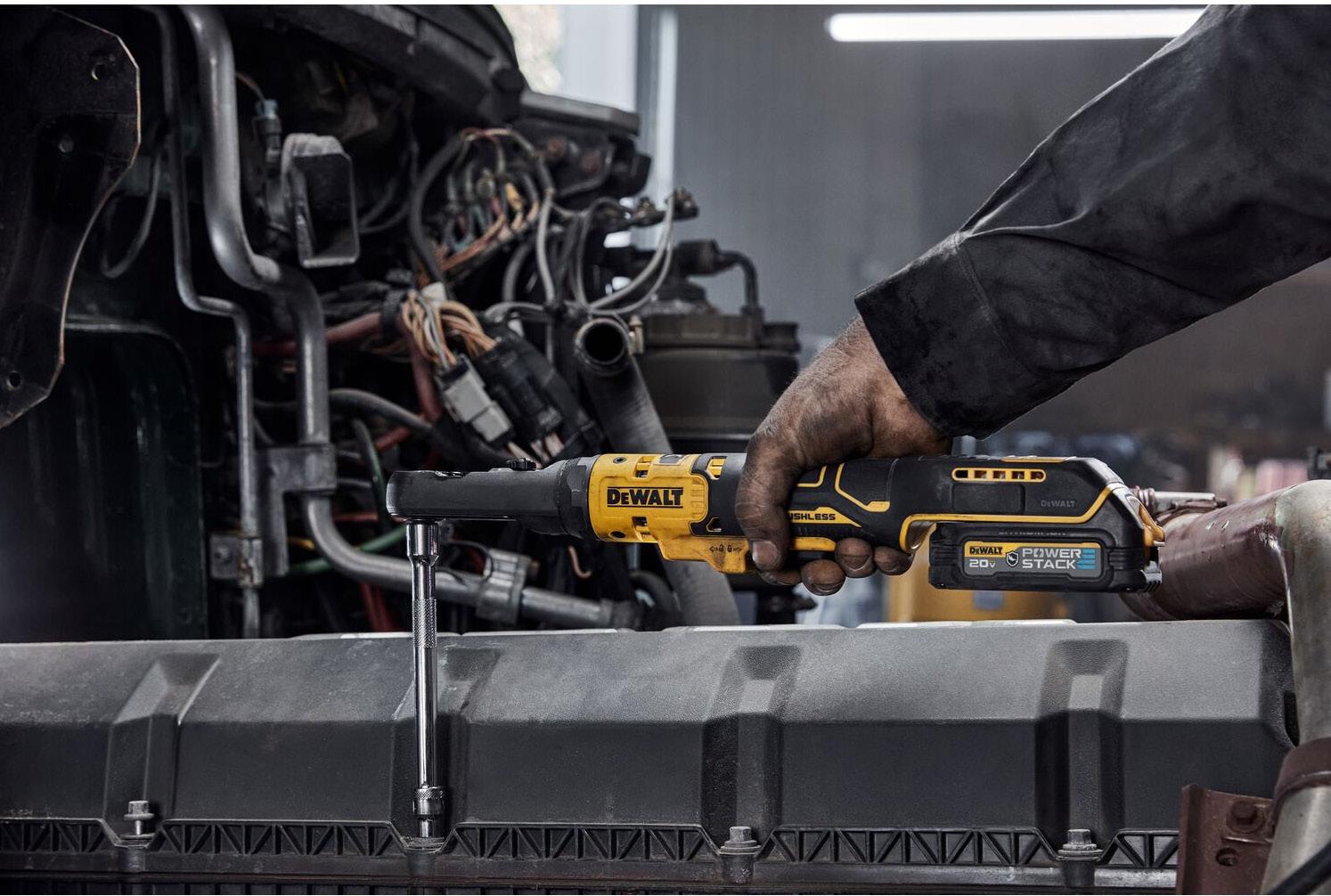
GPS Trackit E-commerce Platform
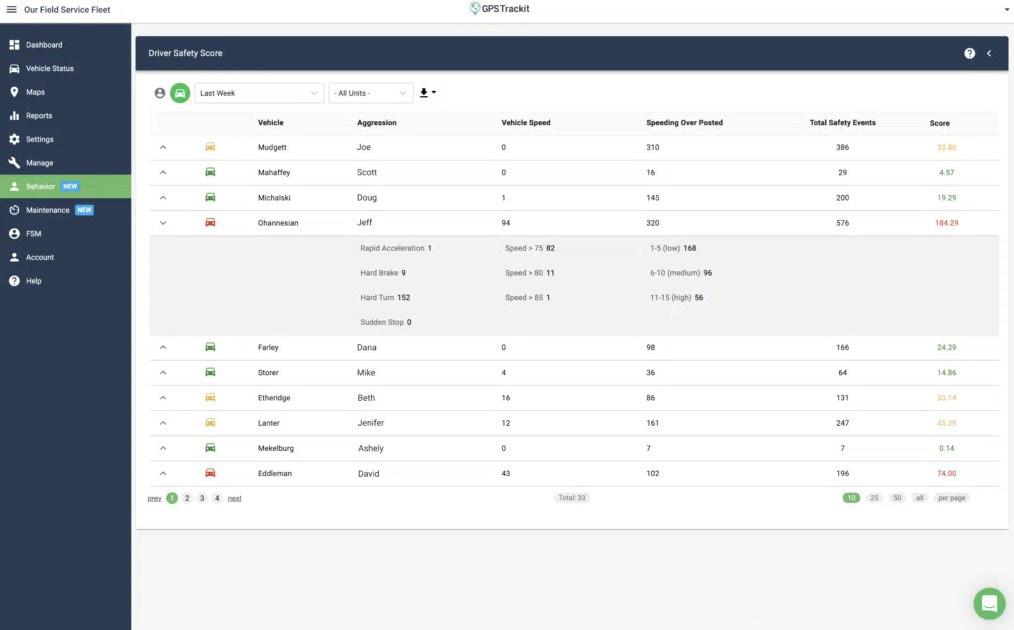



GPS Trackit has launched an e-commerce platform, offering a wide range of AI fleet management, telematics and video solutions. This new store caters to demand for reliable fleet tracking solutions in a marketplace format. The new e-commerce platform enables individuals to browse, select and buy GPS trackers and video telematics products. With an intuitive interface and product information, the platform helps customers find the solution they need under flexible options and decide if they want to purchase by themselves or receive guidance from GPS Trackit’s network of experienced Fleet Advisors.
SafeGauge SafeTest Wireless Tachometer Series

The SafeGauge SafeTest TM Series enables wireless rpm measurement of machines on the jobsite for performance testing, inspections and maintenance. This solution removes technicians from the live work area while measuring the speed of fans, pumps, drill heads and other rotating machinery components. This rugged, noncontact laser tachometer is designed to facilitate measurements in harsh working environments, where hazards could compromise the safety of technicians. Individuals can use the MultiTool to capture multiple rpm measurements at the same time.
Hilltip Interchangeable Winter Maintenance Bed
Compatible with major brands of cable-hoist truck body systems, the new bed offers performance for winter maintenance professionals. A functional feature of the Winter Maintenance Bed is a rear cutout to fit and protect a salt spreader chute. This specialized design allows the spreader to be mounted farther forward on the truck, resulting in weight distribution and shorter overall length. De-icing sprayers also fit on the Winter Maintenance Bed for versatility. During the offseason, hinged stand-up legs allow the bed to be dismounted with the spreader still installed. The legs are fully boxed and painted for durability. If a spreader is not permanently installed, the bed can be dismounted without the legs using the included roll-off kit.
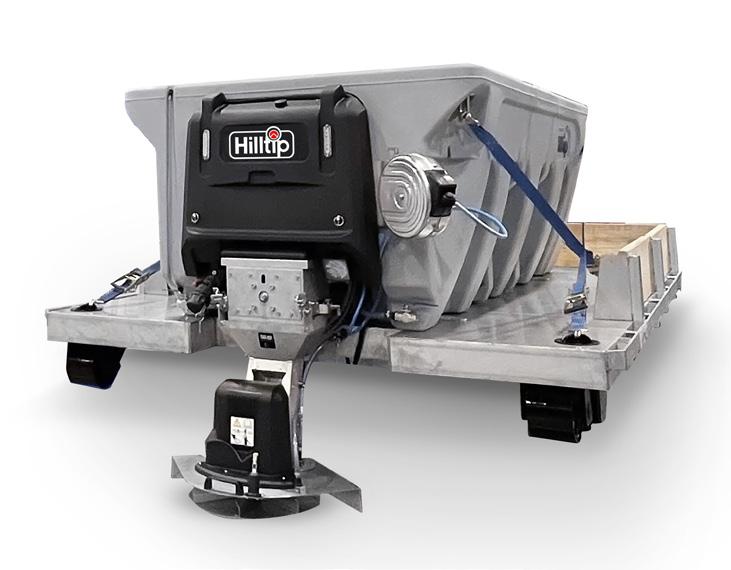
August 2023 | EQUIPMENT TODAY 23 FLEET MANAGEMENT Products
AERIAL LIFTS: Elevating Safely With Stability
While aerial lift equipment such as scissor lifts and boom lifts provide workers a safe way to reach an elevated work position and stability in completing work, new technology and ANSI A92.20 design standards amplify that safety.



“Platform sizes vary to accommodate narrow spaces or allow for more tools and equipment,” said Bob Begley, JLG director of product management. “Both boom lifts and scissor lifts provide access to otherwise inaccessible aerial jobsites. The key to selecting the right lift—boom or scissor—for the job is understanding what you need to accomplish on jobsites.”
ANSI Standards Provide Design Updates
Brian Rabe, Manitou product marketing manager, noted the new ANSI A92.20 design standard implements design-related updates for original equipment manufacturers (OEMs), amplifying the safety features of aerial lifts.
Mobile elevating work platforms (MEWPs) now measure how level the machine is by using an inertial measurement unit. The machine will shut down lift, telescope and drive capabilities if the equipment is out of level when elevated. The out-of-level setting varies by model and machine type, Rabe noted.
Addressing load-sensing hydraulics, MEWPs now measure weight in the platform and stop elevating if overloaded. Indicator
Sensors actively monitor the machine’s platform load and sound an alarm as well as interrupt normal operations if it is overloaded.
lights show and warn operators when the platform is overloaded. MEWP platforms will stay within the safe operating load envelope and range of motion based on the weight in the platform, preventing potential incidents.
New MEWPs require wind stability testing and identification. Operators must select “wind” or “no wind” depending on their exposure. An ID plate includes a wind rating. Exposure to wind may limit occupants and the
height of the equipment. Maximum wind speed if the MEWP is rated for wind is still 28 miles per hour, Rabe noted.
The new standard requires a guardrail height of 43.5 inches
compared to the previous 39.5 inches. Gates with toe boards and hinged doors have been added to improve ease of access and operator safety. For stability testing, foam or solid tires are required. Manufacturers test
24 EQUIPMENT TODAY | August 2023 www.ForConstructionPros.com/Equipment LIFT EQUIPMENT
New ANSI regulations and technology make scissor lifts and boom lifts even safer.
JLG
JLG JLG
New MEWPs will be equipped with load-sensing and tilt-sensing technology to ensure that operators remain within the capacity limits of the machine.
and verify them during assembly and pre-delivery inspection, noted Rabe.
The safe use standard (ANSI A92.22) and the training standard (ANSI A92.24) were updated to assist users, operators and owners in understanding operational differences and applying the new safe use features of new machine designs, said Rabe.
The standards cover most aspects of MEWP design and use, including an update to the terminology used for aerial work platforms, referred to in ANSI A92 standards as MEWPs, Rabe noted, adding that the terminology helps make ANSI A92 standards more consistent with other standards.
The updated standards are intended to reduce accidents and further educate operators, supervisors and occupants on the new MEWPs features and how to apply them to the jobsite, Rabe noted.
They apply to every operator and business using MEWPs, said Rabe, adding the Manitou MEWPs train the trainer program or another manufacturer accredited program can assist in educational efforts.
Rabe said new safe use and training standards require training for supervisors who are responsible for proper selection of the MEWP for the work to be performed and must understand the rules, regulations and standards applied to MEWPs and potential hazards associated with their use.
MEWP occupants must use personal fall protection and be trained in safe use of MEWP accessories, site-specific work procedures and taskrelated hazards.
Operators must be properly trained, authorized and familiarized with the MEWP before use, Rabe said.
In addition to proper training, the standards require that annual inspections be identified on the MEWP and be part of the prestart inspection, with the annual inspection needing to occur within 13 months of the current date.
The standards include a risk assessment to identify potential hazards associated with a task and specific work environment, said Rabe, adding operator responsibilities include assessing risk for overhead hazards, ground support, platform capacities, material handling, and a rescue plan.
MEWPs Incorporate Safety Features
Rabe noted that Manitou MEWPs meet all aspects of the revised ANSI 2021
operators remain within the capacity limits of the machine. The sensors actively monitor the machine’s platform load and sound an alarm as well as interrupt normal operations if overloaded, Hoover said, and jobs can no longer be completed if overloaded.
Because the machine’s lift and drive functionality will shut down if the machine’s total platform load weight exceeds the machine’s rated platform load capacity, it means operators need to pay close attention to what is contributing to the MEWP’s load, Hoover added.
“It’s important to know that the machine’s load capacity is not just calculated by the number and weight of people on the platform,” Hoover said. “It also includes tools and
requirements in the current standards are very similar, said Begley. “Machines that could previously only be operated on level surfaces can now be used on slight slopes; however, a tilt sensor is required,” he added. “The tilt sensor sounds an alarm and disables boom and drive functions if the incline surpasses the machine’s rated slope tolerance.”
As with load sensing technology, each MEWP OEM has its own unique tilt sensing solution. For example, the JLG ANSI 92.20-compliant tilt sensor technology allows operators to use restricted functionality to return the machine to a work area within its allowable operating range, said Begley.
“Once the machine recognizes that it’s back within its rated zone, operators are able to reposition the machine or grade the worksite to complete work within the rate load and slope tolerance of the machine,” he added.
Hoover noted that recent safety technologies for MEWPs also have focused on developments that contribute to operators’ productivity in space-restricted areas.
New technology is now available to help make MEWP operators more aware on the jobsite by giving them a better sense of their immediate surroundings.
“For example, MEWPs equipped JLG SkySense, an electronic detection system, have strategically placed sensors providing visual and audio alerts to inform the machine’s operator they are approaching a structure,” Hoover added.

design standards.
Manitou’s new MEWPS range is designed with end cushioning in both directions on almost all hydraulic cylinders and to smoothly perform up to four simultaneous functions, said Rabe.
Manitou offers flotation tires for greater stability and traction while operating MEWPs on soft ground.
The company has implemented a machine-specific QR code decal on the machines, offering anyone with a smartphone instant access to safe operation videos, operators’ manuals and other materials.
“Updates to the ANSI 92 standards in effect in the U.S. have resulted in increased demand for the newest safety technologies in aerial equipment,” said Nate Hoover, JLG director of product management, boom lift.
Hoover noted that the revised standards require new MEWPs to be equipped with load sensing and tilt sensing technology to ensure that
materials as well as the personal gear of operators and occupants such as hard hats, tool belts, jackets, boots and so on.”
The machine’s load sensors will capture any weight added by what the machine may contact in the work area, such as a ceiling joist, a rafter, an overhead beam or a window ledge.
“It will cut out at once should the weight exceed its maximum platform capacity,” said Hoover.
Advanced Sensor Technology
Some manufacturers such as JLG have built-in sensor technology that is advanced enough to allow operators to respond to an overload situation quickly and easily, Hoover added.
“By simply removing or unloading items from a JLG machine’s platform, for example, the MEWP will recognize when it is back within its rated load capacity, enabling operations to resume without the need to recalibrate the machine,” Hoover noted.

The machine tilt sensing
“These sensors initiate the slowing down of the machine as it nears the structure, sounding an audible beep that increases in pace the closer it gets before stopping the unit completely. In situations where the MEWP must get closer to the structure once it is stopped, the operator can override the sensor technology to inch slowly towards the structure to place the machine nearer to the desired work area.”
Begley pointed out that mobile apps are becoming more prevalent on jobsites with many designed to improve the operator’s experience with the machine before work begins.
Augmented reality apps allow users to scan the MEWP’s safety decals to get the current information on ANSI standards’ requirements and to see an overlay of a specific machine’s control panel with explanations of its functions prior to machine operation.
He added that these same mobile apps can offer remote control of a scissor lift without tethering to the machine, allowing users to:
˜ Maneuver around obstacles while maintaining a safe distance from the machine
August 2023 | EQUIPMENT TODAY 25 www.ForConstructionPros.com/Equipment LIFT EQUIPMENT
Sensors initiate the slowing of the machine as it nears a structure, sounding an audible beep that increases in pace the closer it gets before stopping the unit completely.
JLG Snorkel
Some scissor lifts offer an ultrasonic sensing system that detects overhead obstructions.
THE EBAY WAY
TRAINED PROS
End-to-end expertise, from the professionals who inspect your equipment to the support team who answers your every question.
DETAILED
REPORTS
Verified Condition you can rely easy-to-read grading all important features equipment.
START
Looking to buy heavy equipment now or in the future?
THE HARD WAY
“EXPERT” STRANGERS
You hop on a few national and local listing sites and find some equipment being sold by individuals or businesses you don’t know.
Do they respond to your call or email?
YES [CONTINUE]
NO [BACK TO START]
AMATEUR REPORTS
Your deal is dependent accuracy. As a buyer find yourself scouring reports.
Seems [CONTINUE]
Blurry photos?
Unbelievable glamor [BACK TO
Find the equipment you
www.ebay.com/heavyequipment
DETAILED REPORTS
Condition Reports on with an report card the most features of your equipment.
PROTECTED PURCHASE
Your equipment is ensured to be authentic with Business Equipment Purchase Protection up to $200,000 on equipment that’s up to 20 years old. We’ve got your back.
AMATEUR REPORTS
dependent on buyer you could scouring unreliable reports. legit. [CONTINUE] photos? glamor shots? TO START]
TAKE YOUR CHANCES
You’ve set a safe meetup location for your equipment to change hands and found a way to make payment safely.
[CONTINUE]
Deal fell through or wasn’t what you expected [BACK TO START]
FINISH
Congratulations on your deal!
need
now with eBay
www.ebay.com/heavyequipment
˜ Position it into areas with low clearance
˜ Load or unload it from a truck without the need for an operator on the platform or walking next to the machine
Hoover said one of the best ways to continue advancing safety is for original equipment manufacturers to develop practical technology solutions solving real-world jobsite challenges, like working on uneven terrain.


“Recent advancements in machine suspension technology have been developed to address this scenario,” he added. “Self-leveling for boom lift and variable-tilt for scissor lift technologies are designed to adjust the machine’s chassis to the ground conditions rather than trying to adjust the ground conditions for the machine.”
With self-leveling technology, the machine automatically levels all the time, even when driving the unit elevated.
Hoover noted one major benefit of this technology is that operators and occupants will feel more stable during travel as a result of less bouncing of the unit when it is traversing rough or uneven terrain, improving operation and reducing fatigue.
It also minimizes the need to crib and/or grade the work area. In addition, it mitigates the trial and effort of repositioning to find a level work area, translating to improved operator productivity, he added.
Begley noted that variable-tilt technology for scissor lifts is designed to adjust the machine’s chassis to ground conditions rather than trying to adjust the ground conditions for the machine. That is important because most slab scissor lifts cannot elevate when working on a side slope greater than 1.5 degrees, he added.
“But with variable tilt technology, which is designed to maximize a scissors lift’s height based on the slope on which the machine is positioned, scissor lifts can now elevate on side slopes up to 3 degrees,” he added. “This gives the operator a greater
degree of flexibility and most importantly keeps machines operating within the approved work envelope.”
Operators will now know how much material they can take up with them more or less than what they already have loaded, said Begley.
“They also will know if they need to reposition the machine in a spot that’s a little bit more level so that they can get the full height,” he added. “This technology removes the guesswork that often results in operators having to descend and try again.”
Load & Motion Sensing
Jeffrey Eckhardt, PE, vice president and chief engineer at Ahern Engineering, the engineering side of Snorkel International and Xtreme Manufacturing, noted that, with the adoption of the new ANSI standards, platform load sensing and motion sensing is mandatory on most machines that his company offers and that every manufacturer is implementing some form of solution.
“Some industry solutions are not part of the standard’s mandated safety equipment but are gaining in popularity, such as secondary guarding,” he added.
Eckhardt said that secondary guarding entails a method to either actively or passively restrict or stop a machine’s movement should the platform or operator contact overhead obstacles.
“There are many solutions for this, with some also restricting movement if an obstacle enters a region around the platform through the use of ultrasonics, radar, LiDAR or other noncontact sensing methods,” he said.
“Our system, Snorkel Guard— standard on all new boom lifts since 2015—works by stopping all machine movement if the guard is activated by the operator or any solid object,” Eckhardt said. “The machine immediately ceases movement and requires the operator to remove the contact or via an override switch move the machine to clear the engagement
with the obstacle, using their decisions and thought processes.
“If the operator is fully aware and conscious, we want them evaluating and analyzing the situation,” he added. “If the operator is incapacitated, an operator on the ground can gain full operation of the machine and retrieve the elevated worker by lowering the machine.”
On scissor lifts, Snorkel International offers an ultrasonic sensing system that senses overhead obstructions.
“As you are elevating or driving, it will stop the machine from moving as an overhead object approaches the platform,” said Eckhardt. “At that time, the operator can readjust and make the decision on what they need to do. The idea is that the operator is not caught by surprise from an overhead obstacle.”
Snorkel International offers an optional Personal Fall Arrest System (PFAS) for many boom models that permits personnel to safely exit the platform while continuing to be anchored to the machine, allowing them to reach areas not accessible to workers inside the platform.
“Somebody working on an elevated floor or an airplane wing can use the boom to transport and reach the area where they need to work and exit the platform to reach the work site, but still be attached fully to the boom structure,” says Eckhardt of the technology that provides compliant fall arrest protection.
The company’s high-capacity scissor line offers a 27-foot deck when both power decks are extended.
“This permits loading 24-foot-long pieces of conduit or piping and keeps the materials completely inside the perimeter of the platform, so they don’t have that obstruction hanging outside or up over the platform guardrails,” says Eckhardt. “It is also not an impedance to operators being able to freely move around inside the platform.
“With some platforms, you almost
have to duck underneath a 24-footlong piece of conduit as they are hanging out over one or both ends of the platform,” he added. “Further, you have to worry about these items catching on existing structure when elevating or lowering the platform.”
LiDAR & AI Sensors in Equipment
To protect the operator from potential risk of crushing, EQSS supplies OverWatch for all makes of scissor lifts. With a LiDAR sensor at its core, OverWatch detects the operator’s position and movements and intervenes only when their safety is compromised, said Andrew Delahunt, EQSS global business development manager.
“It does not interfere with normal operation of the scissor lift,” he added. “Instead, it continuously monitors the operator’s position using an infrared light beam. The system can determine when an operator has moved abruptly or is in a dangerous position, either of which will immediately stop the lift. The system is human-centric. It’s designed simply to protect the operator and prevent serious or fatal incidents.”
OverWatch features a small sensor that attaches to the scissor lift control box and is paired with a powerful processor running advanced sensor AI fusion algorithms to track operator and machine movement to identify when a shutdown is required, working in all weather conditions, said Delahunt.
Delahunt said Haulotte recently integrated OverWatch as a factoryinstall option on its latest generation of electric scissor lifts.
Read more at: https://eqtoday.co/ScissorBoom
28 EQUIPMENT TODAY | August 2023 www.ForConstructionPros.com/Equipment LIFT EQUIPMENT
Carol Brzozowski is a freelance writer for Equipment Today
New safe use and training standards require training for supervisors who are responsible for proper selection of the MEWP for the work to be performed and must understand the rules, regulations and standards applied to MEWPs and potential hazards associated with their use.
Manitou Manitou
Manitou’s new MEWPS range is designed with end cushioning in both directions on almost all hydraulic cylinders and to smoothly perform up to four simultaneous functions.
Where the Utility Industry Goes to Grow
The largest and fastest growing trade show for the utility infrastructure and construction industry is back. Experience the latest technologies, innovations and trends through live talks and hands-on demos in our expansive layout.


SEPTEMBER 26-28 | 2023 | LOUISVILLE, KY 1.4 MILLION square feet of exhibits OVER 19,000
32 ACRES of equipment and services
attendees
Register now at theutilityexpo.com and
save 20% with code PARTNER20
IPAF Regional Manager Talks Lift Equipment Safety & Certifications
When talking lift equipment, the Equipment Today team had to get insight from Tony Groat, North America regional manager, for the International Powered Access Federation (IPAF). In this Q&A, Groat discusses safety, certification and more.
What are some important reminders for contractors about keeping operators safe on scissor and boom lifts?
The start to any product’s safe use is the awareness of applicable rules and regulations. While the Occupational Safety and Health Administration addresses aerial lifts in its regulations, they were written in 1970 and address scissor lifts as “rolling scaffold towers.” This is not the most effective way to ensure operator safety. I suggest contractors purchase a copy of American National Standard Institute (ANSI)/ Scaffold & Access Industry Association (SAIA) safe use and training responsibilities from SAIA on the website www.saiaonline.org.
This standard provides the most current industry best practices for employers—mobile elevating work platforms (MEWP) user—and their operators. This begins with the creation of a MEWP safe use plan that starts with a site risk assessment.
IPAF offers a guide for the development of a safe use plan “Developing a MEWP Safe Use Program Guide” to assist employers
The key is to ensure that the operator is properly trained on the MEWP category and then familiar with the model-specific machine before being authorized to operate it.
The operator must be aware of the results of the risk assessment that identify potential hazards and the safe work procedures, including any contingencies required, in carrying out the identified tasks.
A main reminder is that safe use is how to be productive. The time, cost and delays caused by an accident can never be made up by the minutes to take shortcuts.
Some key best practices are:
˜ Operator training and machine familiarization before operation
˜ READ the machine operator’s manual
˜ Conduct a daily prestart inspection and isolate/tag/report any problems or malfunctions that are found
˜ Conduct a daily workplace inspection to ID any new hazards in the area of operation
˜ Stay at least 10 feet from any overhead power lines
˜ Know the machine controls and ensure that you know the direction of movement to avoid hitting/ crushing; particularly important with boom lifts that platform slew— direction of travel changes from forward to reverse
˜ NO machine modifications—do not add to or remove manufacturer parts or components
˜ Stay within the work platform and do not overload
˜ Review ALL ITEMS SPECIFIED BY THE MANUFACTURER (in the operator’s manual)
What certifications are available or required for operators of scissor and boom lifts?

A certification of completion for MEWP operator training for the category MEWPs is necessary before being approved to operate. This training should comply with ANSI/ SAIA A92.24-2018. This training requires both theory (classroom or online) training to address safeuse practices, potential hazards, how to perform a daily pre-use inspection and other detailed instructions covered in the safe-use standard. When the theory training is successfully completed, the operator must complete a hands-on practical evaluation for each MEWP category to be used.
MEWP operator training is general and operators must additionally receive model specific machine familiarization on the control functions, machine operating characteristics, and safety devices. This should be documented.
Industry best practices for MEWP training AWP/MEWP Operator Training Best Practice Guide can offer some added guidance. An important note is that familiarization can take 15 minutes to 60 minutes, and operator training can take three to six hours or
more, based on the number of trainees and MEWP categories. Don’t be fooled to believe that training can take place in an hour.
What else should contractors/operators know about the use of these lifts?
While aerial lifts or MEWPs are the safest ways to gain temporary access to work at height, all work at height is exposed to hazards that must be addressed. More than 70 workers die unnecessarily every year on this equipment. These fatalities are completely avoidable. This statistic does not come close to the number of workers who are injured or involved in a near miss (an accident waiting to happen).
While operators must be trained, those who directly supervise them must also be qualified to monitor, supervise and evaluate operators regularly to ensure their proficiency. Many MEWP online supervisor courses are available that can provide a great foundation for a supervisor to have the knowledge necessary to support safe MEWP operations. One example is MEWP Supervisor Training - USA - Virtual from United Rentals. Learn the potential hazards associated with MEWP operations with the IPAF Global Safety Report Analyses Ten Years of Incident Data, available at www.ipaf.org.
Read more at: https://eqtoday.co/LiftEquip
30 EQUIPMENT TODAY | August 2023 www.ForConstructionPros.com/Equipment LIFT EQUIPMENT | By Lori Ditoro, Editor-in-Chief, Equipment Today
IPAF
scissor lift
basics from this Q&A.
Learn some
and boom lift safety
TOP 4 BENEFITS of Spider Lifts
Adding a spider lift to your fleet provides you with ideal aerial access.
Spider lifts empower contractors to accomplish aerial work with ease, safety, and reliability. Their compact and lightweight design helps them access the most difficult-toreach jobs, navigate rough terrain, fit into tight spots and stabilize on uneven ground.
Thanks to these advantages, demand for spider lifts is growing. Adding spider lifts to your fleet will help you capitalize on this trend.
1. VERSATILITY
Spider lifts are helpful in industries such as:
˜ Tree care
˜ Construction
˜ Facility maintenance
˜ Stadium upkeep
˜ Painting
2. EFFICIENCY
Spider lifts feature many components to promote efficiency, such as:
˜ Compact size
˜ Low ground pressure
˜ Variable width outriggers/ stabilizers
˜ Variable-width rubber tracks
˜ Low weight to working height ratio These aspects will enable you to get to any jobsite easily, navigating all kinds of terrain and maneuvering to convenient positions for stable and comfortable aerial work.
3. SAFETY
Another benefit of adding a spider lift to your fleet is its safety features. Safety features can include stabilizers in the form of outriggers to ensure that the platform stays stable even on uneven terrain, auto-leveling and armored components.
4. RETURN ON INVESTMENT
With all these convenient benefits, spider lifts are high-value items for your company. They can perform many jobs, creating value by:
˜ Increasing uptime
˜ Lowering equipment costs

˜ Simplifying processes
˜ Increasing safety
˜ Ensuring stability
Read more at:
https://eqtoday.co/SpiderLifts0823
Tom Schneider is the vice president of operations at Tracked Lifts.
LIFT EQUIPMENT
Toyota Material Handling New Electric Forklifts


Toyota Material Handling launched three new electric forklift models. The new models feature a Side-Entry End Rider, a Center Rider Stacker and an Industrial Tow Tractor. The electric Side-Entry End Rider is available in 6,000-lb. and 8,000-lb. models and features an automatic parking brake and standard power steering. With a lift capacity up to 2,500 lbs. and lift height up to 72 in., the Center Rider Stacker is equipped with a multifunction control handle and optional additional controls. With a towing capacity of 15,000 lbs. on flat surfaces, the electric Industrial Tow Tractor is equipped with standard electric power steering and includes regenerative plugging. The design of this power player features a compartment sensor to encourage the operator to stand in the proper place.
Genie 13-ft. Boom Lift Platform
Compatible with Genie S-45 XC, S-65 XC and S-85 XC boom lifts, the 13-ft. platform is for tasks that involve an extensive work area, as well as jobsites with limited space to maneuver on the ground. The extra space in the platform also provides access to twice as much work area with the same number of boom movements, compared with a standard sized 8-ft. (2.44-m) platform. After following instructions to install the 13-ft. platform and calibrating the machine, the S-45 XC, S-65 XC and S-85 XC can carry up to two workers to height and deliver a 600-lb. lift capacity. Additionally, operators can use other features on Genie’s XC machines, including automatic envelope control, working curve and active load sense.

Manitou Construction Machines
Manitou Group launched four new aerial work platforms, rotating telehandlers and a fixed telehandler. The 200 ATJe rough-terrain platform (20m working height) is available with four-wheel steer and a basket that can take 250 kg of load. The range of roughterrain, electric telehandlers welcomes the 160 ATJe and 180 ATJe, with a working height of 16m and 18m respectively. These platforms also see their capacity increased to a total weight of 250 kg. The MT 625e electric compact telehandler has a capacity of 2.5 tons and a height of 6m. Manitou launched electric rotating telehandler models MRT 2260e and MRT 2660e with a loading capacity of 6 tons for a lifting height of 22m and 26m respectively.


Magni RTH 6.30
The Magni RTH 6.30 Rotating Telehandler is designed for lifting, elevated operations and transport on construction sites. This machine offers a maximum lift height of 98 ft. with a maximum lift capacity of 13,200 lbs. and a maximum lift height capacity of 5,500 lbs. Powered by a Volvo TAD572VE Tier 4 Final engine, the 6.30 offers four-wheel drive for stable operation in rugged work areas. The fourcylinder, diesel engine delivers 218 hp. This telehandler can travel at a maximum speed of 25 mph. The 6.30 offers the same dynamic features as all Magni models, including 360-degree rotation. Over 100 attachments provide users with several machines in one, including a telescopic forklift, rough-terrain crane and aerial work platform.

JLG SkyTrak 6034 and 6042 Telehandlers
Featuring a redesigned build, reworked functionality, improved technology and refocused serviceability, these 6,000-lb. maximum lift capacity telehandlers can be used for pick-and-place applications, such as handling, loading and unloading bulk materials. The new 6034 telehandler replaces the previous 6036 model, while the 6042 telehandler has been updated with new features. For example, these updated units feature a lower operating weight—14,500 lbs. on the 6034 and 19,100 lbs. on the 6042. The 6034 model offers a lift height of 34 ft. and a forward reach of 23 ft. The 6042 model provides a lift height of 42 ft. and a forward reach of 29 ft. Both the 6034 and 6042 offer three steering modes—two-wheel, four-wheel and four-wheel crab.

Bobcat TL519 Telehandler
The new TL519 telehandler is the most compact telehandler in Bobcat’s lineup, at just 6 ft. wide. It features a 74-hp engine, a 2-speed hydrostatic transmission and a standard Power Bob-Tach mounting system that allows operators to swap attachments without leaving the cab. The TL519 has a lift capacity of 5,500 lbs. and a lift height of more than 19 ft. The TL519 is also equipped with four steering modes and five operation modes for operator versatility. The advanced Tier 4, turbocharged engine delivers high-torque performance and achieves emission compliance without the use of a diesel particulate filter (DPF) or selective catalyst reduction (SCR). The engine features cold weather starting and a variety of features that support maintenance and service.

Pettibone Extendo 1544X Telehandler
Pettibone brings its X-Series telehandler lineup to the 15,000-lb. lifting class with the introduction of the Extendo 1544X telehandler. The added load capacity supports material handling tasks in highway construction, for pipe yard applications and for extended load requirements on traditional building sites. The machine is powered by a 117-hp Cummins QSF 3.8 Tier 4 Final turbo diesel engine and has a maximum lift height of 44 ft. and maximum forward reach of 29 ft. The telehandler has a maximum load capacity of 15,000 lbs. Other features include formed boom plates for boom structure strength while reducing weight, hydraulic circuit for controllability and operating feel, standard X-Command telematics for real-time access to machine data and all-steel fuel and hydraulic tanks built to resist damage.
Hyundai Material Handling New Forklifts
Hyundai Material Handling introduced a series of new forklift products, powered by diesel fuel and lithium-ion batteries. The new forklifts support lifting and transporting operations in busy jobsites. The 9V series adapts Hyundai’s powertrain for durability of transmissions and drive axles. It includes the 25/30D 35DN-9V Diesel Pneumatic Forklift Series which offers a Hyundai diesel engine that meets all EPA/CARB Tier-4 regulations. This product features heavy-duty handling, safety features and a new digital-type cluster with MCU function. Available capacities include 5,000 lbs., 6,000 lbs. and 7,000 lbs. Another offering in the 9V series is the 100D-9V with a 22,000-lb. capacity. The 100D-9V is equipped with a Cummins diesel engine.
32 EQUIPMENT TODAY | August 2023 LIFT EQUIPMENT Products www.ForConstructionPros.com/Equipment Read More at https://eqtoday.co/LiftEquip
SURFACE PREPPING BLADES: Which Tool Is Best?
How the right blade tool choice impacts floor removal rates.
When you watch a professional chef at work, you might notice that they’re using a selection of knives.
That’s because chefs, like any craftsman, will select a tool based on the task—for example, while one knife might easily cut through vegetables, it might be impossible to use it for filleting fish.
Similarly, contractors have different blades at their disposal for different surface preparation jobs, but is it always clear which blade is best to use?
Let’s look at the variations between different types of blades for floor preparation and when to use each.
When preparing for any surface preparation job, contractors will assess the jobsite to determine the current floor material and condition, access to the space, and power availability. These parameters will influence machine choice.
For example, a walk-behind scraper will easily remove soft goods on higher floors with weight limitations.
In contrast, a ride-on scraper works
better when removing hard goods in larger, ground-floor spaces.
While contractors often take the time to select the best type of floor scraper for material removal, it’s not always the same case when it comes to tooling choice. Instead, some contractors may call a supplier part way into their job claiming that the machine is broken. However, when the supplier looks at what they’re doing, the machine is fine; they’ve just selected the wrong tool for the job.
So, how do contractors select the right tool?
PERFORMANCE NOT VALUE
It might sound cliché, but in most cases, it is true that you get what you pay for. This is particularly true for surface preparation equipment tooling where I often see contractors trying to save money by selecting the thinnest blade on offer for their rideon scraper.
While thinner blades are the cheaper option, they are designed for smaller jobs and walk-behind scrapers, so they are likely to wear down quickly on a larger machine and tougher application. As it gets dull, contractors can increase the angle of the tool to remove material, but this can cause the metal to bend, making work harder or stopping it completely. Alternatively, using a blade that is too long or wide during floor removal
can slow production. Concrete will never be completely flat—the aggregate used in the material will cause some undulations. As a result, using a longer blade against concrete means that contractors must move slowly to ensure that they only remove the covering or adhesive, leaving the concrete intact.
Consider this comparison: If a contractor is using a longer, 14-inch blade on concrete, they might have to move so slowly that they can only remove 10 feet of a material per minute. However, if they swapped to a 10-inch blade in the same application, they could remove 100 feet of material per minute.
Contractors might not always know which blade is best for the job. However, just as chefs have multiple knives in their restaurant, contractors should consider having a toolkit of multiple blades onsite. They can start with one blade and if removal begins to slow or the blade becomes blunt quickly, they can drop down until they find the right tool for the job.
BEVEL UP OR DOWN?
When selecting a blade for floor removal, should a contractor choose a bevel-up or a bevel-down blade? Often, when talking to contractors, they are unaware of the difference between the two, let alone when to use each type.
A blade with the bevel up—where
the angle of the blade can be seen from above—is best for removing flooring from concrete. A blade with the bevel down—where the bevel is underneath and cannot be seen—is best for removing a covering from wood. One way to remember it is as bevel-up blades are for downstairs, where contractors are more likely to use ride-on scrapers on concrete, and bevel-down blades are for upstairs, where contractors use lighter walkbehind scrapers on wood.
When removing a covering or adhesive from concrete, using a bevelup blade at a higher angle creates more pressure to separate material from the substrate. However, if the same blade is used on a wooden substrate, that pressure would hit the wood, scratching the surface. Instead, having the bevel on the bottom allows the tool to glide over the wood.
If a contractor finds that floor removal rates are low, it doesn’t necessarily mean that the machine is broken. Preparing a floor is like preparing a meal, if you take the time to select the right tools for the job, you can be more precise and end up with a better result.
Read more at: https://eqtoday.co/Concrete0823
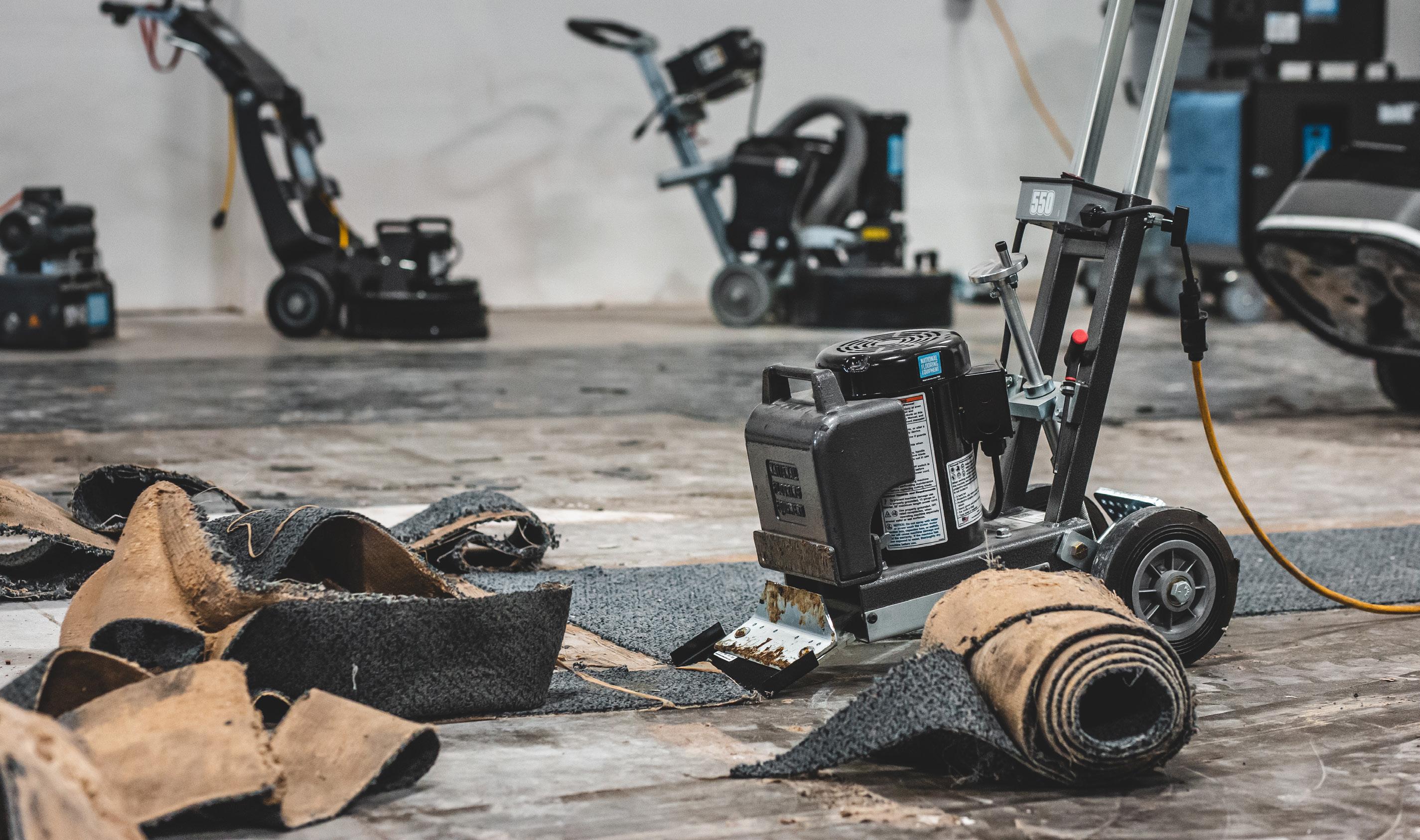
August 2023 | EQUIPMENT TODAY 33 www.ForConstructionPros.com/Equipment CONCRETE EQUIPMENT
Dave Bigham is the global director of training at National Flooring Equipment.
National Flooring Equipment
Contractors have different blades at their disposal for different surface preparation jobs but isn’t always clear which blade is best to use. It’s good to know the variations between different types of blades for floor preparation and when to use each.
Exploring Concrete Screed Options
For concrete contractors, few purchases are more essential than a screed.

For concrete contractors, screeds are an essential purchase and a critical tool for providing the smooth, level finish for concrete work. By carefully considering the screed types available, contractors can see maximum productivity from their investment.
The most common screed categories include roller, truss, laser, power and hand screeds. Each screed has its own features that, when aligned with project goals, can improve the return on investment. Here is a breakdown of the features and benefits of the most widely available screeds on the market today.
HAND SCREEDS FOR LOW COST
Classic hand screeding, which traditionally uses a wooden board, might be appropriate for the one-off small concrete job, but any serious contractor knows the life-long pains that come from years of stooping over a heavy board and sawing it back and forth along forms to screed concrete. Although the materials have evolved from hefty two-by-four lumber to lighter-weight aluminum alloy bars, the design and method has largely remained unchanged.
In addition to the back-breaking labor, hand screeding methods using boards require the skill of an experienced professional to remain true to grade and achieve consistent results since there’s no mechanical
assistance. This can prove challenging on large pours, even for a person with decades of experience.
POWER SCREEDS FOR SINGLE OPERATORS
In what could be considered an assisted hand screeding method, power screeds, also known as wet screeds, consist of an engine or electric battery-powered motor and an extended handle placed in the center of a traditional board or blade that is in contact with the concrete. Power screeds use vibration to help the blade level the concrete. These require a lot of skill and experience by the operator.
Although more ergonomic and efficient than hand screeding, power screeds require the operator to
stand in the poured concrete while screeding. The vibration has similar benefits and drawbacks to that of the truss screed. Because of their oneman operation and center support, manufacturers typically limit the blade widths to around 15 feet.
ROLLER SCREEDS FOR VERSATILITY
Roller screeds broadly consist of a detachable pipe connected to a drive head with an extended handle for upright, ergonomic operation. These screeds are known for their minimal setup; low learning curve; and consistent, quality results with less reliance on the operator’s skill level. Roller screeds use a spinning motion to move concrete, a method that
Adobe Stock Images | By Kadmy 34 EQUIPMENT TODAY | August 2023 www.ForConstructionPros.com/Equipment
reduces operator fatigue and allows for improved integration of aggregate throughout the pour compared to vibratory methods that cause the aggregate to settle. These screeds are versatile and can be used for different pours, often up to 22 feet to 30 feet wide, depending on the power source.
The roller screed’s detachable design also makes for a highly portable option. Some manufacturers even
offer linkable pipe sections to increase portability and versatility. General features like a three-way adjustable and lockable handle for improved ease of operation and a kickstand to keep the drive head and handle out of the concrete allow crews to quickly adapt to jobsite needs. Contractors have four different power options to choose from: battery-, corded-, hydraulic- and gas-powered.
Battery-powered roller screeds are easily maneuverable and handle pours up to 22 feet wide. These versatile machines can be especially useful for contractors working in basements, in indoor factory settings, at farms or in communities in remote locations.
Depending on the slump and pipe length, a contractor can screed off 1,800 square feet to 2,500 square feet of concrete with just one fully charged battery. Since the battery operation provides fume-free screeding for those working in any closed-off environment where fumes may be a hazard, no additional power source such as gasoline, hydraulics, or a generator is required. That means fewer transportation needs, reduced setup time, and no cords or hoses in the way. Some battery-powered roller screeds also provide cross-platform use with the same rechargeable 60-volt lithiumion battery that is found in common handheld power tools.

For special projects such as circular pours, battery-powered roller screeds provide a convenient single pushbutton directional change. This allows contractors to easily change their screeding direction to avoid cold joints or other structural flaws that can occur with an uneven cure.
Corded electric roller screeds enjoy many of the same benefits and capabilities as battery-powered roller screeds. They are fume-free for indoor jobs and some have a single push-button directional change for screeding unique pours. With a nearby outlet or generator, contractors
can have the reassurance and convenience of seemingly endless power.
While enjoying the convenience of power, contractors must consider proper care to ensure that cords don’t become tangled, unplugged or damaged while on the jobsite. And relying on a separate power source, like a generator, can come with its own worries. That can include staying on top of fuel availability, general maintenance or fume concerns.
Hydraulic-powered roller screeds have the capacity to move up to 6 inches of concrete along a pour while the operator remains in a standing position. They also accept any 6-inch tube length up to 30 feet, while some manufacturers also offer custom drums made to different job specifications such as sidewalks, parking lots, residential streets, large highway ditch liners and more.


Some heavy-duty applications, like road drainage and ditch liner pours, require large custom drums and a screed powerful enough to drive them. This is where hydraulic roller screeds shine.


Hydraulic-powered roller screeds have the capacity to move up to 6 inches of concrete along a pour while the operator remains in a standing position. Additionally, most hydraulic roller screeds accept 6-inch tube length up to 30 feet while some manufacturers also offer custom drums made to various job specifications such as sidewalks, parking lots, residential streets and large highway ditch liners.
Like corded screeds, hydraulic screeds require a separate power source. Look for a manufacturer that provides a portable hydraulic power pack to match their hydraulic screed’s exact specifications. With this option, contractors don’t have to tie up a host machine to power their hydraulic screed. To take on heavy-duty jobs, these are also generally heavier at two to three times the weight of battery and corded roller screeds. Contractors should consider how to accommodate the additional weight before committing to these screeds.
Gas-powered roller screeds have a similar setup as the other roller screeds but with a motor attached to the drive head. These screeds offer another option for contractors who
August 2023 | EQUIPMENT TODAY 35 www.ForConstructionPros.com/Equipment CONCRETE EQUIPMENT
Roller screeds are known for their easy operation; low learning curve; and the consistent, quality results they provide with less reliance on the operator’s skill level.
A vibratory truss screed.
Battery-powered roller screeds provide a convenient and maneuverable screed option. Some even use the same rechargeable 60-volt lithium-ion battery found in common handheld power tools.
Curb Roller Manufacturing
Inc. Kadmy, Adobe Stock
Curb Roller Manufacturing
Multiquip
Curb Roller Manufacturing
CONCRETE EQUIPMENT
typically screed large pours that require a longer pipe, often up to 30 feet wide. The motor produces screeding power that rivals that of hydraulic screeds and offers a viable, familiar alternative for those preferring a gas engine.
More care is required as a gaspowered screed motor needs to be in an upright position to avoid gas and oil leakage. This can prove more challenging because of the engine’s weight on the drive head.
These screeds have location limitations as well. They cannot be used indoors due to the exhaust and fumes from the engine. Engine vibrations present another concern. The high vibration from the engine can cause the throttle cable to slip and need continuous readjusting.
TRUSS SCREEDS FOR LENGTH
Truss screeds level off the concrete often featuring a vibration motor. These screeds are expandable and come in multiple sections that resemble a truss design to help maintain rigidity for longer widths, even beyond 60 feet. Because of this ability to screed such a width at the same time, truss screeds can be an excellent option for larger jobs, like screeding an entire roadway, slabs-ongrade and bridges.
Vibrations from a motor attached to the truss carry throughout the screed as contractors guide it on concrete forms, flattening and settling the concrete to remove trapped air, increase concrete strength and provide a smooth finish. However, because of the vibration, it is generally not recommended to use a truss screed on a slope. The aggregate in concrete tends to settle with vibration and unevenly dispersed aggregate can create spots of varying strengths that can result in structural flaws and damage over time.
Truss screeds can be powered by an engine or air, with the latter preferred for indoor jobs or tunnels
when a combustible engine would be prohibitive.
Giving contractors the ability to expand the truss and screed blade needed for the project, it’s common for truss screeds to come in sections of various lengths.
Additional sections can be added to achieve a maximum width and some models may have limits. Best practices suggest selecting a screed width that allows a minimum of a 6-inch overhang past the concrete form.
LASER SCREEDS FOR EXTREME PRECISION
Laser screeds are growing in popularity for larger concrete pours and those that require a high degree of precision. This category of screed equipment can be found in different styles ranging from telescopic (boom), ride-along (drive-in) and lightweight machines. The screed’s laser arm ensures that a precise, accurate and evenly leveled surface while reducing the need for excessive labor. Some of the widest laser-guided boom screeds available can have a maximum working width of 20 feet.
An average laser screeding work can range from to 130 square feet to 220 square feet of concrete in a single pass depending on the size of the machine and head—making this equipment a game-changer for the concrete industry.


Options can include a roller head, different widths, paver screed, front drive tracks, or high-float wheels. However, the tracks are likely available for select models. Some modern screed heads can be replaced in minutes instead of hours—providing more time and labor savings at the jobsite.
Telescopic
˜ Standard head width range: 8 feet to 12 feet 6 inches (some models include a travel distance for their screed heads, shorter and wider head options may be available for some models)
Born with a long reach and a wide pass, this machine was built to screed more and screed faster. Complete with an ultra, heavy-duty boom reaching 20 feet with an all-new Ultra Performance 14 feet 6 inches screed head. Powering this screed is a 45-horsepower Kubota turbocharged diesel engine. For inscreased maneuverability and traction, this screed includes selectable four-wheel drive with a 2-speed drive range and four-wheel independent steering.
˜ Telescopic boom reach range: 12 feet 5 inches to 50 feet
˜ Machine weight range: 2,840 pounds to 22,000 pounds
˜ Some models are controlled by wireless remote control or ride-on operator
Ride-Along | Ride-On
˜ Head width range: 6 feet to 10 feet
˜ Machine weight range: 1,107 pounds to 1,775 pounds
˜ Controlled by an on-board control system
Lightweight
˜ Standard head width: 6 feet 8 inches to 10 feet
˜ Machine weight range: 546 pounds to 1,280 pounds
˜ On-board control While laser screeds bring benefits including ease of use and reduced labor expenses, they can be costly and are powered by diesel or gasoline engines.
A CASE FOR QUALITY
Jobs in a concrete season vary as much as the tools themselves. Contractors should carefully consider the advantages of each type of screed, which screed will work best with the majority of their jobs, and how a screed will pair with existing support equipment and their crew’s skill level. No matter the method, choosing a manufacturer that offers options and high-quality construction, parts, and service will help limit problems. Always refer to your equipment’s operations manual and follow all official safety guidelines.
Read more at: https://eqtoday.co/Screeds0823
Seth Ulmer is the sales manager at Curb Roller Manufacturing. Jonathan Kozlowski, editor of Concrete Contractor, contributed to this story
36 EQUIPMENT TODAY | August 2023 www.ForConstructionPros.com/Equipment
Ligchine
A screed with the boom extended.
Ligchine
Miller Formless M-8800 Slipforming System

The M-8800 can pour up to 102-in. barrier walls and bridge parapet walls and up to 20 ft. in straddle or side-mount configuration.
• 173-hp Tier 4 Final diesel engine
• Latest generation MFS Control System includes sensors and handheld remote and is 3D ready
• Four tracks with independent steering and two-speed hydraulic drive motors

• Includes 10-spool vibrator control, hydraulic frame widening (48 in.), heavy-duty dual transfer augers, 45-in. elevation tubes, high-volume water wash down system and triple grouser track pads
• Standard machine pours in right- or lefthand configuration
GOMACO High-production Screed
This high-production truss-mounted screed for paving bridge decks, flat slabs and floors can advance up to 4 ft. in a single pass, reducing finishing time and costs.
5.7-ft.-long leading auger offers a high-production strike-off action that reduces the number of puddlers needed out front
• 5-ft.-long finishing cylinder directly behind auger compacts and finishes the concrete in a single pass

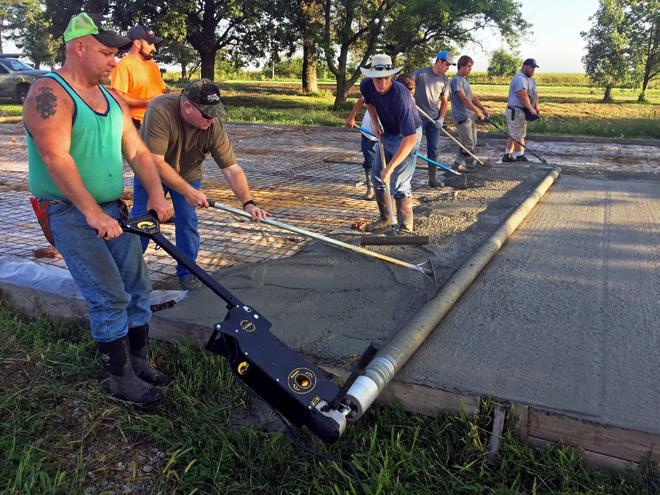
• 6-ft. trailing screed provides final finish to the surface with the GOMACOdesigned vibratory system
• Mounted to the C-450 truss system, which allows finishing of city streets, concrete floors, bridge decks, tunnels and canals at widths up to 104 ft.
Curb Roller Eel Screed 6100
The lightweight Eel Screed 6100 offers variable speed control for speeds from 0 rpm to 300 rpm and provides easy adjustment for different slump conditions or delivery rates. One-pin connection on the stainless-steel shaft and screed ends allows for fast setup. Insert screed ends into the SCH40 4-in. aluminum pipe and plug the system into a power source.
• Features a direct drive system, multiposition folding handle, all-steel housing and heavy-duty kickstand
It has a single button directional change
• Requires a 120-V, 60-Hz outlet/generator
E-Screed by Magic Screed from Allen Engineering
The E-Screed by Magic Screed has an electric-powered design with the same power and performance as the original. Its high-frequency screed vibration provides uniform distribution across the entire blade length, enhancing the structural integrity of the concrete through consolidation. The E-Screed comes with a harness that is designed to fit the operator comfortably. It’s equipped with a 1.5-hp 40-V lithium-ion battery engine and has vibration speeds up to 7,500 rpm. The screed’s consolidation depth is up to 6 in. The model comes with a battery unit backpack and it accepts the standard Magic Screed blades (4-ft. to 16-ft. widths).
Liebherr THP 80-LP Concrete City Pump
The THP 80-LP truck-mounted concrete city pump is designed for jobs in urban environments, residential jobs and compact jobsites where space is limited. The flexible boomless pump truck for line pumping application has a total length of around 28.4 ft. It is quick to set up and easy to control with an HBC option for the remote control.


The truck features storage with wide spaces for the concrete tubes and accessories on the deck and plastic water tanks for saving weight. The unit is mounted on a two-axle flatbed truck chassis and weighs around 22,684 lbs. The pumping kit features an open loop hydraulic circuit that is simple, reliable and powerful. A pumping kit option allows high-pressure application for extreme tasks.
Milwaukee Tool’s MX FUEL Concrete Vibrator


The MX FUEL Concrete Vibrator was designed to consolidate up to 45 yds3 on a single charge with a 2-in. head and 14-ft. shaft while eliminating cords and tripping hazards for a safer and more productive placement. The MX FUEL Concrete Vibrator increases productivity and safety on the jobsite by eliminating trip hazards and the need for cords and gas generators with its cordless innovation. The MX FUEL technology with built-in POWERSTATE Brushless Motor delivers the power to push a 2 1/2-in. head at over 10,000 vpm for optimal concrete consolidation. Accepts heads up to 2-1/2 in. and shafts up to 21 ft. long.
Epiroc V Cutter
With its V-shaped design, the latest drum cutter from Epiroc sets a new standard in trenching and quarrying. A simple and effective solution, it enables energy savings of up to 40%. Thanks to the V-shaped design that enables a cut with a flat base, no material is left untouched between the drums. Where a regular drum cutter must move side to side to create an even trench, an approach that causes extra wear on the carrier arm, the VC 2000 can reach the same result by just going straight. The distinguishing features of the classic Epiroc drum cutters, like the spur gears, adoptable high torque gear motor and the QuickSnap retaining system for fast and easy pick changing, are all to be found in the new VC 2000.
Wirtgen’s SP 20(i) Offset Concrete Paver

The production of concrete safety barriers with a height of up to 2 m and the paving of flat surfaces with widths of up to 2.5 m are typical applications for the SP 20(i) offset paver. With the machine, Wirtgen offers its customers the ideal combination of productivity and mobility. Despite the large paving widths and heights it offers, the machine has a low transport weight and compact dimensions.
Kipper Crete’s 11.5-FL & 34-in. Drill Extension Kipper Crete’s KPR-11.5-FL with a 34-in. universal extension adjusts up and down for easier use depending on the operator’s height. Its universal drive shaft allows the user to choose a variety of variable speed-controlled 1/2-in. drills. Kipper Crete’s 34-in. extension also doubles as an extension for drilling holes in floor joists and those overhead hard to reach places without a ladder.
Allen Engineering’s Riding Concrete Trowel

HDX615
Allen Engineering’s riding concrete trowel HDX615 is powered by Power Solutions International (PSI)’s 2.4-liter dual-fuel gasoline and propane engine. Backed by data and support from the Propane Education & Research Council, the dualpowered engine offers a path to a clean energy solution without compromising on performance or range. The PSI 2.4-liter engine provides up to 67.1 hp and 125.2 ft.-lbs. of torque.
August 2023 | EQUIPMENT TODAY 37 www.ForConstructionPros.com/Equipment CONCRETE Products Read More at https://eqtoday.co/Concrete0823
Multiquip’s Mayco LS300GK Small Concrete Pump
The Multiquip Mayco LS300GK compact, trailer-mounted concrete pump combines levels of performance with the build quality you would expect on larger pumps. Multiquip designed the LS300GK to be unique and distinct from other pumps with a 30-yard/hour output, handling up to 1-1/2-in. aggregate.

The LS300GK pumps different concrete mix designs and is ideal for slab work, block fill, shotcrete and more. The pump features a 10-cu.-ft. capacity hopper that is easily removed for maintenance and accessibility to wear components. Operators will appreciate the easy-toread, solid-state digital control panel and optional wireless remote control.
DICA SafetyTech Steel Dunnage System


DICA released an interlocking Dunnage system for the daily challenges concrete pump operators face. SafetyTech Steel Dunnage uses the properties of steel and DICA’s engineered thermoplastic material to promote stability and reduce ground bearing pressure.
The interlocking design consists of eight total parts that can be stored, deployed and retrieved by a single person. Available in two sizes, the 13.5-sq.-ft. SafetyTech Steel Dunnage system has a rated capacity of 60,000 lbs. and is designed for concrete pumps up to 49m. The 18.3-sq.-ft. system is rated for 110,000 lbs. and designed for concrete pump trucks up to 63 m. Both configurations are designed for outrigger floats up to 18 in. in diameter.

Curb Roller CM4600 Badger Curb Maker
The CM4600 Badger Curb Maker from Curb Roller Manufacturing is a batterypowered and lightweight machine that delivers uniform results for concrete pours. It’s designed to shape and finish curbs after another product screeds flatwork. The machine also supports user efficiency and reduces the need for extra equipment, transportation and labor. The machine features one-push directional change, right- or left-hand speed control, adjustable guide ring for uniform curbs, all-steel protective housing and interchangeable drums.
Husqvarna’s Ulti-Grit Flat Saw Diamond Blades
Husqvarna’s Ulti-Grit series of diamond blades is a completely new design using the latest advances in controlled diamond distribution. With this technology, Ulti-Grit blades have increased cutting speeds and longer blade life. The design of Ulti-Grit blades was made to better control the diamond distribution to leave fewer gaps. With more diamonds exposed for longer, the operator gets an outstanding flat saw experience. The blades feature optimal diamond distribution, elimination of uncovered spaces, less vibration during usage, increased speed, optimized power consumption and more.
Two Lavina Propane & Electric Power Trowels
Superabrasive’s LAVINA LP36GE propane model and LP30E electric model power trowels are designed for concrete polishing with free planetary drive and the proven Trowel Shine pan system. The LP36GE is a 6-ft./80-in. ride-on trowel, powered by Kohler PCV740, 24-hp propane engine. The LP30E is a 5-ft./61-in. ride-on power trowel, offered in 220-V and 380-V/480-V electric models.
With two 7.5-hp motors and 8-in. x 9-in. heads, it can get work done, fast. It is easy to transport and operate and fits through standard doors.
The LP36GE features:
• Updated and easier-to-use mechanical steering
• Pan system with 8-in. x 13-in. heads

• Integrated wheelset and a crank system for changing tools
• Heavy-duty shroud


• Transport wheel
THE CRUSHER BUCKET FOR YOUR EXCAVATOR
Jaw crusher for excavators. When installed on your excavator, it crushes any type of inert material.

MBW BullVibe Vibratory Bull Float
MBW announced the launch of the BullVibe vibratory bull float, which is designed for commercial concrete projects and construction. Generally, a contractor needs a vibratory bull float in emergency situations (concrete setting up too quickly, cold joints or a second ready mix truck not showing up on time).



In these scenarios, a vibratory energy is required to blend in the concrete and to bring the cream back up to the top of the slab. The product is powered by the M18 REDLITHIUM Milwaukee battery. Any Milwaukee M18 REDLITHIUM battery can be used, and using a smaller battery will not affect the performance. The BullVibe vibratory bull float is currently estimated for production in Q3 2023.

38 EQUIPMENT TODAY | August 2023 CONCRETE Products
FOR EXCAVATORS, BACKHOES, LOADERS AND SKID STEERS 4,5 - 100 ton
REDUCE >>
>>
REUSE
RECYCLE
BOOTH E853
Minnich A-1CL Dowel Pin Drill
The A-1CL dowel pin drill is an on-slab drill that offers horizontal, vertical and 35-degree stitch and skewed drilling positions. The drill is maneuverable but does not include a formal steering system. The term A-1CL refers to its light weight, 350 lbs. The A-1CL reaches a maximum drill depth of 18 in. with an under-collar drill steel length of 24-in.
The A-1CL requires 92.2 SCFM and 120 psig of pneumatic power. All specs correspond with the 48-in. model. Once available, the A-1CL will come in four drill widths, 48 in., 36 in., 30 in. and 24 in. The optional Minnich dust collection system can be mounted directly to all Minnich dowel drill units, including the A-1CL for reduced debris on the jobsite and in compliance with OSHA regulations. Concrete dowel pin drilling is an integral part of road construction projects. For these jobs, the dowel pin drilling component must move along safely and in a timely manner.
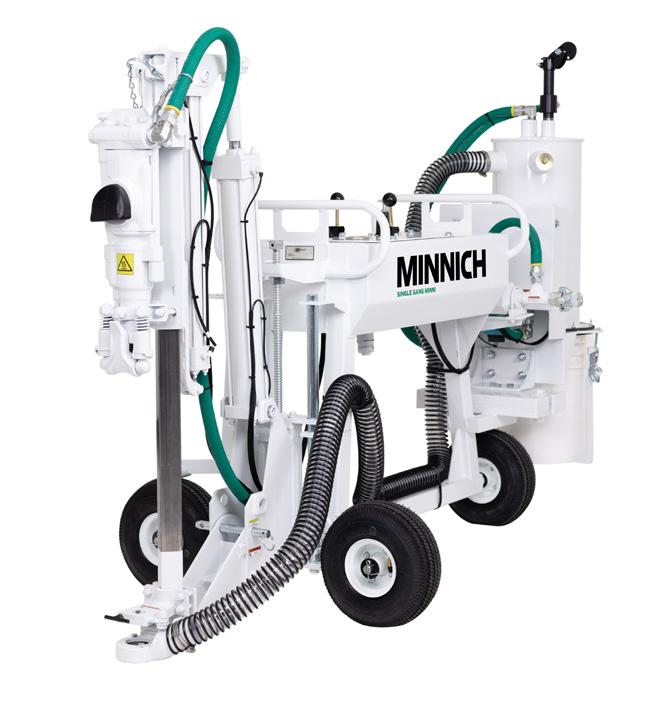
Ligchine’s SCREEDSAVER MAX PLUS E
Featuring a 100% lithium-ion electric power system, the SCREEDSAVER MAX PLUS E is equipped with EDRIVE, a 48V electrically driven hydraulic power unit. It features a built-in diagnostic touchscreen, SwingBoom pivoting frame, Topcon laser receivers and Ligchine Gen 2 wireless remote control system. Concrete contractors can now safely screed indoors and in climate-sensitive environments.
• Screed coverage: The MAX PLUS E offers 17 ft. (5.18 m) of boom extension with a 10-ft. high-performance screed head
• Electric motor system: 48V 3-Phase AC liquid-cooled electric motor
• Drive system: Two-wheel proportional drive with wireless remote control

SwingBoom pivoting frame: 12 degrees of total movement, with up to 5 ft. 3 in. of side-to-side screed head movement with a pivoting boom member
• Grade/slope/dual slope control: Topcon LS-B110 laser receivers (included)
• Ease of transport
Advanced Construction Robotics Rail-free Deployment for TyBOT
Advanced Construction Robotics announced a new deployment method for TyBOT. The new design, edge form bogies, eliminates the need for screed rail, a previous prerequisite for TyBOT. TyBOT traditionally relied on installed screed rail or a porta-rail system that simulates screed rail for deployment.

This requirement could be a limiting factor in locations where the screed rail was not readily available. The new bogies ride directly on the timber framing, called edge forms, that is erected on jobsites to support concrete pouring. TyBOT’s edge form bogies are adjustable, compatible with 2-in. x 4-in. to 2-in. x 8-in. edge form caps and can handle existing obstructions such as double-headed nails.
Brokk BHB 1300 Hydraulic Breaker Attachment
The Brokk BHB 1300 hydraulic breaker attachment is designed for concrete and asphalt demolition jobs. This versatile attachment has a 400-900 blow-per-minute rate applicable for breaking granite and similar types of rock or surfaces.


The BHB 1300 works with the Brokk 900 demolition robot. When paired, operators can complete demolition work in hard-to-reach areas of the jobsite, as well as tight spaces. It features hitting power of 2,800 Joules/Nm. Its weight is 2,756 lbs. and it has the capability of 400 blows/min to 900 blows/min.

Toro’s e2500 Electric Ultra Buggy
Toro’s 2500 Electric Ultra Buggy features a compact design, zero emissions, zeroturn-radius steering, full recharge in 8 hours with a 120V wall outlet and hauling capabilities of up to 2,500 lbs. of material. Featuring a narrow width of 31.5 in., the electric Ultra Buggy can fit through a 3-ft. door with a crash bar. Built to be versatile and agile, it’s equipped with a fold-up platform so operators can choose to stand on or walk behind the unit.
The fold-up platform serves a second purpose, as well, allowing the unit to fit inside elevators or on trailers for easy transport. The polyethylene tub has an increased thickness of 3/8 in., allowing operators to haul more than just concrete, and a steel tub is also available for applications that require it.
Somero’s Broom + Cure Machine

Somero’s Broom + Cure Machine takes the problem of manual-application in the bull floating, brooming and curing process and solves it with a machine application. Built on a hybrid of an S-15R (upper) and S-22EZ (lower) frame, the Broom + Cure Machine has the performance and power to tackle all paving jobs.
• 14-ft. proprietary broom, spray-bar head and bull float—precision-engineering to follow ACI curing guidelines

• Designed space for 55-gal. drums— integrated material-handling to keep spraying consistent and refills easy
• Dual sonic tracer—technology from the laser screed world to ensure accurate head height during the broom and cure process
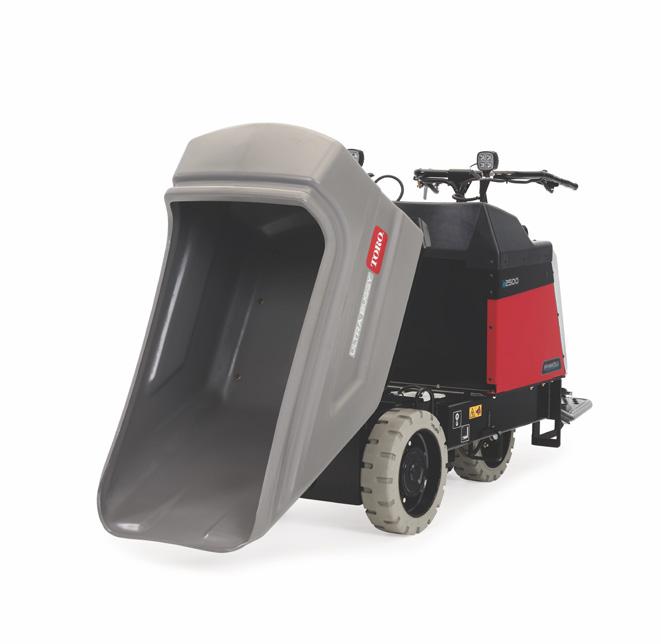
Somero’s proprietary soft landing and self-leveling system
• 16-gal. freshwater tank and hose— capacity to guarantee easy clean-up and maintenance
• Comes with a 1-year factory warranty
August 2023 | EQUIPMENT TODAY 39 www.ForConstructionPros.com/Equipment Products CONCRETE
job comes with a unique set of circumstances. But the two things all jobs have in common are concrete and deadlines. Which is why we’ve designed our drills to be the fastest, most accurate, operator-friendly machines on the market, keeping your crew safe and on pace for more jobs. No matter the deadline. MORE MILES. MORE DEADLINES MET. MORE JOBS. Designed to Beat Deadlines. ezdrill.com ©2022 E-Z Drill, Inc.
Every
How Tech Elevates Safety
Technology transformations improve safe operations on construction sites
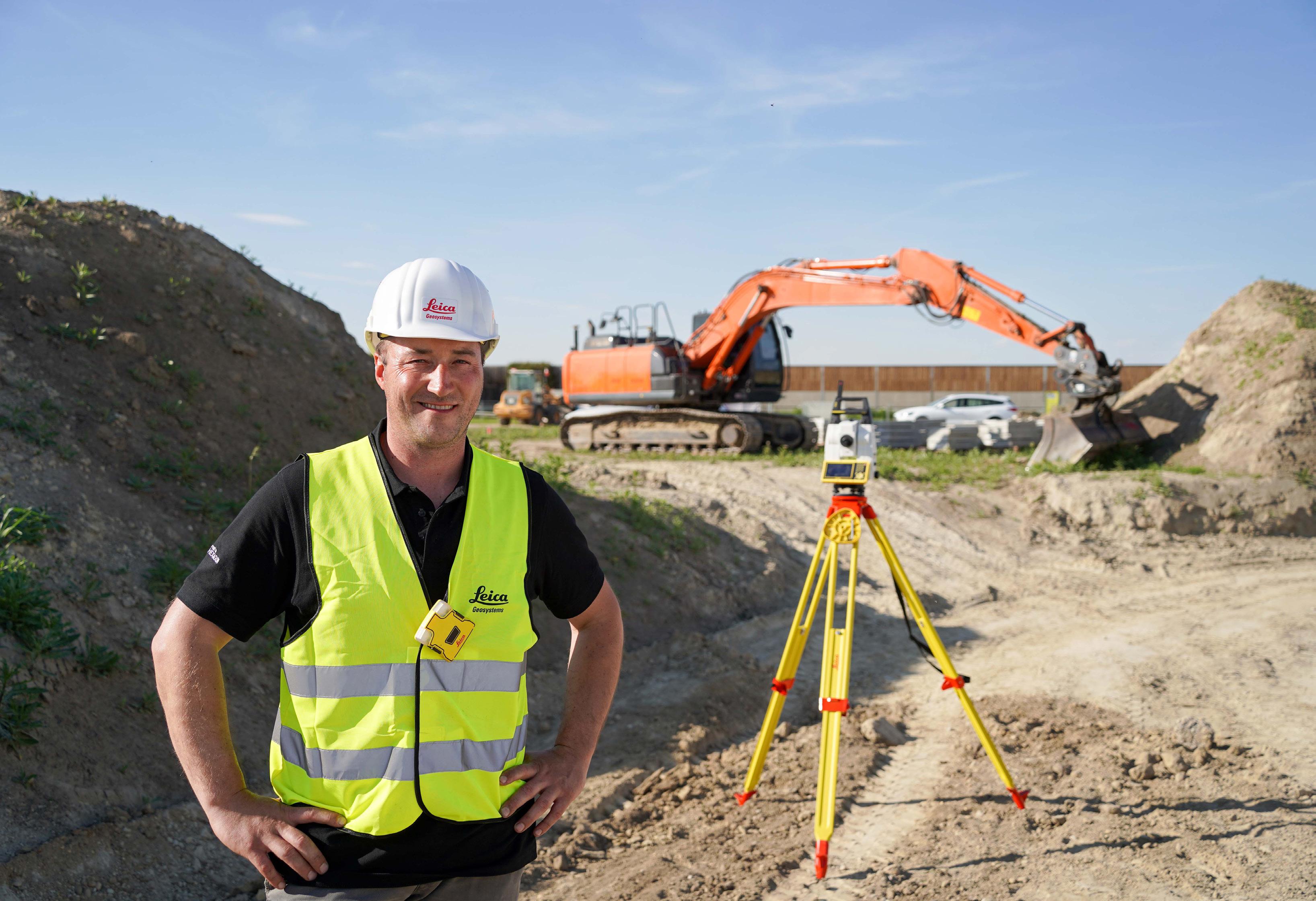
Safety on jobsites is the first thing that must be ensured on any project, but never more so than when heavy machinery and equipment are being used alongside workers on the ground. Because of this need, safety managers have increasing numbers of new tools to enhance their safety plans and help better protect employees. Advancements in sensors, radar systems, cameras and autonomous technologies improve risk detection capabilities and overall safety.
However, to develop a successful safety plan, managers must be able to identify where hazards are likely
to occur and how to overcome them. This data can be challenging to obtain without the correct digital infrastructure. Accidents and nearmisses provide key insights for safety planners to put in place effective risk management strategies, but they are rarely reported by workers, and the heavy machinery itself can only be made more accident-proof if the most likely causes of accidents are identified.
This is where technology transformations can elevate existing safety plans. Systems that alert workers to potential dangers, improve the ability of the heavy machinery operators to sense their surroundings and collect this data for later analysis have proven highly effective in improving safety on jobsites. Incorporating this into developing safety plans can be invaluable in preventing fatalities, serious injuries and near misses.
Making Technology Part of the Uniform Preventing accidents and near-miss incidents between heavy equipment
and workers has become a focus for technology companies working in the construction sector. The primary aim is always to reduce onsite incidents that not only have, first and foremost, a huge personal cost but also a financial and reputational business cost.
Accidents involving individuals and heavy equipment are the biggest threat to workers and can have devastating results despite the best efforts of manufacturers and safety managers. Equipment of this scale will always have a blind spot, and the best way to avoid this danger is to prevent people from entering these blind spots.
One solution to combat the blind-spot risk that could reduce these accidents is using a realtime awareness and alert system. This combines a sensor tag worn by workers on the ground which communicates with receivers installed in all the machines and vehicles on the construction site. This dual system provides machine-to-people awareness with direct notifications to the heavy machinery operators through visual
and audio alerts to notify them of potential risks within a configurable radius of up to 50 meters.
On the ground level, wearable tags also have a panic button that can be pushed if the wearer is in distress, alerting all machines in range that something is wrong and work as usual must stop. Systems can also be configured to indicate no-go zones on the jobsite to alert operators that their machine is nearing an area they should avoid, for example, because it is guaranteed that a lot of people will be in that space throughout the construction project. As an additional preventive measure, if physical obstacles are onsite, such as potholes or tree trunks, these can be programmed into the system, ensuring that personnel are alerted to their presence and can avoid them.
Harnessing Data for Future Safety
As well as minimizing immediate risk, technology transformations in construction also help managers improve safety in the long term by collecting the data generated by
40 EQUIPMENT TODAY | August 2023 www.ForConstructionPros.com/Equipment
One solution to combat the blindspot risk is using a real-time awareness and alert system. This combines a sensor tag worn by personnel on the ground which communicates with receivers installed in all the machines and vehicles onsite.
Hexagon
TECHNOLOGY
wearable tags and machine-mounted equipment. This can provide insights into incidents that go unreported, such as near misses, giving planners further opportunities to elevate their safety plan and improve their site’s safety culture.
With a logging system that can record long periods of movement, capturing position, speed, headings and alarms, this data provides a valuable snapshot into work behaviors and shows where the largest concentration of alarms are occurring on a site. This information may prompt procedural changes. All these data points can help companies evaluate and improve safety procedures.
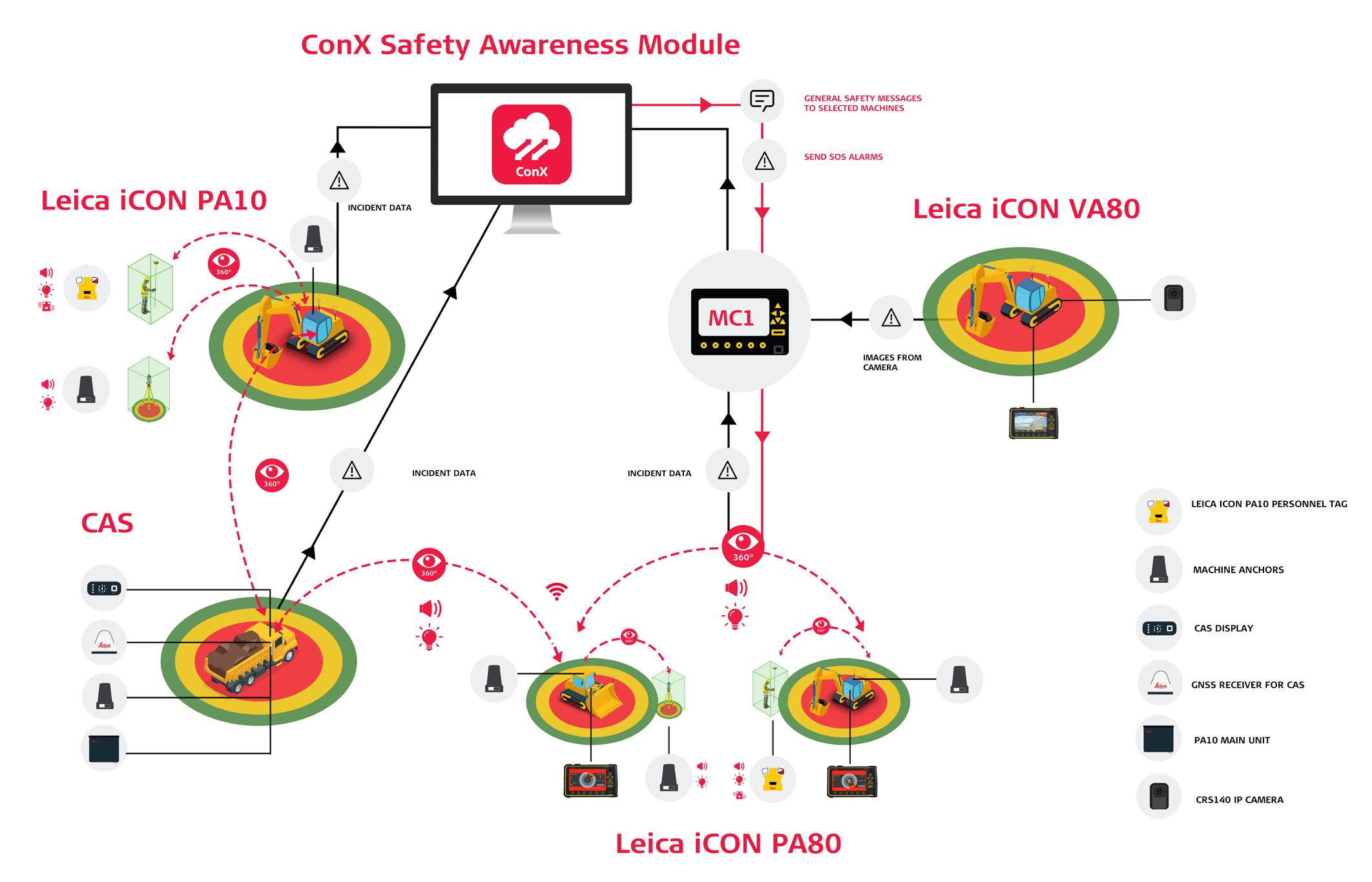
The benefits of this data collection are not only physical but also psychological. The knowledge that this information is being gathered may change staff behaviors for the better. For example, changed behaviors may increase the likelihood that near-miss incidents are reported because ground workers can be reassured that their reports will be backed up by the data.
The next step will be incorporating the data into machine control systems and creating web-based interfaces that allow better user interaction with the data generated and collected, such as producing heat maps from incident reports to further reduce the gap between data collected and data leveraged.
Combining Technology Solutions for Optimized Results
Typically, safety systems are either sensor- or camera-based. However, more technology companies are
combining systems and seeing significant benefits.
Cameras are commonly used on heavy-duty equipment because they offer increased visibility of a machine’s surroundings. However, they also require operators to watch the footage and the quality of their recordings is susceptible to lighting and weather conditions.

On the other hand, sensor-based systems can automatically monitor and alert personnel without the need for operator involvement and can function in any lighting conditions. So, by combining technologies, detection capabilities can be greatly enhanced, for example, by offering an image of machine surroundings and accurate calculations of the distance and speed of nearby objects. This is particularly useful in more dangerous situations such as deep excavations where visibility is significantly lowered. A sensor can be mounted to an excavator so that when the machine is digging, any persons in the excavation site are visible to the operator.
By partnering with other safety solution experts, collaboration between different technologies can take place for enhanced safety. For example, combining an alert system with dual-height sensor limitation, slew restriction systems, and height and rated capacity indication technologies can help prevent an excavator from lifting more than is allowed according to health and safety requirements or local legislation.
This dual integration adds an additional layer of safety to the alert system already provided. When a tagged ground worker or object is
within a pre-configured alert zone, the appropriate personnel are alerted and the slew restriction systems can proportionately and autonomously slow down and safely stop the machine in question, reducing further risk of an accident.
This combination of technology means that employees are more protected, and the heavy machinery itself is more “aware” of its surroundings and better equipped to overcome the major safety challenges on a construction site.
With autonomous technology such as this, it is essential that the machinery is as aware as possible of its surroundings to be able to work efficiently and safely.
Looking to the Future of Safety
With the rate of technological advancement increasing over the past decade, existing solutions to elevate jobsite safety will no doubt improve, and new solutions will continue to emerge. Companies are already working on incorporating augmented reality (AR) into their safety plans in a way that allows operators to see through machines to avoid collisions or running over any objects. Artificial intelligence (AI) will also play a significant part in advancing autonomous technology solutions, for example enabling autonomous machine driving powered by more reliable, human-equivalent reactions.
The possibilities presented by technology transformations in elevating safety are vast. These include introducing wearable tags, combining technology solutions, the nearfuture potential of AR and AI, and analyzing the data generated by these technologies. As the industry moves forward, technology will elevate safety by improving awareness and reactions of the individual, the machinery and the software.
Safety is the priority for any construction project, and understanding the cause of hazards is key to adopting the right solutions and reducing risk. The use of technology to protect workers immediately and capture valuable data to improve risk management planning for the future is critical for any organization to elevate its safety plan.
Read more at: https://eqtoday.co/SafeTech
August 2023 | EQUIPMENT TODAY 41 www.ForConstructionPros.com/Equipment
Brad Mullis is a product manager at Hexagon’s Machine Control Division.
This system alerts the operator of a potential collision with a worker on the ground.
Hexagon Hexagon TECHNOLOGY
A safety awareness system with combined technologies
Ajustco Anchor Thread for Fall Protection & Structural Applications


Ajustco’s Anchor Thread is a recessed castin-place concrete anchoring system for safety. With Anchor Thread’s cast-in-place design, no drilling or epoxy is involved in its installation. This reduces ladder time and ground silica dust exposure.

This system can be used for a wide range of applications, including but not limited to personal fall protection, cable rail leading edge protection, MEPS and architectural anchorage, for the structure’s life. The Anchor Thread can handle a maximum payload of 5,000 lbs. Ajustco offers an array of accessories and attachments that use sheer shoulder technology for various applications allowing for versatility.
STUDSON SHK-1 Full Brim Safety Helmet
The STUDSON SHK-1 Full-Brim safety helmet is designed to prevent traumatic brain injuries, featuring technologies to absorb impacts from fall-related injuries on jobsites. This safety helmet complies with American National Standards Institute Z89.1 Type I and II safety standards, meaning it is designed to reduce force as a result of impacts to the front, back, sides and top of the head.
The new SHK-1 Full-Brim safety helmet is designed in conjunction with existing safety technology from the SHK-1 helmet model, including Koroyd welded tube polymer for absorbing impact. The Koroyd material also supports heat dissipation and venting via its cellular structure.

RedTeam Automatic Drawing Hyperlinks
RedTeam Software announced its most recent improvement to the drawing management process in RedTeam Flex and Fieldlens by RedTeam: the addition of automatic drawing hyperlinks. Automatic hyperlinking functionality enables all project team members using drawings to access all information linked to project drawings, including other drawings, page links and related external web pages.
The automatic hyperlinks feature was developed to empower construction professionals to manage their drawings and related workflows. Previous updates include drawing markups and overlay comparison capabilities in all of RedTeam’s solutions. These features enable project stakeholders to upload, manage and annotate drawings.
DEVELON New Technologies for 7-Series Wheel Loaders
DEVELON introduced new technologies on its next-generation 7-Series wheel loaders in North America. Technologies including the Transparent Bucket, around view monitor camera system and object detection are offered as standard on all next-generation machines, from the DL200-7 through the DL580-7.
Transparent Bucket technology helps minimize blind spots for wheel loader operators when the bucket is raised. With an unobstructed view in front of the wheel loader bucket, operators can see objects such as large rocks, construction materials, obstacles and people in front of the machine—objects that would otherwise be obstructed from view by the bucket.
KNIPEX Tools App
KNIPEX Tools launched a new mobile app with product search and augmented reality features. The app is designed to help construction professionals discover product information about the Germanybased manufacturer’s hand tools or to find the right tool for a specific application— whether on the jobsite or on the road.
The new app’s goal is to bring the world of KNIPEX into the pocket of workers and customers. With more than 1,300 tools in the product assortment, the product search functionality allows users to find an item by searching for the keyword or part number. The KNIPEXplorer product finder is a new resource for pipe cutting and crimping.

Trackunit Marketplace for Accessing Data Feeds

Trackunit unveiled Marketplace, the doorway to the extendable Iris platform, which supports the data-feed experience of fleet owners. Marketplace will allow mixed-fleet owners to access aggregated data sources that have been harmonized and standardized. This will allow them to streamline their internal business processes with downtime implications, freeing up resources for other things.
Marketplace is being introduced to the market in several phases. It will later this year enable Works With Trackunit partners and external developers to build market-facing apps or data connectors for customers leveraging Iris’s data-led insights engine.
Developers will be able to build services and applications in a secure environment.
811spotter Mobile App
811spotter announced the general availability release of its iOS and Android app. The app gives construction field teams access to data and documentation capabilities via a map-based interface, enabling contractors to work safely in challenging environments.

The 811spotter platform supports the process of managing 811 tickets to help contractors manage excavation projects and avoid damage to underground pipelines, cables and other pre-existing infrastructure. Field teams can also collect supplementary data about utilities and other infrastructure while in the field, adding geotagged photos, notes and location information to support information provided by the regional 811 center and support safety for future field teams working in the same area.
ISOtunes ULTRACOMM Aware Bluetooth Earbuds
ISOtunes announced the launch of ULTRACOMM Aware, a Bluetooth-enabled, level-dependent hearing protector that supports situational awareness and provides face-to-face communication without earbud removal.

The new ULTRACOMM Aware is designed for those who work in regulated loud environments and need hearing protection that maintains situational awareness and allows for communication. ISOtunes’ Aware Technology allows users to hear the world around them while blocking damaging noises above 85 decibels.
A true wireless design, ULTRACOMM Aware comes with a pre-attached boom mic to provide clear audio for phone calls and is interchangeable between either earbud. The mic’s ear hooks keep earbuds in place during use.
42 EQUIPMENT TODAY | August 2023 www.ForConstructionPros.com/Equipment TECHNOLOGY Products Read More at https://eqtoday.co/fleetmgmt
 By Charles Rathmann, Senior Editor,
By Charles Rathmann, Senior Editor,
GRADE CONTROL’S Increasing Power Drives Adoption by Diverse Contractors
A quick overview of how grade control, already indispensable to heavy and civil contractors, is evolving for additional use cases and construction disciplines.
With many public project owners including a hard requirement for grade control in their request for proposals or contract language, it is no wonder the industry is going through rapid adoption of technologies to control screeds, blades and buckets to deliver specific results using global navigation satellite system (GNSS), geographic information system (GIS) or laser technology.
Grade control may be a fixture in dedicated excavation and sitework contractors where earthmoving is a central discipline, but it is also entering lighter equipment and more diverse use cases. Meanwhile, grade control technology vendors continue to up their game, making an already proven and trusted technology even more suitable for different contractors.
FACTORY OR AFTERMARKET
Multiple vendors offer grade control that can be added to equipment after the sale—at purchase or at points in the equipment lifecycle. Some components of these aftermarket systems can be moved from one machine to another, making then wellsuited to contractors who may rely on rentals for some of their production work or need to extend a smaller number of grade control tools across a larger number of pieces of equipment.
On a recent “Contractor’s Best Friend” podcast, experts from
Caterpillar however made the case for equipment with 3D grade control installed at the factory by the original equipment manufacturer (OEM).
“When you think of the old blade mounted systems—the masts, the cables, everything were exposed to the elements in an industry that is known for tearing things up,” Caterpillar Senior Market Professional for Construction Lonnie Fritz said. “The factory integration has been a real pivotal point in Caterpillar bringing those solutions right off the factory line, most recently with the motor grader, putting those antennas on the neck of the motor grader and the cab, getting rid of the mast, getting rid of the cables.”
Integrating 3D grade control more tightly with equipment may also improve safety, according to Fritz.
“What is the last machine to stop working when the rain comes—usually it is the dozer,” Fritz said. “Too often, we have the muddy boots trying to go out there on those masts and remove those antennas.”
Whether 3D grade control is from the factory or a third-party supplier, the technology’s ability to make operators more productive with less training and experience is attractive.
“Back in the day, you would start as a laborer on a shovel, lowering pipe into a trench,” Caterpillar Dozer and Excavator Specialist Sam Meeker said on the Contractor’s Best Friend podcast. “Unfortunately, today it
just doesn’t work that way. There is a struggle to get operators—you are getting guys that want to work and gals that want to work, but they don’t understand grade or how to get that machine to lay that grade down. So we need this 3D grade control technology to take that brand new operator and make them able to spread that material out to within a tenth of an inch by the end of the week.”
GRADE CONTROL INNOVATION
During the last year, indicate-only systems, which give the operator visual feedback to help them dig to plan, are proliferating. Offerings for excavators from entrepreneurial vendors like Unicontrol are being met by offerings from established aftermarket equipment automation vendors like Trimble. Siteworks Machine Guidance, a new offering from Trimble, will provide indicator-only machine guidance while providing an upgrade pathway to full 3D automation. This would be similar to CAT Grade with 2D and extends technology to contractors reticent to pay for full automation while helping them avoid a solution that cannot move forward with them.
Trimble leads the market in terms of integrated steering control that more fully automates the operation of many classes of earthmoving and compaction equipment but may be unique among major players in

making a push down into machine guidance.
Tommi Kauppinen, vice president of technology at Leica Geosystems’ Machine Control division, caught up ForConstructionPros.com on the innovation from his group. Leica Geosystems has been rapidly adding new capabilities to its offering, including a new machine control product for smaller excavators and an on-cab solution for dozers with support for six-way blade systems.
“This advanced technology gives operators the ability to gain precise control over the full range of movement of a six-way blade attachment, enabling them to enhance maneuverability and achieve optimal grading results,” Kauppinen said. “We also implemented a Modified Model feature that incorporates surface logging capabilities which provides real-time monitoring and analysis of terrain, giving operators crucial data on ground conditions. The surface logging feature allows the system to create a detailed model of the terrain, indicating areas where material has been excavated or deposited—perfect for dredging or other projects where accurate monitoring of material movement is essential. By utilizing this information, operators or project planners can optimize their excavation and grading.”
Leica has also pushed its product onto lighter equipment, making it an option for more contractors.
44 EQUIPMENT TODAY | August 2023 www.ForConstructionPros.com/Equipment PROFIT MATTERS |
Construction
IRONPROS
Technology,
Excavators and other equipment with machine control are becoming a common sight on more types and sizes of projects.
“Our iCON Site Excavator solution is an all-inclusive excavator system built upon our user-friendly iCON Site Construction Surveyor software package,” Kauppinen said. “This cutting-edge solution is specifically tailored to meet the requirements of smaller contractors, providing them with an affordable and intuitive machine control solution … One of its key features is the ability to generate design data directly in the field, using measured data acquired through the same solution utilized on a rover pole. This ensures seamless integration of field operations and
enables contractors to make informed decisions on-site, resulting in improved efficiency and accuracy.”
Caterpillar, too, has been moving towards more automation on smaller excavators rather than less.
“The big advancement would be the automatics,” Caterpillar Market Professional for Machine Control and Guidance Scott Hagemann said. “We had indicate-only on excavators. The automatics have really upped the game. Without the automatics, it was only as good as your operator. We can take the operator and make him better and incrementally help him, or if he
is a new operator, help them become more productive faster.”
Caterpillar is also pairing grade control with other features to control not the end effector like a blade or bucket, but the direction the equipment is traveling in.
As feature we just released on the tracker is steer assist,” Hagemann said, stressing that the solution requires no GPS base station. “You select an alignment line, determine your left blade tip or right blade tip, and the machine not only grades automationwise, but turns to the blade stays on that alignment line.”
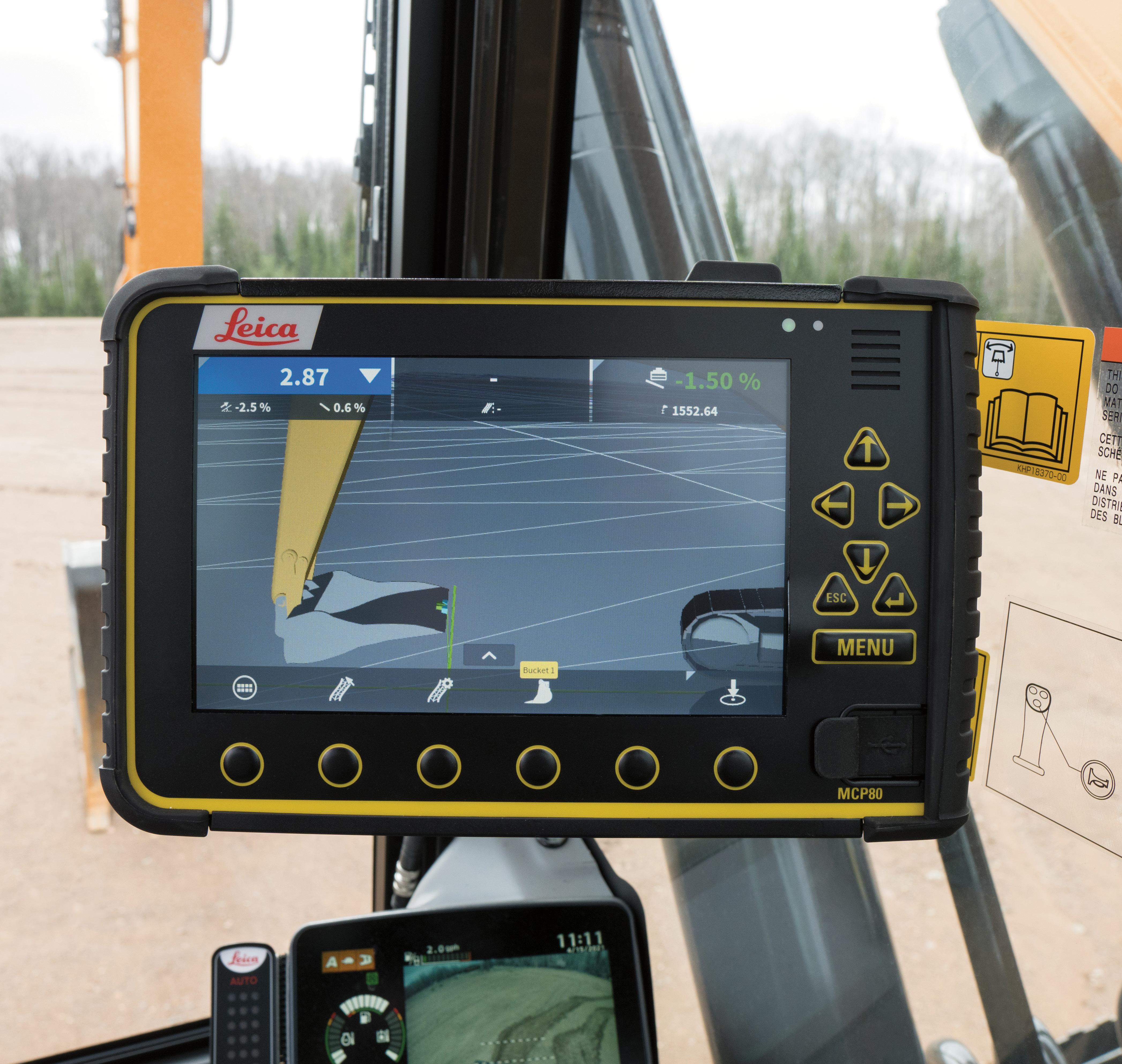
This is particularly helpful when preparing an urban cross section with curb and gutter because there is a good, consistent line with plenty of room for the slip forming machine.
Caterpillar has also worked to simplify 3D operation of motor graders by removing the mast from the blade.
“Without the mast on the blade, you can put the blade physically in places we never could before,” Hagemann said. “At CONEXPO, some did not realize it had a GNSS antennae on it—it is located on a gooseneck on the cab. In a high bank position, this allows an operator to rotate the blade
August 2023 | EQUIPMENT TODAY 45 www.ForConstructionPros.com/Equipment
CASE Construction Equipment
up underneath a side slope, without the mast getting in the way.”
Other features augment Caterpillar’s grade control offering, simplifying operation even more. These include tools like e-Fence, which can be configure to stop a blade or bucket from hitting things like a tire, a wall or other obstruction—and E-Swing, which prevents a boom from colliding with adjacent objects for easy operation in tight quarters.
“If you are digging and have traffic running next to you, it will physically
stop before it swings in that direction,” Hagemann said. “Our systems detect people, but also other objects—smart cameras are looking at what is around them.”
CASE SOLUTIONS CONFIGURABLE
CASE’s OEM-Fit 2D and 3D semiauto excavation systems are designed by Leica Geosystems and available on D Series and E Series full-size excavators. The system automatically controls boom, bucket, tilt and tilt
rotator bucket movements to automate digging to plan.
“The operator can select auto boom control, auto bucket control, auto tilt control and auto rotation control—or any combination of all of them—to finish the job,” CASE Construction Equipment Site Solutions & Telematics Sales Manager Bob Flynn said.
To this, CASE adds its mastless system that controls all blade movements—up, down, tilt, pitch, and the swing or rake—and handles all
calculations to ensure that operators hit the right grade.
“Finally, we enhanced our GPS components, providing a cleaner, easier-to-use design, along with rover poles,” Flynn said. “It used to be when you held rover poles for positioning that they had to be perfectly up and down to take the shot. Now the pole could be leaning, and through calculations, you can still achieve an accurate reading to that point. Obviously not needing to hold the rover pole exactly perpendicular helps
NOT JUST FOR EARTHWORKS CONTRACTORS ANYMORE
Construction equipment machine control vendors are making their products more affordable and accessible, and based on anecdotal accounts from contractors, are finding rapid adoption in light commercial and residential settings.
New entrants in the market have sought to shave cost and complexity off of machine control by offering machine guidance solutions that provide an indication of where to dig based on a model but no blade or bucket control—akin go CAT Grade with 2D but as an aftermarket solution. Not to be outflanked, a new offering from Trimble delivers a similar minimalist approach, but also offers contractors a path to step up to a more fully featured Trimble automation solution.
“This is machine guidance, and we are not automating the operation of the machine but are offering visual indicators for the operator,” Trimble Civil Construction Product Manager Jack Young said on the launch of the product at CONEXPO-CON/AGG 2023. “But not only can the contractor continue to use this system after upgrading into our automation solution, but we are offering a stepping stone into the more advanced technology. It is extremely buildable and very good. So it is not a dead end.”
Tommi Kauppinen, Vice President of Technology at Leica Geosystems’ Machine Control Division, suggested his group, which is part of Hexagon, had focused on enabling adoption not just by launching products aimed at a broader market but by helping contractors assault the learning curve.
“We’ve invested in how-to videos that focus on the functional aspects of our features and a new, state-of-the-art training facility at our headquarters in Denmark,” Kauppinen said. “This facility is dedicated to facilitating on-machine training, allowing our users to
gain hands-on experience with our solutions. By providing immersive and practical training sessions, we aim to equip our customers with the skills necessary to optimize their utilization of our products in real-world scenarios. We have also simplified our software, making it even more user-friendly. We understand that ease of use is paramount for our customers, and our team of experts has worked to refine the interface and streamline the user experience.”
WHAT CONTRACTORS SAY ABOUT GRADE CONTROL
Efforts to make grade control affordable and accessible to diverse types of contractors seems to be working, according to accounts. Will Copp, principal of Knox Concrete Contractors, a commercial contractor with locations in Knoxville, Tenn., swears by the technology.
“I have found that using grade control on equipment is an absolute game changer in the construction industry,” Knox said. “The technology has revolutionized the way we approach projects by providing accurate and efficient grading solutions. By utilizing sensors and GPS systems, our machines are able to determine their exact location and adjust accordingly to match the desired slope or elevation of the project site. This not only saves time but also reduces material waste and ensures precise results. “In addition, grade control allows us to work in challenging terrain with ease while maintaining high levels of productivity. Overall, incorporating this technology into our workflow has greatly improved our efficiency and accuracy on all types of construction projects.” “I’ve found that using grade control technology is an essential tool for achieving accurate and efficient results,”
Austin Iron Fences Co-Owner John
Ward said. The Austin, Texas-based contractor complete security projects including technology-enabled gates and fences. “With the help of advanced sensors and GPS systems, contractors can now monitor and adjust their machinery’s position in real-time to ensure they are working at the exact level required by the project specifications. This not only improves accuracy but also increases productivity by reducing the need for manual adjustments or rework. The feature allows us to work smarter, not harder, saving time, money and minimizing errors. Whether we’re grading land for a new construction site or laying down asphalt on a highway project, grade control technology has become an invaluable asset in improving our workflow efficiency and delivering high-quality results to our clients every time.”
In Seattle, meanwhile, SEA Concrete Contractors co-owner Daniel Sarrero relies on grade control to execute residential and commercial concrete jobs ranging from concrete slab foundations, driveways, patios, sidewalks and more around the Seattle area.
“As a contractor who utilizes grade control technology on my equipment, I am constantly impressed by the precision and accuracy it offers,” Sarrero said. “This innovative tool allows me to ensure that every aspect of a project is completed with the utmost attention to detail, from grading roads and excavation sites to laying foundations for buildings. The keyword plays a crucial role in this process as it enables me to set specific parameters for each job, ensuring that my machines operate within precise boundaries. With just a few clicks on my computer or mobile device, I can program my equipment to achieve millimeter-level accuracy— an impossible feat without this advanced technology. It saves time and increases efficiency on projects.”
Contractors working in a number
of disciplines—even security contractors, are finding grade control an attractive investment, perhaps because operators are spending a smaller fraction of their time on the machine and become more efficient than a more experience and dedicated operating engineer.
“I’ve found that using grade control technology is an essential tool for achieving accurate and efficient results,” Austin Iron Fences Co-Owner John Ward said. The Austin, Texasbased contractor complete security projects including technologyenabled gates and fences. “With the help of advanced sensors and GPS systems, contractors can now monitor and adjust their machinery’s position in real-time to ensure they are working at the exact level required by the project specifications. This not only improves accuracy but also increases productivity by reducing the need for manual adjustments or rework. The feature allows us to work smarter, not harder, saving time, money and minimizing errors. Whether we’re grading land for a new construction site or laying down asphalt on a highway project, grade control technology has become an invaluable asset in improving our workflow efficiency and delivering high-quality results to our clients every time.”
GRADE CONTROL EVOLUTION
Even as the technology has become indispensable, vendors are not sitting still and continue to invest in adding value to the products. Grade control is, for instance, being augmented by horizontal steering control for the machine itself. It is also a popular option on widely-used equipment classes like compact skid steers and compact track loaders.
PROFIT MATTERS 46 EQUIPMENT TODAY | August 2023 www.ForConstructionPros.com/Equipment
speed up the surveying process so you can get to moving dirt faster.”
GRADE CONTROL ROI
While the financial case for grade control is strong, an executive may want more than generalities before making investments.
Determining a precise return on investment (ROI) for grade control can be tricky because it depends in part on the baseline skill sets available within a contracting business.
“We do productivity studies on our machines,” Hagemann said. “A productivity study on grade control is kind of judgmental because it is all based on how inefficient your customer is to begin with. It is also a process change. This is not just pressing the easy button—you need to change the process of a job. You are not calling a surveyor for grade stakes—you are calling the data processing person for plan data. But the data guy is much cheaper than the surveyor. The surveyor’s timing is based on weather and daylight.”
Based on these factors, Hagemann said contractors could expect a 30% increase in productivity.
CASE, too, works with customers to determine the grade control ROI.
“Our precision team has access to ROI calculators where we can enter the customer’s average expenses like materials, fuel and labor costs to calculate how long it will take for the system to pay itself off,” Flynn said.
Leica’s Kauppinen, meanwhile, suggested that their ROI strategy also took into consideration the broader lifecycle of model, productivity and operating data.
“We have created an ecosystem of interconnected machine, surveyor and office solutions that seamlessly integrate with our cloud platform and work together—providing a smooth and efficient flow of data across all stages of a customer’s construction project,” Kauppinen said.

RAPID ADOPTION
The need for the use of 3D grade control, increased productivity per operator and lowered barriers to entry augmenting the strong ROI case is driving more contractors to make the leap to grade control. This adoption is extending well beyond heavy, highway and civil sector and into commercial and residential contracting.
“Across the board, we’re seeing increased interest and adoption,” Flynn said. “Part of that is technology being more accessible and part is that it’s more affordable.”

“When the technology was first launched, and we’ve been in it since 2004 with Caterpillar, it always seemed to be focused on a finished grade application,” Hagemann said.
“Now, we’re realizing though, even
if you need to cut 10 feet to 15 feet, it will still benefit you. It is not just for road jobs. People are out enjoying automatics on our 395 excavator with grade control. Even if you are loading a truck, it is easy to over-dig 1 feet to 2 feet. It is all over the jobsites. Once you start getting used to it, you realize you need it.”
Innovations from the vendors
themselves may be driving grade control technology into smaller and more varied types of contractors.
“The iCON Site Excavator is gaining significant traction among smaller businesses due to its userfriendly nature, allowing users to effortlessly generate their own data directly within the system,” Kauppinen said. “This capability
empowers smaller contractors to work more efficiently and effectively. In parallel, larger contractors are increasingly recognizing the value of comprehensive data to measure key performance indicators.”
Read more at: https://eqtoday.co/PMGradeControl
PROFIT MATTERS
Valuing & Selling for Larger Contractors
How companies with more than 25 employees should plan for the future.
Last month’s column reviewed how to improve business growth and company value, especially for owners close to retirement or a sale. The column was directed at companies with 10 to 20 employees. This month, I review the market for larger contractors with 25 or more employees, being paid in the “union” range, working for a firm with an earnings before interest, taxes, depreciation and amortization (EBITDA) number close to $5 million or more. If you fall under this umbrella, we have something to work with.
Before the financial discussion, note that all the comments regarding marketing and proficiency also apply to larger companies. If you have formal programs to attract business and track performance with the ability to demonstrate how these programs have performed, you are in a much better position to “sell.”
I have worked in this segment. When employee stock ownership plan (ESOP) transactions resurfaced, that was even more fun. But we are in a funky mergers and acquisitions (M&A) market right now. We also have higher interest rates, which reduce company value because the rate increases absorb more cash than they used to. Add in the numbers associated with inflation and supply chain issues, and you wind up with having to supply data that spells out what you do, how you do it and how it compares to industry metrics. In addition, historical and projected financial reports need to demonstrate that future cash flows will cover any acquisition debt generated.
To better understand this, I called Nathan Perkins, managing director, ESOPs, for FMI Capital Advisors. Nathan does M&A work with a specialty in ESOPs. We have worked together on some deals. I wanted to get a feel for the current M&A market. Nathan said basic M&A is soft but that he was working on several ESOP transactions. When I probed further, I was surprised to find out that much
of his work lately is with contractors. I educated Nathan about what I was doing currently and asked him to talk with me.
Let’s assume a contractor has a company that meets the suggestion of more than 25 employees and a $5-million EBITDA number. And this contractor may want to sell out or buy a competitor. Or it may be time to clean house and make some technological changes that will hopefully improve the company’s valuation and cash flow.
In each case, I suggest compiling historical (normalized) financial results for the last five years, as well as a five-year projection based on a set of supportable assumptions. This may sound like a lot of work, and it is. However, the results help you understand your business from areas that are above average to areas that need work.
If you decide to move ahead with a sale, a person like Nathan would provide you with examples of a reporting format and the support documents required. He would then dive into every line item in your reports and question you about the results and supporting documents. Together, you would compile a data set fit for insertion into an offering
memorandum for potential buyers and loan officers. Obviously, if you are selling, the potential buyers are reading the memorandum, and as a potential buyer, you read it to see if there is any further interest.
ESOPs add a lot to both sides of the equation. Your company can establish an ESOP and sell between 30% to 100% of the company. If you have an ESOP, you can purchase other companies, getting substantial tax benefits. If the owner wants to monetize the investment, the ESOP could buy a portion of the company and receive tax benefits. The seller has the potential of paying zero taxes on the sale.
The bottom line is that ESOPs provide tax benefits to the seller and reduce taxes paid by the ESOP (if any). In addition, ESOPs help you attract new employees and retain the ones you have since the employees have an ownership interest that could produce a substantial payout in the future.
If you plan to sell outright or use an ESOP, a lot of work is required, and costs are involved. One other option is an employee or management buy-out where a portion of the agreed-upon value is paid at close, and the balance paid out on a note or an annual earnout. These types of transactions are

popular, but with current interest rates and pandemic supply chain issues, it may be tough to get the bank to buy in to fund the transaction. And as I mention every month, try to outsource a lot of the financial analysis, use a format that you would need to use for an ESOP, and then get a tax review to determine the tax obligations/benefits being created. From there, the board decides how they wish to proceed.
This issue is more complicated than I can cover in this column. But the ESOP process works if you have the cash flow to cover debt service. Reducing the tax liability does help with cash flow.
Nathan can summarize the ESOP in more detail. With his experience with contractors, he can suggest the problem areas lurking out there. Connect with Nathan using the information below:
Nathan Perkins, managing director, ESOPs, FMI Capital Advisors; 202-4807720, nathan.perkins@fmicorp.com
Read more at:
https://eqtoday.co/RunBus0823
48 EQUIPMENT TODAY | August 2023 www.ForConstructionPros.com/Equipment RUNNING THE BUSINESS
Garry Bartecki is a managing member of GB Financial Services LLP and a consultant to the Independent Equipment Dealers Association.
Panumas, Adobe Stock
How Technology Will Deliver The Modular Construction Revolution
Gain Access to a Three Part Series, Including:
• Part 1: Why Contractors Need to Get Serious about Offsite Construction
• Part 2: The Rise of Software for Offsite Construction




• Part 3: Offsight Builds Out ERP for Modular, Panelization and Volumetric Construction
To Read the Full Report, Visit: IRONPROS.COM
ALTERNATIVE Employee Incentives
It’s easy to look at the way things are and imagine that they have always been this way or mostly been this way. Things change at such a gradual rate, it can be difficult to really pinpoint paradigm altering events while we are living through them. Take for instance the current presentation of employment-based benefits and how they’re structured.
Consider whether this sounds familiar? During World War II, the war effort decimated the traditional labor force in America. The competition for workers led to a rise in wages, and, ultimately, creeping inflation. This is the era when the iconic “Rosie the Riveter” emerged, and many women started working for the first time. Despite this, there weren’t enough new workers to compensate for the war, and inflation kept getting worse.
Then, in 1942, the Stabilization Act was passed.
The legislation limited the ability of employers to freely increase wages in the competition for available workers, and the result was an early iteration of employment-based benefits packages that we all are so familiar with today. By 1943, the practice was commonplace. It was an effective way for companies to lure new workers, and here we are today, where 78% of health coverage plans are employer sponsored.
In today’s world, every sector of the
economy has felt the impacts of the COVID-19 pandemic, and the dearth of skilled, available laborers. Wages have increased slightly. However, they have not kept pace with inflation. Every company is asking the same questions. How can we find and hire new quality employees? How can we better retain the employees we have? How do we differentiate our business from competitors? There is no shortage of experts weighing in on these topics, and one possible solution to consider is employee ownership structures.
Common sense might give pause to this idea, especially for small, local business owners, companies with a fewer number of employees. However, small businesses can share ownership interests with their workers in many ways, which can also benefit the company in the process.
In an era where retention and attraction of quality workers is so challenging, the concept of converting to an employee owned company is worth exploring.
In the wake of the COVID19 pandemic, Rutgers University conducted a study comparing companies with majority employee ownership models versus companies with no such structure in place. The survey aimed to distinguish how the two groups fared under the stress of the pandemic and its aftermath.
After reviewing it along with two other previous, pre-pandemic studies, the results showed that in employee owned businesses:
˜ Job loss at a rate of less than 25% of non-employee-owned firms.
˜ A third (35.5%) of the cut hours for one or more employees; compared to nearly two thirds (62.9%) in nonemployee owned businesses.
˜ A quarter (26.9%) of employee pay cuts, compared to more than half (57.3%) of other firms.
˜ For every person who lost a job, nearly three people lost their jobs at companies that were not majority employee owned.
˜ Experienced an increase of 2 percentage points in sales, employment and productivity growth over the same 5-year period.
˜ Across all industries had an average profit margin that was almost 8.5% higher than the average private firm.

˜ Demonstrate higher than average employment growth, faster postrecession growth and reduced turnover rates.
In the summary of the Rutgers study, it stated that the key finding, “Indicates policies that encourage more employee owned firms will provide a future hedge against job loss in economic crisis, thereby reducing the volatility and durability of a negative economic cycle.”
Some businesses, for different reasons, may not be able to convert to an employee ownership structure. No solution is one-size-fits-all. However, exploring it as a way for generating an increase in employee engagement and commitment can only be a good thing for both businesses and personnel.

When workers are also directly sharing in the businesses success, they feel more connected to the way their labor generates profits. They feel more connected to the quality of the work they do, and the relationship the company has to its customers.
In the ongoing labor force shortage battle, even small to medium-sized businesses should take a look.
Read more at: https://eqtoday.co/AlternativeBenefits
50 EQUIPMENT TODAY | August 2023 www.ForConstructionPros.com/Equipment BRIDGING THE
|
Pavement
&
GAP
by Brandon Noel, Editor,
Maintenance
Reconstruction
For smaller corporations and LLCs, those with relatively fewer employees, incentives like employee ownership can improve retention and engagement.
• Trailer Weight: 8,380 lbs. • Overall Width: 102", Length: 31'4"

• Deck Length: 21’ Flat (model shown)
• 6’ Beavertail
• Deck Height: 34"
• Tires: Eight 215/75R17.5 (H)


• Brakes: Air (Full ABS System)
• Ramps: 72" Long x 22” Wide Range: 102" Max. 29" Min.
• Lighting: 100% Sealed Wiring harness and L.E.D. Lights
Standard Features On All Easy Loaders
Simple,Fast,andConvenient! ONE PIECE CAST LUNETTE EYE Tested @ 275,000# and wrap around nose plate. Standard on all trailers. HEAVY DUTY 2-SPEED PARKING JACK 70,000# static capacity. Standard on all 15-25 Ton trailers. HIGH TENSILE MAIN RAIL One piece and cold formed. CROSS MEMBERS pierced through Main Beam for lowest possible deck height and more unitized frame. ALL WHEEL ABS with Spring Brakes on all axles. Standard on all air brake trailers. ADJUSTABLE 3-LEAF SUSPENSION Standard on all 15-25 Ton trailers. SUMITOMO BRAND TIRES National Dealer Supported. HUB PILOTED WHEELS Outboard brake drums for easier maintenance. APITONG/COMPOSITE DECK Durable Composite Decking is fastened to the crossmembers with bolts and deck washers making it easier to replace decking when required. Eager Beaver WIDE TRACK AXLES: 98” Some Competition - 92” 98” WIDTH 92” WIDTH >> Eage rBeaverTrailers.co m
on
800-257-8163
For a quote
any model, please call
ANNIVERSARY 1946-2022 th 76 6 20XPT • CAPACITY: 40,000 lbs. • 20 Ton Air Brakes • 8 Degree Loading Angle Low Profile
MINIMIZE PASSES, GUESSWORK, AND HEADACHES.




NEVER IDLE
It’s all about doing more with less. So we did, with the widest range of machines equipped with grade management tech to suit your job needs today, and tomorrow. From 2D Laser Control to fully-integrated SmartGrade™, it allows any operator to grade with precision. Reducing passes, labor costs, and dreaded rework, to boost your bottom line.




DEERE.COM/SMARTERTOOLS
333G 2D LASER CONTROL











































































































































































 By Charles Rathmann, Senior Editor,
By Charles Rathmann, Senior Editor,
















